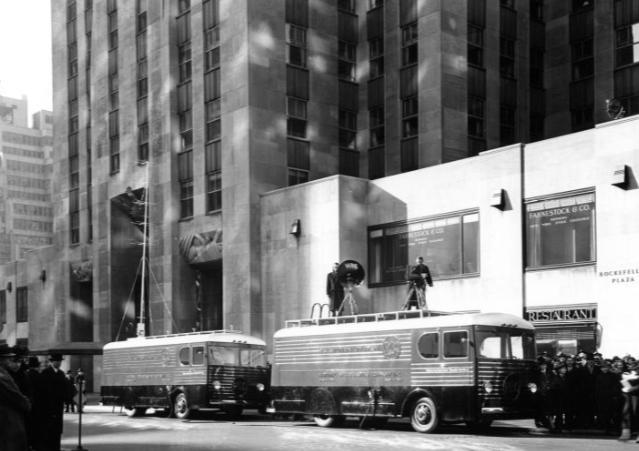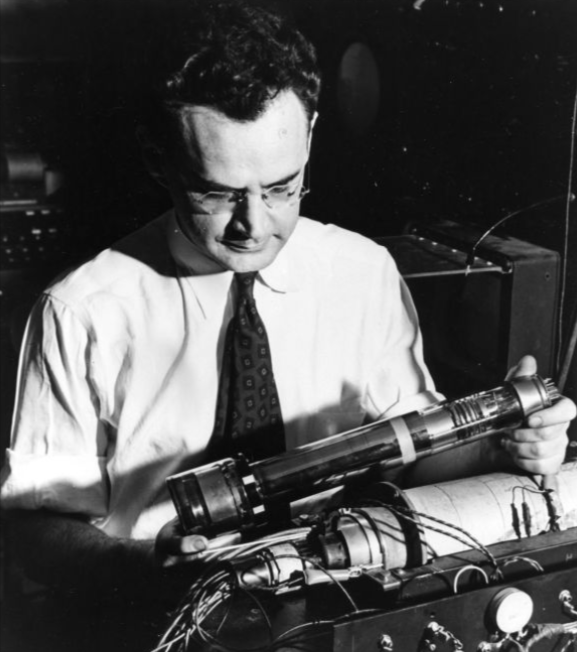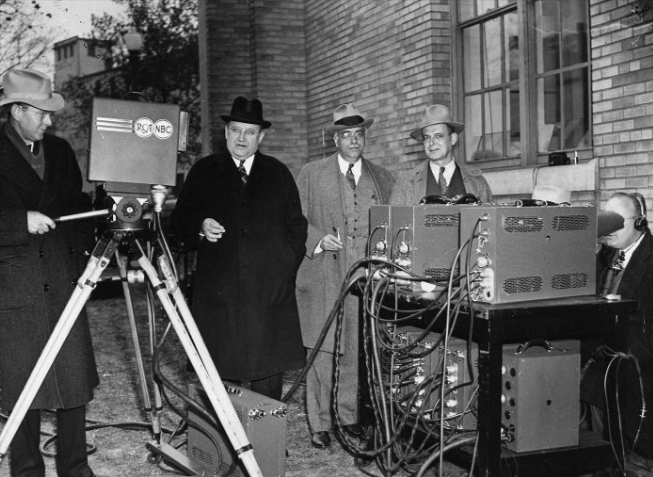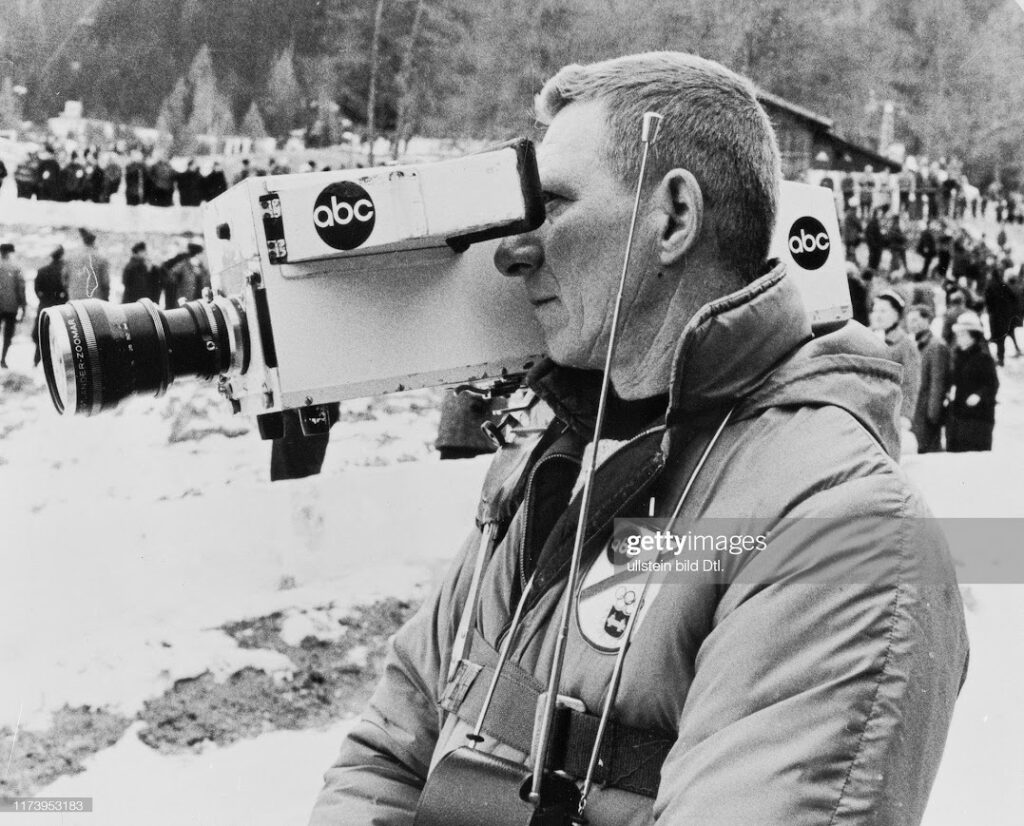The Birth Of The Camera Mounted Electronic Viewfinder
With all of RCA’s incredible advances and discoveries in television, you would have thought that they would be the ones to put an electronic viewfinder into a television camera, but no…they weren’t. The first production cameras made by RCA and DuMont used Iconoscope pickup tubes but RCA did not add an electronic viewfinder until the prototype versions of their Image Orthicon cameras. RCA had a second optical lens above the taking lens that fed and upside down optical image onto a ground glass plate inside the top of the camera. As you can see below, that could be pretty confusing to the cameraman. For more on the RCA camera click the link. https://eyesofageneration.com/some-little-known-facts-of-early-television-production-yesterday-i-posted-t/

What you will see here is what I believe to be, history in-the-making in this sequence of rare photos that would have been totally overlooked had Barry Mitchell not sent them to me.
I feel pretty sure that what we see here in the photo below, is the first ever image of DuMont’s Iconoscope camera. The DuMont prototype camera.
The photo is of a demonstration of how an electronic television broadcast can go mobile, without even a mobile unit. This photo is from the November 1941 issue of International Photographer Magazine (page 351).
With a setup and body style (https://www.earlytelevision.org/emi_emitron.html) very similar to the BBC’s prewar Emitron cameras, this DuMont prototype camera had only an optical sighting hole. Although you can’t see it here, in the third photo down, you can see a ground glass style viewfinder port on the rear, similar to the RCA style on their prewar iconoscope cameras.
Behind the camera operator is the engineer/utility man and notice that he is looking into an electronic viewfinder (with a veiwfinder hood no less). The photo was most likely taken on the DuMont plant grounds in Passaic N.J., just weeks before Pearl Harbor. As a side note on the date, at this same point in history, brand new NBC Studios 6A and 6B were nearing the end of construction and were being readied for radio broadcasts at 30 Rock.
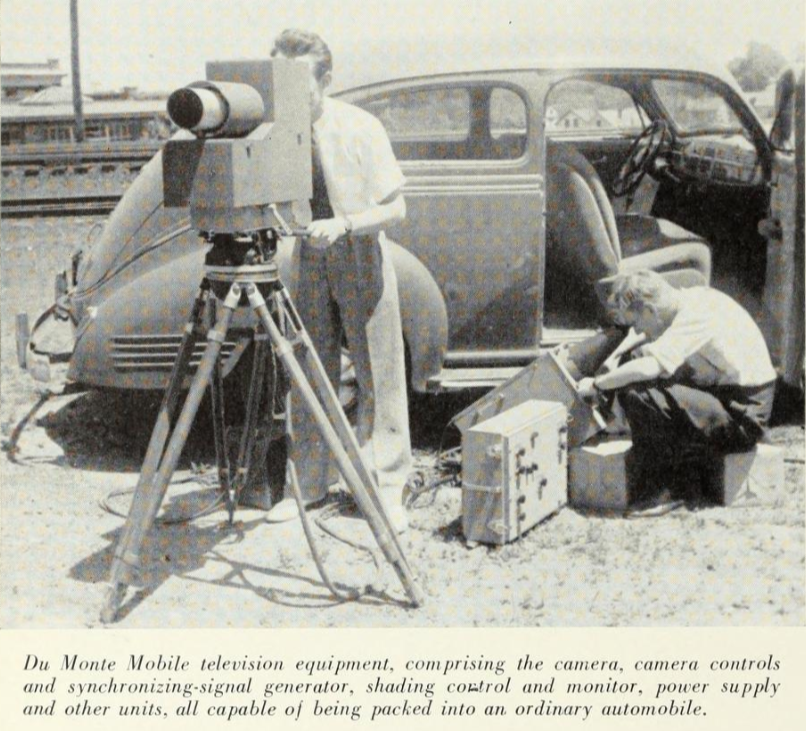
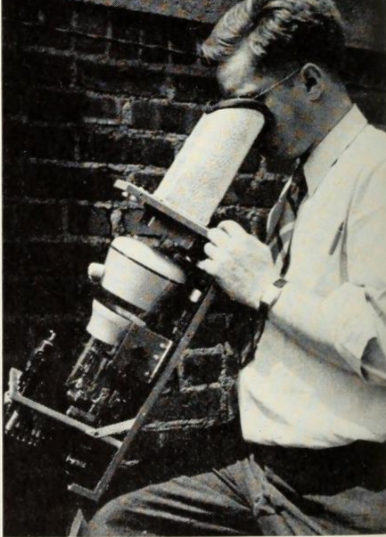
Above is the viewfinder we see in the top photo with the “business end” out of the box. In the box, that is much bigger because of the power supply unit, only the accompanying engineer can see the image which is really not much help to the man behind the camera, but our photo journey continues.
Below is a photo from about a year later (1942 or ’43) that shows DuMont’s new mobile unit that was operated out of their offices and studios at 515 Madison Avenue. Remember, the top photos were taken a month before Pearl Harbor was bombed and shortly after, all electronics manufacturers efforts turned to the war effort…BUT. NBC/RCA, CBS and DuMont all had experimental television stations and DuMont’s W2XWV in New York continued to broadcast on Wednesday and Sunday nights for a few hours.
The image below is most likely from and early evening live broadcast in New York in the summer of 1943. This is most likely the same, single prototype iconoscope camera in the photo above, but notice now, VOILA! The electronic viewfinder is now mounted along the lower left side of the camera, with cords to it’s power supply in the truck in plain site. The next DuMont camera we see will not be this original prototype…it will be their production model that went into service around late 1945 or early ’46.

Below, we have a new casing for the camera and the viewfinder mounted at an angle up the left side for easy viewing and adjustment and in service at DuMont’s KTLA in Los Angeles. -Bobby Ellerbee

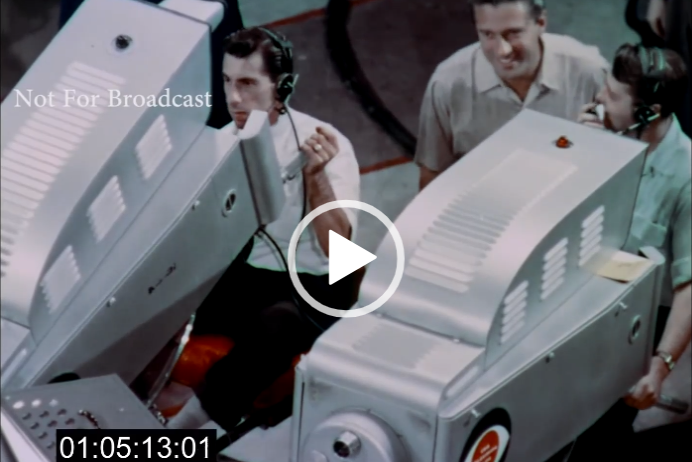
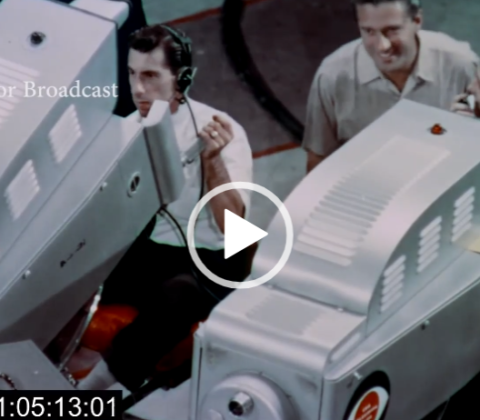
AMAZING CBS COLOR STUDIO 72 NYC…COLOR FILM TOUR
Here is a newly discovered piece of color television history about one of the least known network color facilities…CBS Studio 72 in New York. This is a never aired feature that shows color productions of “The Ed Sullivan Show” and the mystery show “Danger” in 1954.
There are tons of great shots of the RCA TK41s in service and the control room with all the camera control unit apparatus in operation. With the cameras mounted on the old manual PD 1 crank up pedestals and three heavy cables per camera, utility men were a must. BY THE WAY, at the very start, notice the experimental GE mechanical color camera to the left of the introductory speaker. Many thanks to our friend and Game Show Network historian David Schwartz for sharing this.
At the link is a GREAT 24 page CBS Engineering book on CBS Color Studio 72.
https://eyesofageneration.com/cbs-color-studio-72/
ENJOY and BE WELL! -Bobby Ellerbee
THE TONIGHT SHOW WITH JACK PAAR Camera Cards
That I know of, these are the only two remaining camera cards from the wonderful era of THE TONIGHT SHOW WITH JACK PAAR. These were mounted on an easle in the studio and during the show, one of the RCA TK41 color cameras in NBC Studio 6B would shoot this full screen when the show went to, and returned from commercial breaks. Network spots rolled over this and often, there were only a couple of network spots in the break and then time for local spots, which would also play over this, BUT there were times when smaller market stations didn’t have spots sold, SO the locals would return to these cards and the audio of the band, which was led by Jack’s army buddy, pianist Jose Melis. The band would play under it until the end of the stop set and the show resumed. Next stop set, differnt card.
I am very pleased to have these in my collection and wish to thank Gary Morgan in New York, for donating these. Gary acquired both of these in 1964 while attending the RCA television school in New York City. Seems that one day, one of the NBC art department people came to guest lecture and brought these cards with him. By now, Johnny Carson was hosting so there was no more use for these little gems.
By the way, when Paar’s show became a smash hit, NBC renamed it “The Jack Paar Tonight Show”. When he moved to prime-time in 1962, NBC called his show “The Jack Paar Program” and as these say “show”, there may be some confusion as to which Paar program we are talking about. To clear things up, after 1959 (2 years into Paar’s Tonight Show hosting) the program became commonly reffered to as The Jack Paar Show, even at NBC.


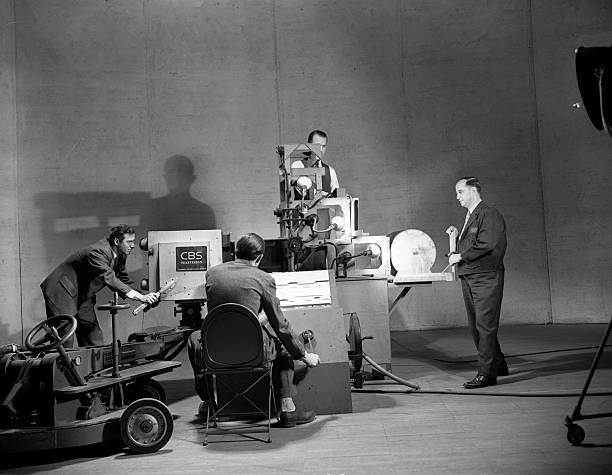

HOW TELEVISION GRAPHICS CAME TO BE
Not long ago, I came across some excelent historical images of television’s first experiments into shadow box technology and precursor elements to telecine and telop technology. I knew that the experts at The Museum of Broadcast Technology in Woonsocket, Rhode Island would be the key to explaining what we were seeing, so I asked our friends there to write this up. Tom Spraigue, Paul Beck, Jay Ballard and Pete Fasciani are MBT’s core and ALL have amazing backgrounds, and I have long been impressed by their work and mission. In this case, Paul Beck took the lead and brings to life how these great images show the transition from imagination to real world capability in an industry that had to be made up as you went along. THANKS to Paul and The Museum of Broadcast Technology for thier help. -Bobby Ellerbee


OH YES, THEY DID!!!
As your Editor In Chief of Eyes of A Generation, I pride myself on trying to display the best, most interesting images of our industry in action, but AT FIRST GLANCE, this series of pictures BLEW MY MIND! No one in their right mind would try to cover a football game with a Chapman Electra studio crane on the sidelines, EXCEPT – if there was a paved running track on the sidelines, which…there is here. In another rarity, CBS is using RCA TK41s (instead of Norelcos) to cover the event and odds are, they are using KTLA’s mobile units for this event. The same RCA built units that Red Skelton owned in the early ’60s. This is the 16th Annual NFL Pro Bowl at Los Angeles Memorial Coliesum in January of 1966. Enjoy! -Bobby Ellerbee





HOW NFL FOOTBALL CAME TO TELEVISION IN 1956
Sig Mickelson was the first president of CBS News, and it is from that insider’s view that we get this amazing story.
In only 8 pages, he explains how CBS public affairs management’s best laid plans to make Sunday afternoons their bull’s eye for public service programming got shot out of a cannon, and how pro football came to find its new home there. I have read Mr. Mickelson’s book, “The Decade That Shaped Television News – CBS in the 1950s” several times, but this time around, his writing on this major event really popped out, and I felt the best way to share this amazing story with you, is to present these 8 pages from his book for you to read for yourself.











NBC COLOR PERFECT PROMOS FROM THE ’60S
Here, back to back, are two :60 second promo’s from NBC, touting their color abilities in the mid 1960s. You have to give them and RCA credit as the leaders in color. No one was better, but unfortunately, when these transfers were made from film to video a few years ago, the master prints had sufferd some major fading and these did not look at all “perfect”. Thanks to our NBC bretheren, we are able to verify that the director shown in the first promo is the great sports director Harry Coyle and the lighting director in the second promo is Bill Klages.
We’ve had some help from our friend Marc Wielage, who is a master Hollywood colorist, to help these look better. Marc says the 16mm print had turned magenta over time and there are basicly no greens or blues left, but with his careful touch, these rare gems do look much better than they did when we sent them to him. In addition to Marc’s help, many thanks to Mike Clark in Los Angeles for finding these in the first place.


THE HOUSE THAT ROONE BUILT
Modern sports television began in Athens, Georgia on September 18, 1965 when the University of Georgia Bulldogs took on Alabama’s Crimson Tide at Sanford Stadium. The game, broadcast on ABC, was the first nationally televised game for Georgia, AND the start of Roone Arledge’s “Big Idea”. His famous 1960 memo to Ed Scherick, which laid out his ideas on how to “bring the viewer to the ballgame” is hard to find, but here it is…it starts with the indented part of this first page and finishes at the top of the third page.
After that is the description of how Roone put it into practice in Athens that crisp fall afternoon when he took the helm in the truck and produced that season’s first game. Going forward, all the ABC producers were were busy incorporating these new measures into their game presentations.




Luck was with Roone and The Bulldogs that day, because at the very last minute, Georgia coach Vince Dooley called a trick play and won the game with an 18 to 17 victory over Bear Bryant. Here is that now famous 22-second play. Many thanks to author Marc Gunther for his great 1994 book “The House That Roone Built: The Inside Story of ABC News”. It is a great behind-the-scenes account of how Roone Arledge transformed ABC’s sports, and later their news division and draws on interviews with top network personnel to examine Arledge’s willingness to experiment and to spend money on talent.
The Broadcast World’s TOP Archive: Including TV
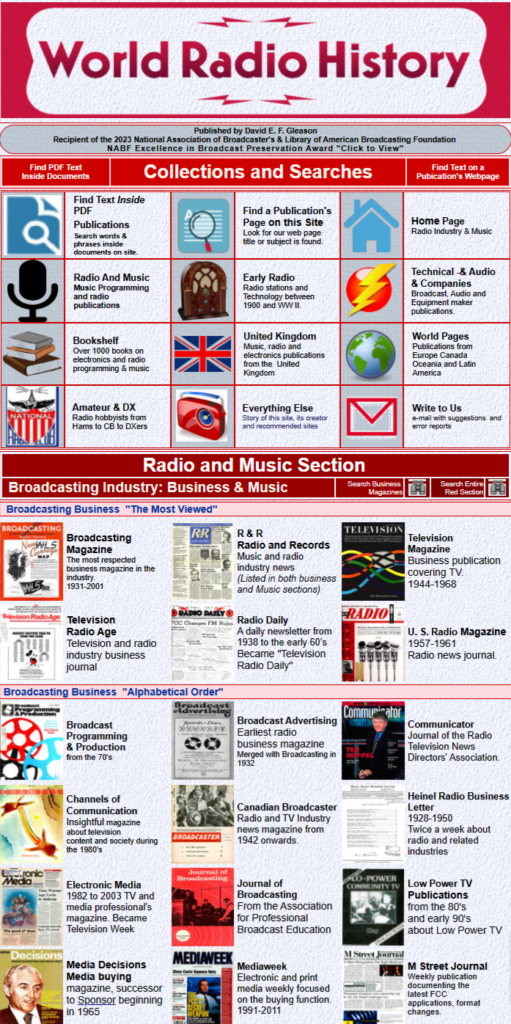
Just so you know, our friend David Gleason’s labor of love is absolutely THE VERY BEST resource for online broadcast research of print media anywhere! He has scanned millions of pages of history onto his WORLD RADIO HISTORY site and made it available to us all FREE! Oh, and what you see above is only a tiny sliver of the hundreds of titles available because if it is a parodical about TV, radio or broadcasting…it is here!
I mean virtually every volume and issue…all of the BROADCASTING MAGAZINE, BILLBOARD and other industry magazines are there as well as most of the RCA engineering magazines and MORE!!! If you have never been there, click the link below and go there and bookmark it so you can remember where this GREAT resource is. THANK YOU, DAVID GLEASON! -Bobby Ellerbee
WorldRadioHistory: Radio Music Electronics Publications ALL FREE


RCA – SARNOFF LIBRARY PHOTO ARCHIVES
At the link below are hundreds of photos, research papers and even two videos (NBC’s First 50 Years) that have been curated to the pages of The Hagley Digital Archives site. Most of what is here is from the David Sarnoff Library collection that no longer has a physical home, but does have a virtual home at this address. This link will take you to the 5th of this 6 page display so feel free to not only scroll, but also page backward and forward to see a collection of RCA television history that you will only see here.
Search Results | Hagley Digital Archives
The are photos here (that usually have a description of the scene on the back side), cover everything from the Baird scanners to the early General Electric/Alexanderson mechanical system, the development of early electronic color receivers, projection systems, tube research and development, remote systems, video tape R&D, and rare photos that also include RCA equipment ads that were mostly for broadcasting publications.
At the top of the page is RCA’s TRT 1B quadraplex video tape recorder which was their first video system. Below are a few of the hundreds of photos in the collection that show RCA’s 2 1/2-pound portable vidicon camera in 1957, the first American television mobile units delivered to NBC in 1938, RCA engineer Albert Rose who was one of the developers of the Image Orthicon tube and a 1938 photo of the FCC commissioners inspecting RCA’s first mobile Iconoscope model in Washington DC.
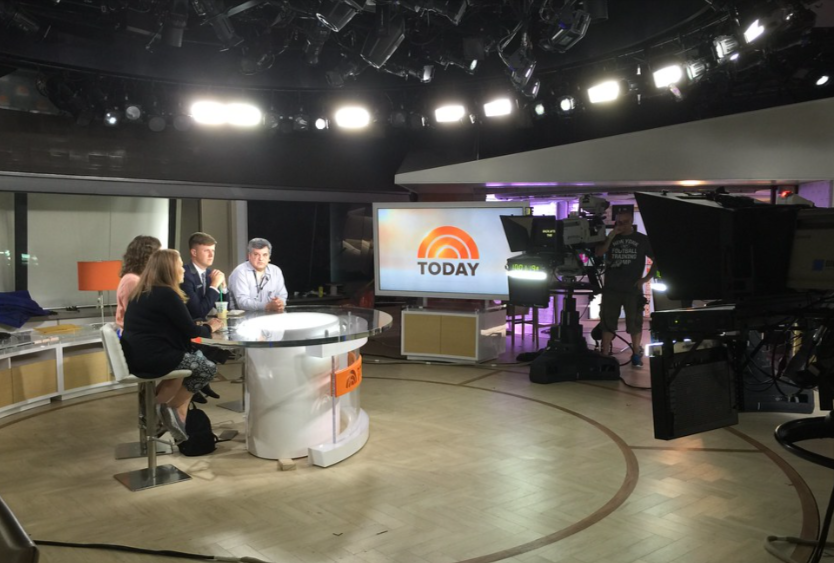
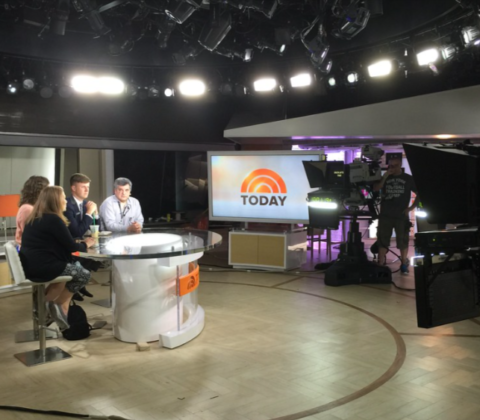
Over 1,250 Curated Photos…Inside NBC 1976-79 & 2004-17
THIS is the granddaddy of network photo tours! Our good friend Dennis Degan spent many years at 30 Rock and kept a photographic record, that to this day, serves as a historic guide to studio makeovers, new control rooms, cosmetic construction and a general documentation of what was going on inside the studios of NBC New York. This top link takes you to gallery of 1,153 images made between 2004 and 2017. The second link brings up photos and information from 1976 through 1979, so click the link and be sure to notice the captions on each image when you move your mouse over the lower left corner. Enjoy!
250 Curated, Behind The Scenes Photos
Ever see the inside of the Unitel Studios in New York, or the SESAME STREET sets at Reaves Teletape Studio 81, or WTCG’s Atlanta studios? Even if you have, you’ve never seen pictures like these from our good friend Dennis Degan! Also in this great collection of photos are production shots from Elton John’s Central Park concert, WSPA TV, WSB TV and Radio, WAGA TV, KYW TV, WIC TV, WYEA TV, the Top Of The Rock at 30 Rockefeller Plaza and more. Be sure to notice the captions on each image when you move your mouse over the lower left corner.
Various Photos 1974 to 2007 | Flickr

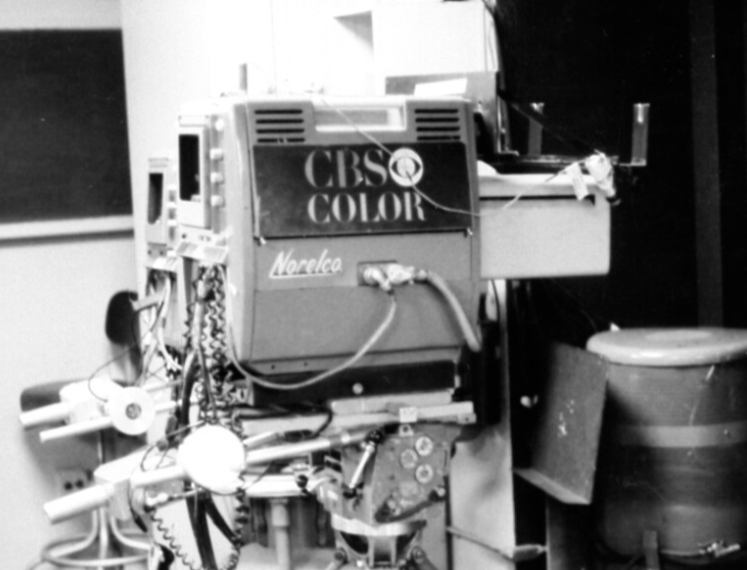
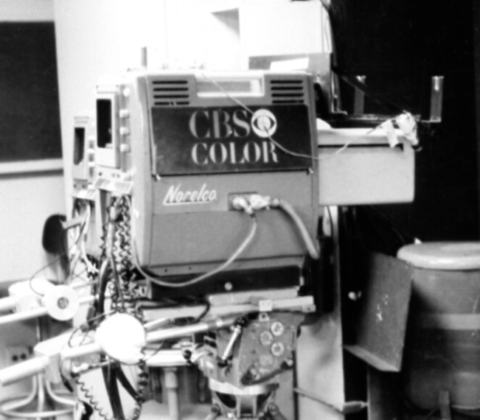
Inside CBS Broadcast Center, 1978 Photo Tour
At this link are 29 classic images taken and shared by our dear friend Dennis Degan. Through the course of his television carier, he has worked as engineer and editor but is also a first rate photographer so enjoy! Be sure to notice the captions on each image when you move your mouse over the lower left corner.
https://www.flickr.com/photos/dennisdegan/sets/72157600588273750/


The Surprising History of ABC’s First Handheld Cameras…LA vs. NYC
About six months ago, I met a character named Joe Maltz somehow. Turns out that in 1961, Joe was the Supervisor of Engineering Maintenance for ABC in New York and had a GREAT STORY to tell! In a nutshell, Joe was put in charge of developing a handheld camera that was better than the one the engineers at ABC Prospect in Los Angeles had just developed.
To set the stage and I need to add some history for perspective, broadcast history and ABC west coast and east coast history. First, the broadcast history; in 1950, NBC had built the first handheld camera, two years before RCA introduced their version (1952) and both were Vidicon cameras. By 1956, RCA had developed a wireless version of the camera and they were used at the political conventions that year and had once been used on the sidelines at a football game in New York state, but only that one time for some reason. FYI, CBS engineering head Dr Dan Flaherty was working with Ikegami on a handheld camera too and the first known used of it was in February of 1962 during the Mercury flights at NASA.
On the ABC Los Angeles history side: Roone Arledge had just been hired (1960) and his job was to get ABC more deeply involved in sports broadcasting, and HE DID! Inside the company, managers began trying to forecast what kind of new technology would be needed and at ABC Prospect in Los Angeles, an engineer named Don McCroskey had an idea. He wanted to build a handheld camera using a full-size Image Orthicon tube. As luck would have it, he had two retired GE PC 7 Image Orthicon cameras on the lot, and they were the sacrificial lambs that would supply the parts for two portable cameras. Aiding Don were engineers Dean Cannon, Bob Bleiwiess and Jerry Buchi who helped refine the camera.
Below is Jim Angel behind one of the GE cameras testing the tubes before they were wheeled into the Prospect lot’s engineering garage for surgery…they were having their yokes “transplanted”.

Below is ABC’s first handheld cameraman Mike Friedman, one of their TOP operators for years before this photo was made of him shooting Jim McKay for WIDE WORLD OF SPORTS. Mike went on to directing on WIDE WORLD.

Below is ABC’S first portable camera “demonstrated” by our great friend DON “PEACHES” LANGFORD, who, as a firsthand witness to this history, also contributed to this article. Oh, and the bald wig Don is wearing is a tribute to his boss, Mike Friedman, who sported the look many years before it was a “thing.”
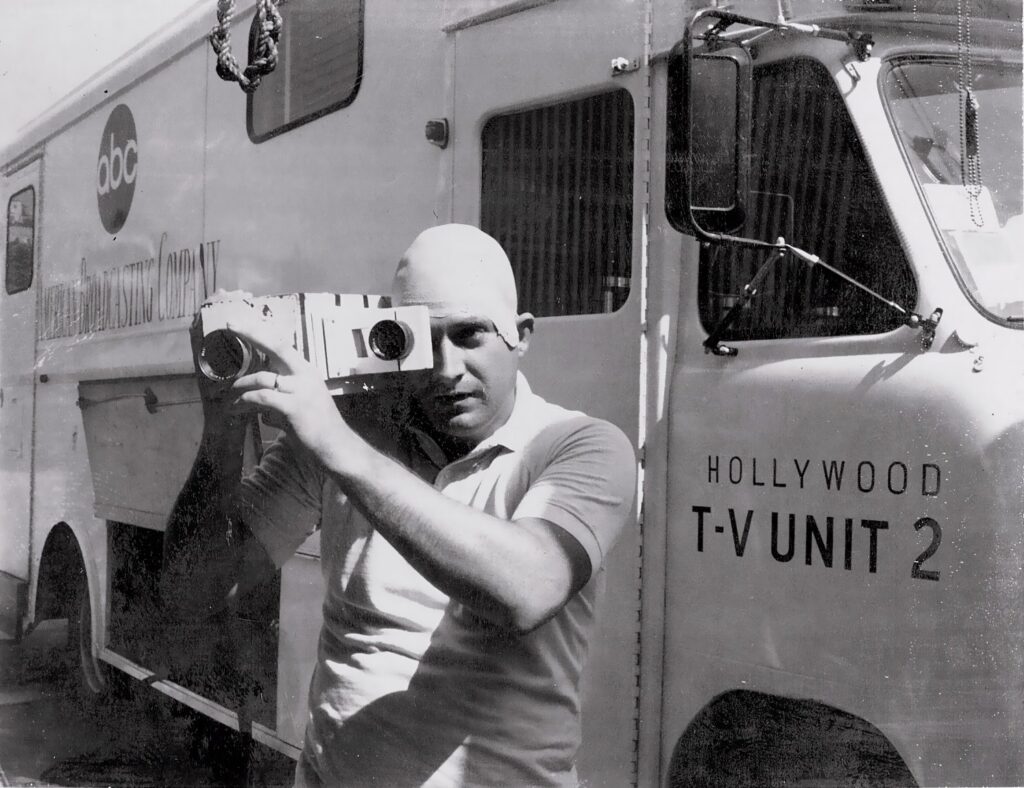
Below is a 2016 photo of Don Langford with the camera he used in the mid 1960s at ABC, the one you see him with in the photo above. When the two cameras were retired in the 70s, ABC LA manager Robert Trachinger made sure they were not lost to history and these two are still in his care.

Below is one final photo of the Los Angeles version in use in 1963 at The University of Virgina.

NOW TO THE EAST COAST ABC HISTORY AND THE “ABC PRESS ORTH CAMERA” DEVELOPMENT. Below is a photo of that rarity.

When Joe Maltz began to tell me about this, he kept mentioning the “press orth” and I had no idea what he was talking about, so I finally asked him what a press orth was. To my surprise he said that was the name of the camera! TWO EVEN BIGGER SURPRISES came when I was on the phone with Don “Peaches” Langford in LA fact checking this article. 1st, When I told him about the press orth name, he said “Yeah, that’s what we called ours too, but we were first, and New York just added the city name to the Press Orth name.” 2nd, their first press orth in LA was cabled directly the carcass of one of the GE cameras, minus the viewfinder! That must have been an odd sight. There was 50 feet of cable between the new camera head (basically the GE’s yoke assembly) and the old camera head with 50 more feet of cable to the truck. On their second version, they managed a better workaround. Oh, and Peaches did know Joe Maltz as he had covered many events in NYC too. I love to be amazed!
Here is part of the story Joe Maltz told me:
The engineers at ABC’s Los Angeles operation had, in order to give the cameraman more maneuverability, created a small hand-held camera by separating the television pickup tube assembly from the bowels of a GE television camera, extended the cable harness, added an optical viewfinder and created what I believe was ABC’s first broadcast hand “hand-held” camera. The “Creepy-Peepie”, as it was dubbed, was tethered to the carcass of the camera by the cable harness.
There were two problems. The concept was great, but the quality left much to be desired. The second problem was, considering the rivalry between the ABC East Coast and West Coast operations, the “Creepy-Peepy” was an NIH (Not Invented Here) creation. The New York Operations Group was jealous. This situation had to be rectified.
During this period, I was the Supervisor of Engineering Maintenance in New York. I had the reputation of being an innovator. Merle Worster, the Director of Technical Operations for the East Coast, asked me if I could come up with New York alternative for the Creepy Peepy. I agreed and did some research as to what would be required for a suitable hand-held camera. The unit had to have the following features:
- Light enough to be easily carried and operated by a single cameraman.
- The camera cable had to be extended to at least 200 feet and had to be able to operate with a 200-foot cable
- An electronic viewfinder would be required.
- The operating controls had to be easily accessible.
- The electronics would have to be compatible with the existing Camera Control Units.
After six weeks of design and construction, with the help of Harold Gordon and Bill Wagner, the camera, with all of the above features was used for the first time on an ABC Wide World of Sports television program. I dubbed the camera, the “New York Press Orth”.
I designed the NY version and Harrold Gordon built it. The electronic viewfinder was created from CRT tube from Philco Safari portable TV with tube facing front of camera with 2 bending mirrors for the eyepiece. Interior of both (2 units built in NYC) cameras were made of TK31 parts as many were smaller than the TK30 components. – Joe Maltz
Below are pictures Mr Maltz sent that show some of the features of the camera and showing it in action…this first image is at the Liston–Clay fight (Ali had not yet changed his name from Cassius Clay), on February 25, 1964 in Miami Beach, Florida.
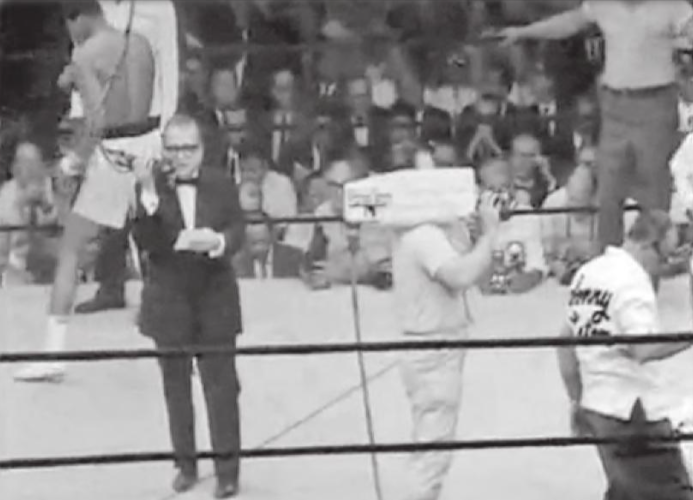
Here is the shoulder harness that became a real necessity as soon as the camera was tested.
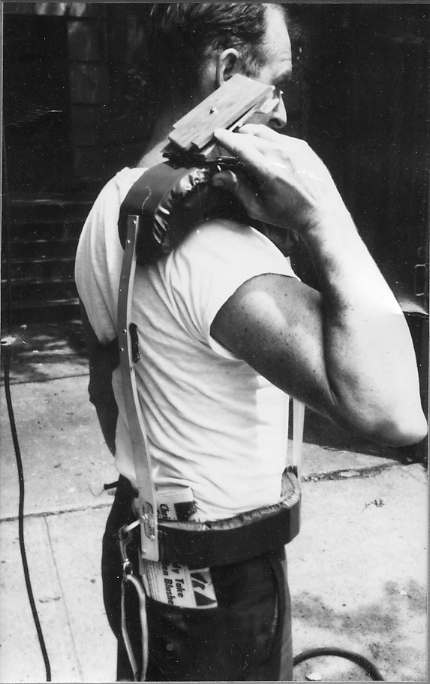
And finally, this is the auxiliary unit for the ABC Press Orth camera.

Below is one of the NYC Press Orths in use at the 1964 Olympics in Innsbruck
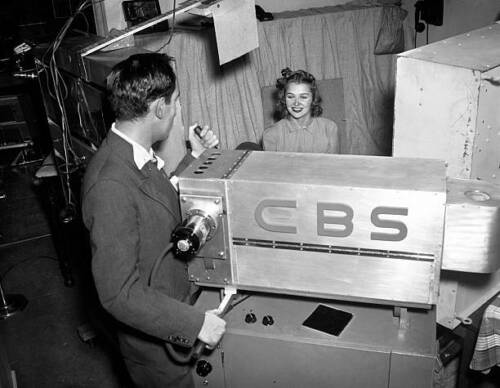

CBS FIELD SEQUENTIAL COLOR TEST…RARE IMAGES & INFO
What does the Orson Wells classic radio drama “War Of The Worlds” have in common with Dr Peter Goldmark’s mechanical color tests? The answer is CBS Radio Studio 1 at their first headquarters building, 485 Madison Avenue. That was where Wells and company preformed their weekly “Mercury Theater of The Air”.
Around the start of 1952, CBS converted radio Studio 1, on the 4th floor of the 485 Madison building to CBS television Studio 71. Under the CBS numbering system, the numbers 71-80 were reserved for color studios only. In October of 1951, CBS wrapped up a 5 month trial broadcasting schedule of color shows which, except for remotes, had originated at CBS Studio 57. Studio 71 was closed in 1955.
In the images below, we will see those odd looking cameras with mechanical color wheels in them in use at Studio 71 and usually shooting the first “Miss Color Television”, Patty Painter, with her red hair, later died blonde. The better known color television model was NBC’s Marie McNamara but CBS started with Patty about a year before NBC brought in Marie.
These historical images are from the CBS Photo Archives available through Getty Images and are presented here to assist researchers and television historians in identifying the television equipment in use over the decades and is offered here in a purely educational/instructional forum. For more information on CBS Color, please visit Ed Reitan’s great work at this link Ed Reitan’s Color Television History (earlytelevision.org)
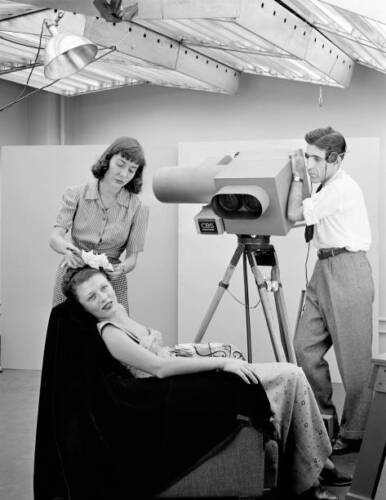
Above, CBS color girl Patty Painter getting all “dolled up” for her test time before the camera.

Another shot of Patty Painter and a very detalied look at one of Goldmark’s color camera configurations in these three photos.
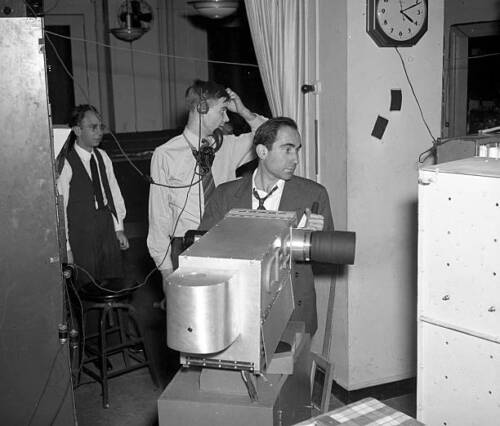


Above using RCA equipment to monitor the tests and a home reciever to see the final product. Below, world famous actor Charlie Chaplin taking a close look at the new color wheel system with Peter Goldmark on the left.
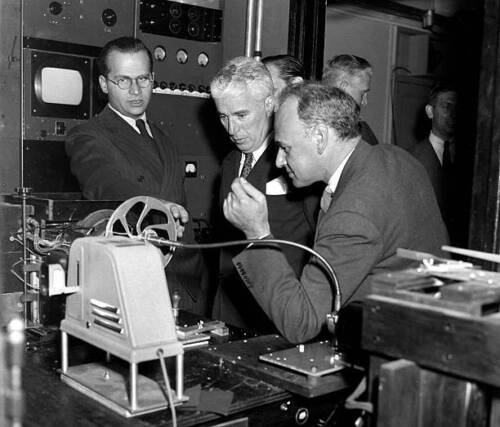
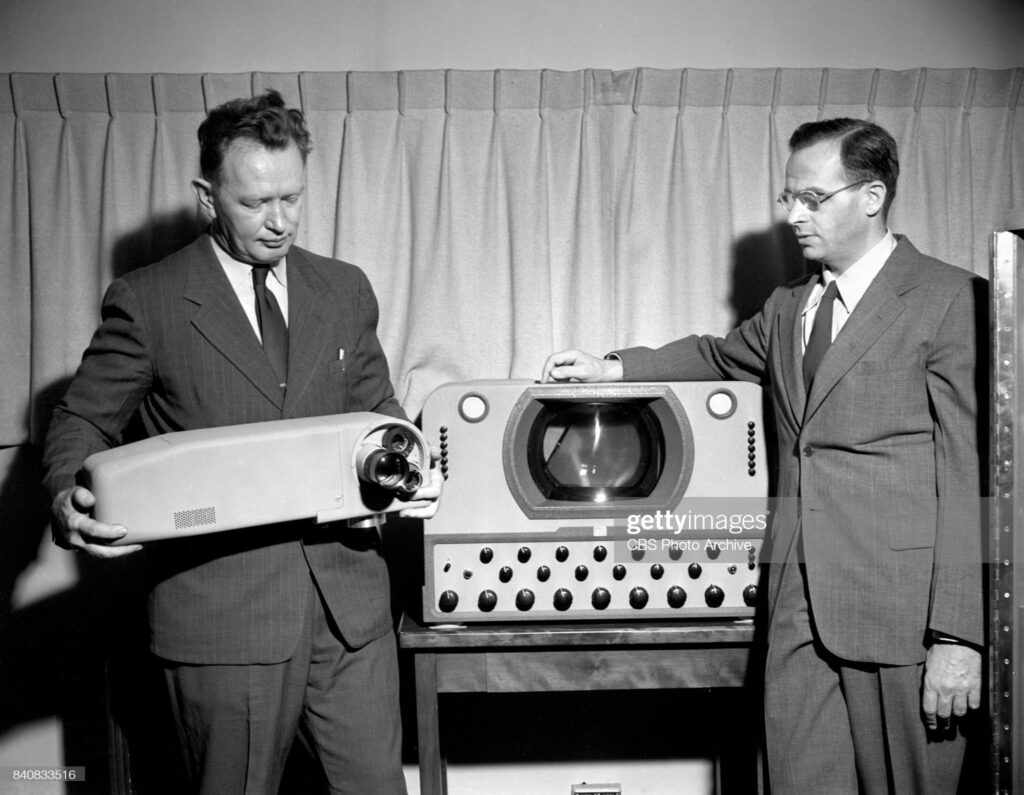
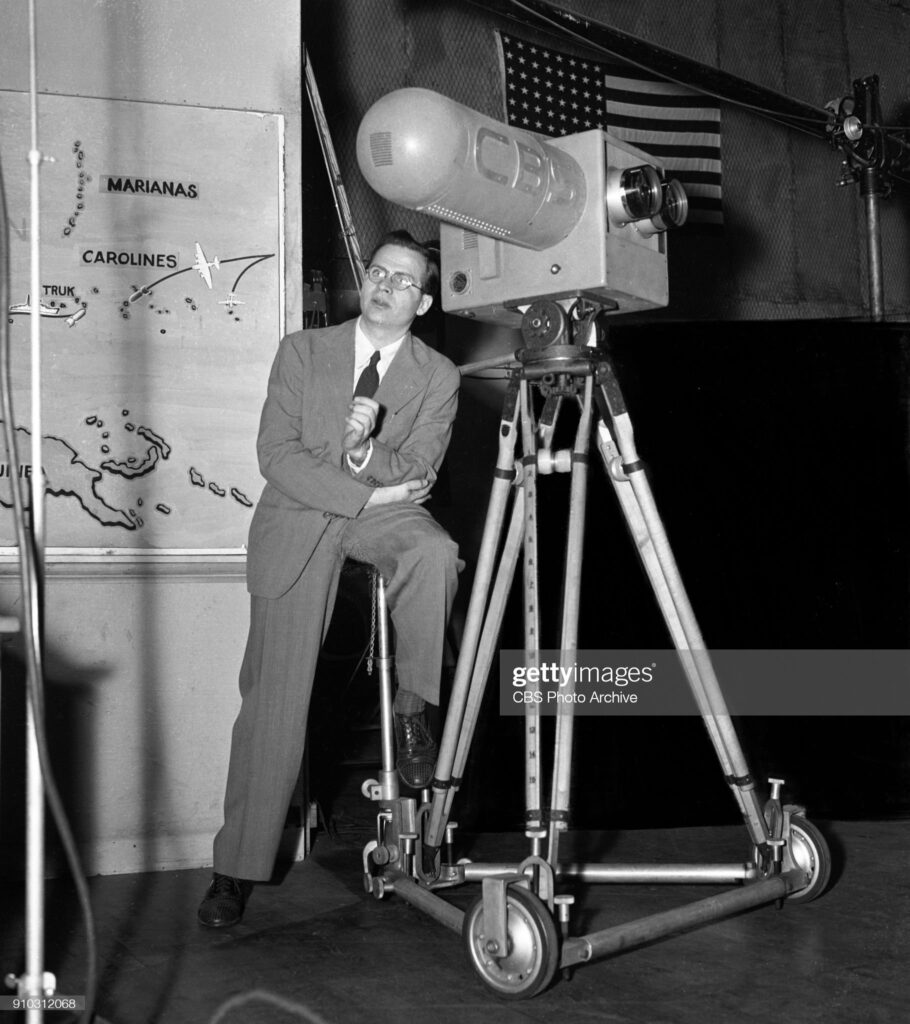
Below, color images from Life Magazine in 1950 comparing Kodachrome photographs of the original subject and photographs of a CBS color receiver show excellent color fidelity of even this earliest color television system.



Behind The Scenes At The ED SULLIVAN SHOW…Part 1 (of 7)
THE RCA TK30 ERA: About the only way I could think of to present these 120+ images from one of television’s most storied shows, is to break the batches down based on the cameras in use. At the time this multi-decade epic began in 1948, the show was called TOAST OF THE TOWN and was broadcast live from CBS Studio 51 (The Maxine Elliot Theater at 109 W 39TH Street, photo above) using RCA TK30 cameras.
These historical images are from the CBS Photo Archives available through Getty Images and are presented here to assist researchers and television historians in identifying the television equipment in use over the decades and is offered here in a purely educational/instructional forum.

To start us off, this photo is from dress rehersal of the debut show, June 30, 1948 and among the guests on stage are composers Richard Rogers and Oscar Hammerstien II (center behind Ed) and circled are Jerry Lewis and Dean Martin.
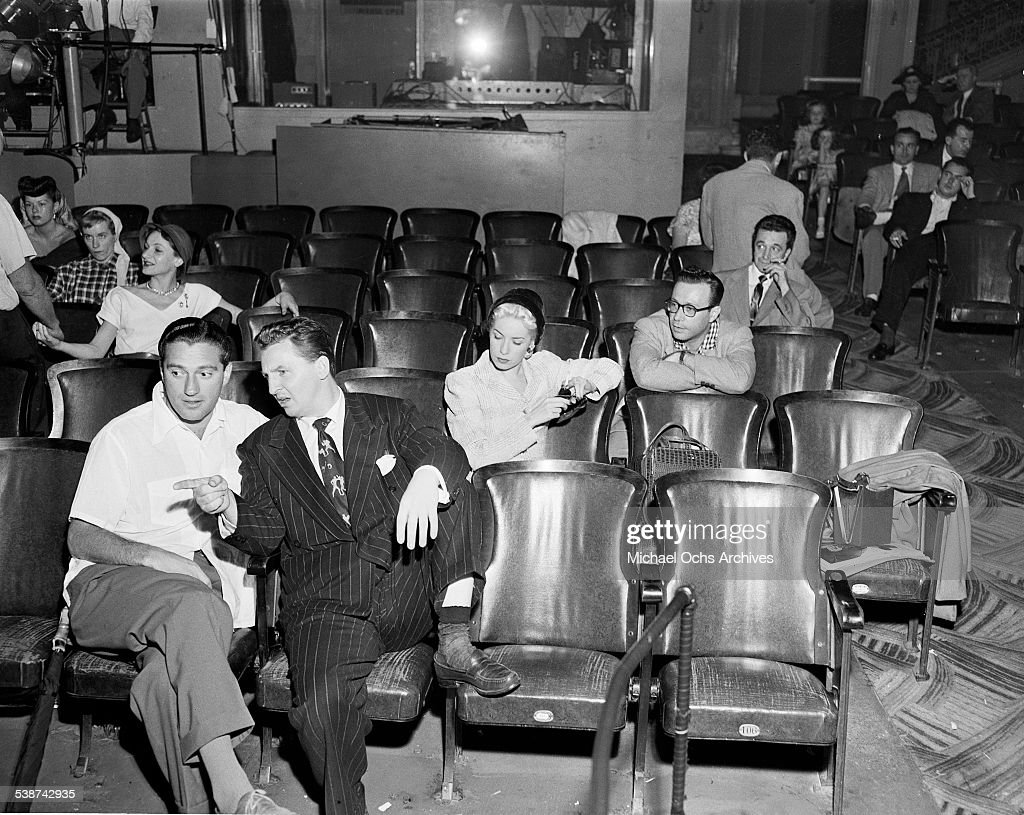
NEW YORK – AUGUST 20,1950: Producer Marlo Lewis (L) follows the acts during rehearsal for “Toast of the Town” hosted by Ed Sullivan at the Maxine Elliott Theater in New York, New York.(Photo by Steve Oroz/Michael Ochs Archives/Getty Images)

NEW YORK – FEBRUARY 18,1951: Ed Sullivan listens to young Paul Schon play “Army Air Corp” on his clarinet during rehearsal for “Toast of the Town” hosted by Ed Sullivan at the Maxine Elliott Theater in New York, New York.(Photo by Steve Oroz/Michael Ochs Archives/Getty Images)

NEW YORK – OCTOBER 28,1951: Anne Jeffreys sings “Dance My Darling” on “Toast of the Town” show hosted by Ed Sullivan at the Maxine Elliott Theater in New York, New York.(Photo by Steve Oroz/Michael Ochs Archives/Getty Images)

NEW YORK – OCTOBER 28,1951: Anne Jeffreys sings “Dance My Darling” on “Toast of the Town” show hosted by Ed Sullivan at the Maxine Elliott Theater in New York, New York.(Photo by Steve Oroz/Michael Ochs Archives/Getty Images)

NEW YORK – JUNE 29,1952: Guest Hosts Peter Lind Hayes and Mary Healy perform on the “Toast of the Town” show hosted by Ed Sullivan at the Maxine Elliott Theater in New York, New York.(Photo by Steve Oroz/Michael Ochs Archives/Getty Images)

NEW YORK – JULY 18: CBS television variety show, “Toast of the Town” (alt.: The Ed Sullivan Show). The program features host and emcee Ed Sullivan (pictured). Photo Dated: Sunday, July 18, 1948. New York, NY. (Photo by CBS via Getty Images)
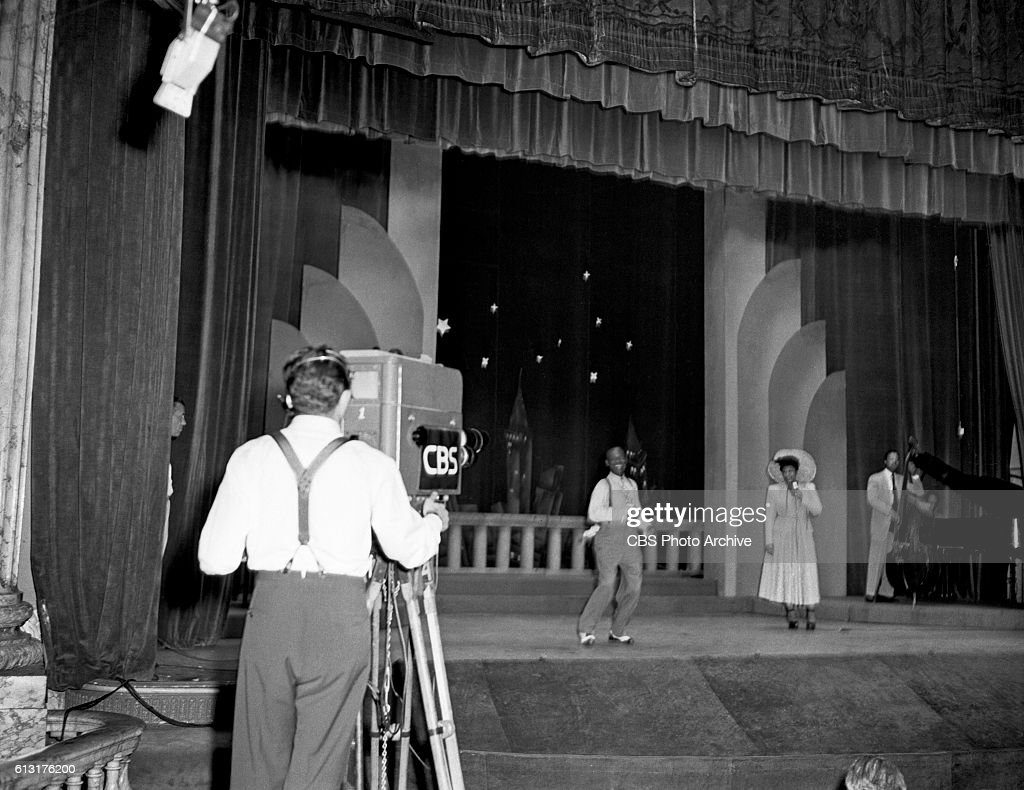
NEW YORK – JULY 18: CBS television variety show, “Toast of the Town” (alt.: The Ed Sullivan Show). The program features host and emcee Ed Sullivan. Guests include jazz vocalist Ella Fitzgerald (pictured right) and tap dancer Bill “Bojangles” Robinson (pictured left). Photo Dated: Sunday, July 18, 1948. New York, NY. (Photo by CBS via Getty Images)
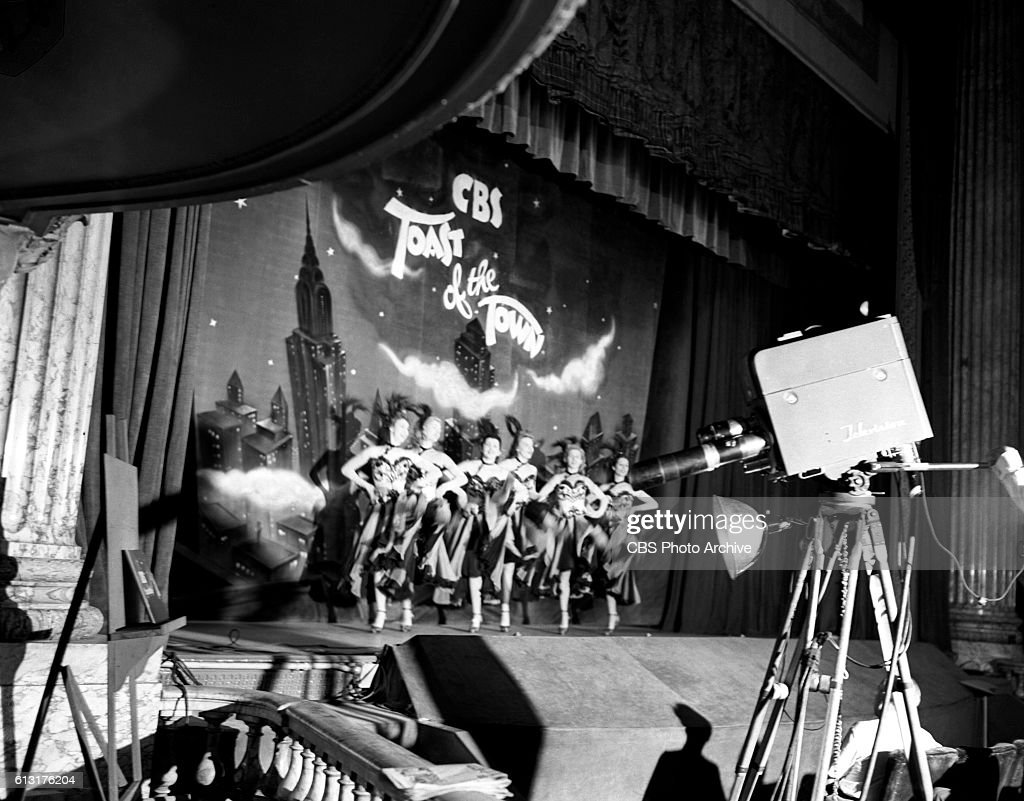
NEW YORK – JULY 18: CBS television variety show, “Toast of the Town” (alt.: The Ed Sullivan Show). The program features host and emcee Ed Sullivan. Guests include, Toy and Wing, Ella Fitzgerald and Bill “Bojangles” Robinson. Photo Dated: Sunday, July 18, 1948. New York, NY. (Photo by CBS via Getty Images)
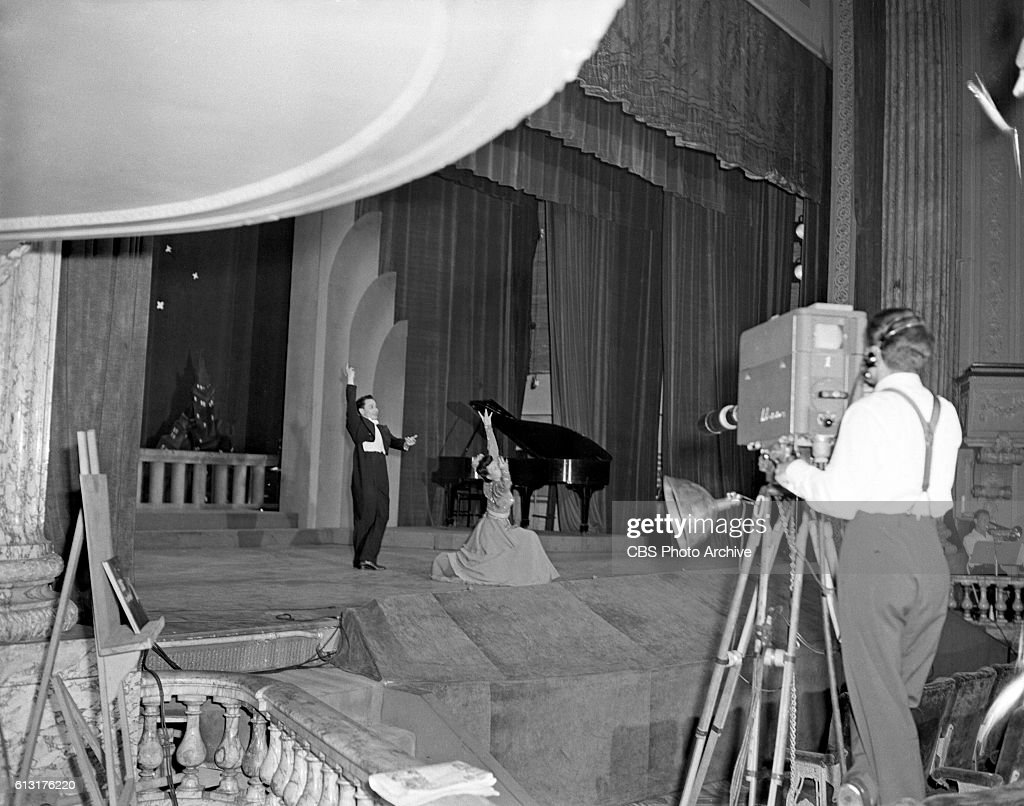
NEW YORK – JULY 18: CBS television variety show, “Toast of the Town” (alt.: The Ed Sullivan Show); the program features host and emcee Ed Sullivan, guests include Toy and Wing (pictured: acrobatic tap dance duo of Dorothy Takahashi and Paul Wing). Photo Dated: Sunday, July 18, 1948. New York, NY. (Photo by CBS via Getty Images)

NEW YORK – JULY 18: CBS television variety show, “Toast of the Town” (alt.: The Ed Sullivan Show). The program features host and emcee Ed Sullivan (pictured left). Pictured with host Ed Sullivan is jazz vocalist, Ella Fitzgerald (right) Photo Dated: Sunday, July 18, 1948. New York, NY. (Photo by CBS via Getty Images)
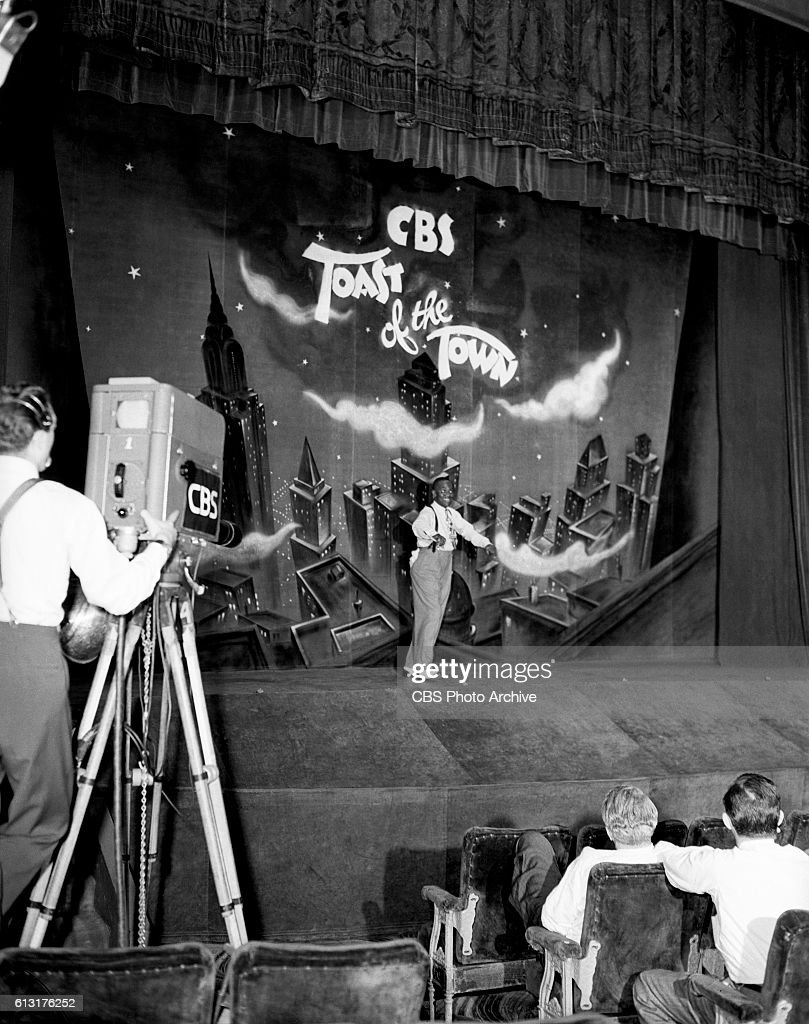
NEW YORK – JULY 18: CBS television variety show, “Toast of the Town” (alt.: The Ed Sullivan Show). The program features host and emcee Ed Sullivan. Pictured: Bill “Bojangles” Robinson (tap dancer) – after a solo dance, does a “Hard Shoe” encore with The Toastettes. Photo Dated: Sunday, July 18, 1948. New York, NY. (Photo by CBS via Getty Images)
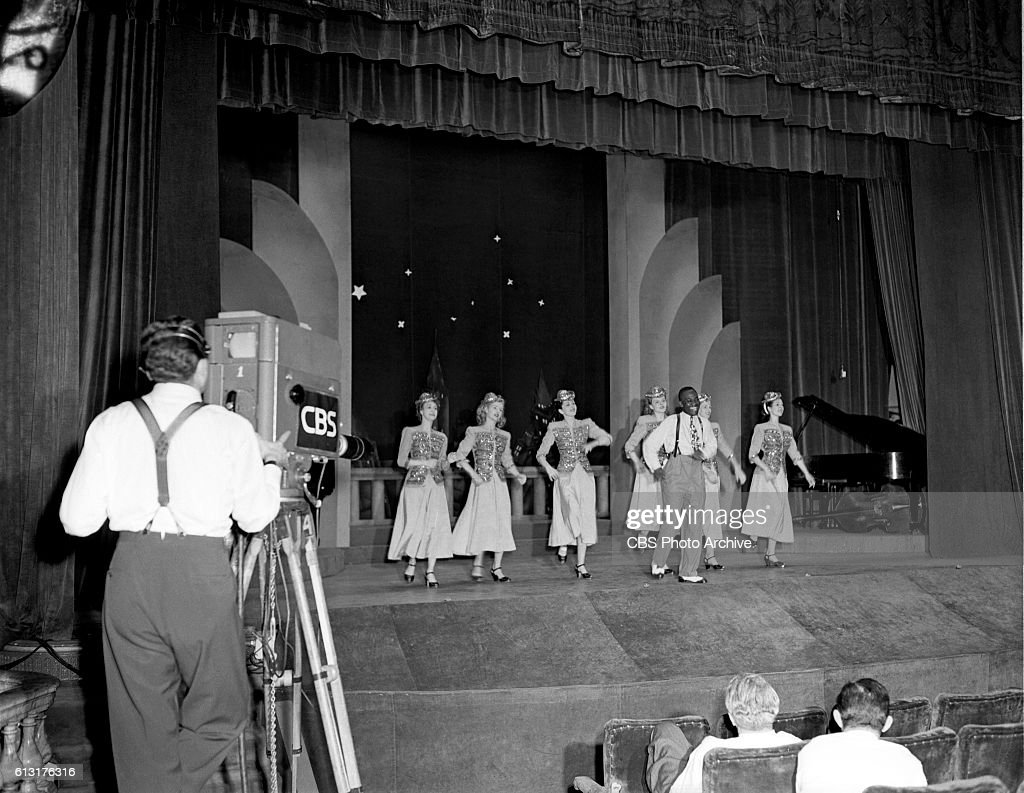
NEW YORK – JULY 18: CBS television variety show, “Toast of the Town” (alt.: The Ed Sullivan Show). The program features host and emcee Ed Sullivan. Pictured: Bill “Bojangles” Robinson (tap dancer) – after a solo dance, does a “Hard Shoe” encore with The Toastettes. Photo Dated: Sunday, July 18, 1948. New York, NY. (Photo by CBS via Getty Images)
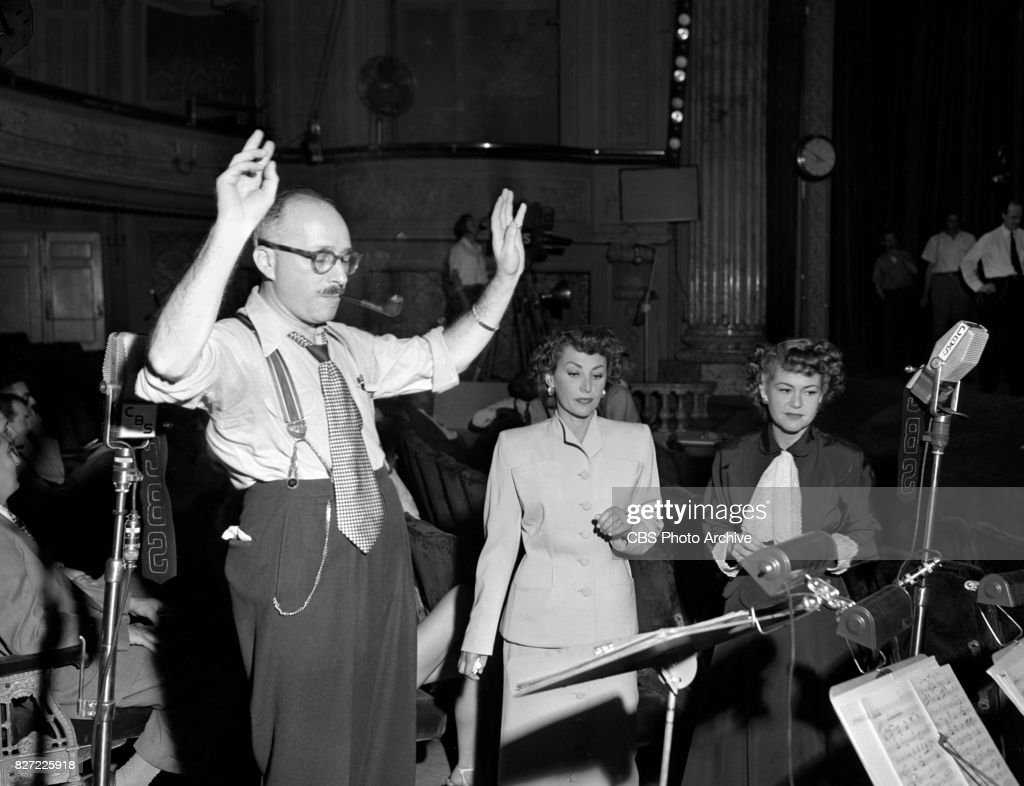
NEW YORK – SEPTEMBER 12: CBS television variety show, ‘Toast of the Town’ (alt.: The Ed Sullivan Show). The program features host and emcee Ed Sullivan. Pictured here at left is orchestra conductor Ray Bloch with with The Dennis Sisters (a vaudeville song-and-comedy duo). New York, NY. September 12, 1948. (Photo by CBS via Getty Images)
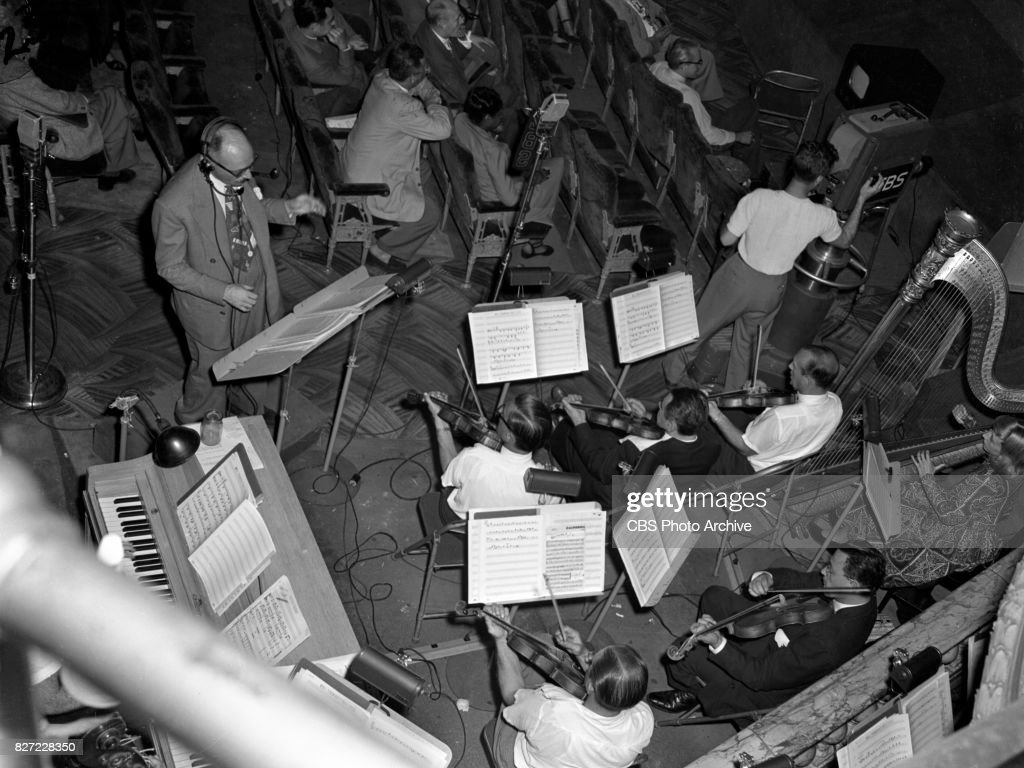
NEW YORK – SEPTEMBER 19: CBS television variety show, ‘Toast of the Town’ (alt.: The Ed Sullivan Show). The program features host and emcee Ed Sullivan. Pictured is the Ray Bloch (standing with headset on), musical director of The Ed Sullivan Show, with musicians. September 19, 1948. (Photo by CBS via Getty Images)
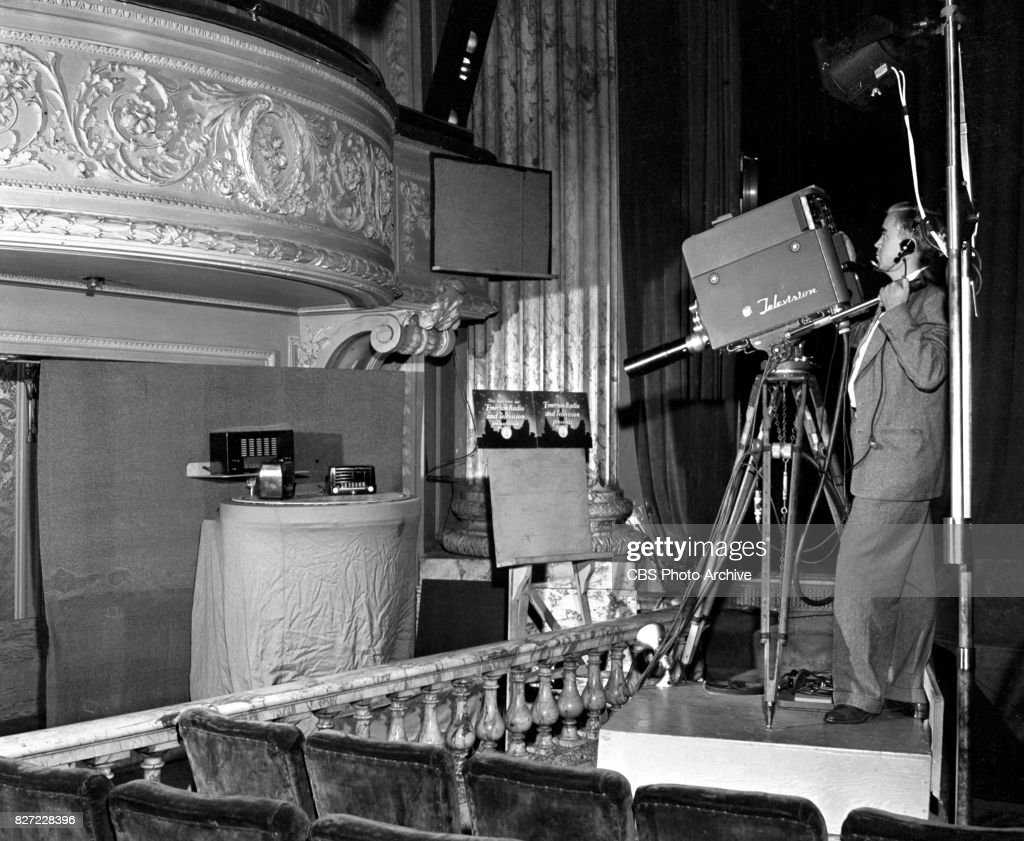
NEW YORK – SEPTEMBER 19: CBS television variety show, ‘Toast of the Town’ (alt.: The Ed Sullivan Show). The program features host and emcee Ed Sullivan. Pictured is a cameraman filming Emerson radios. Emerson Radio Corporation was an early sponsor of the program. September 19, 1948. (Photo by CBS via Getty Images)
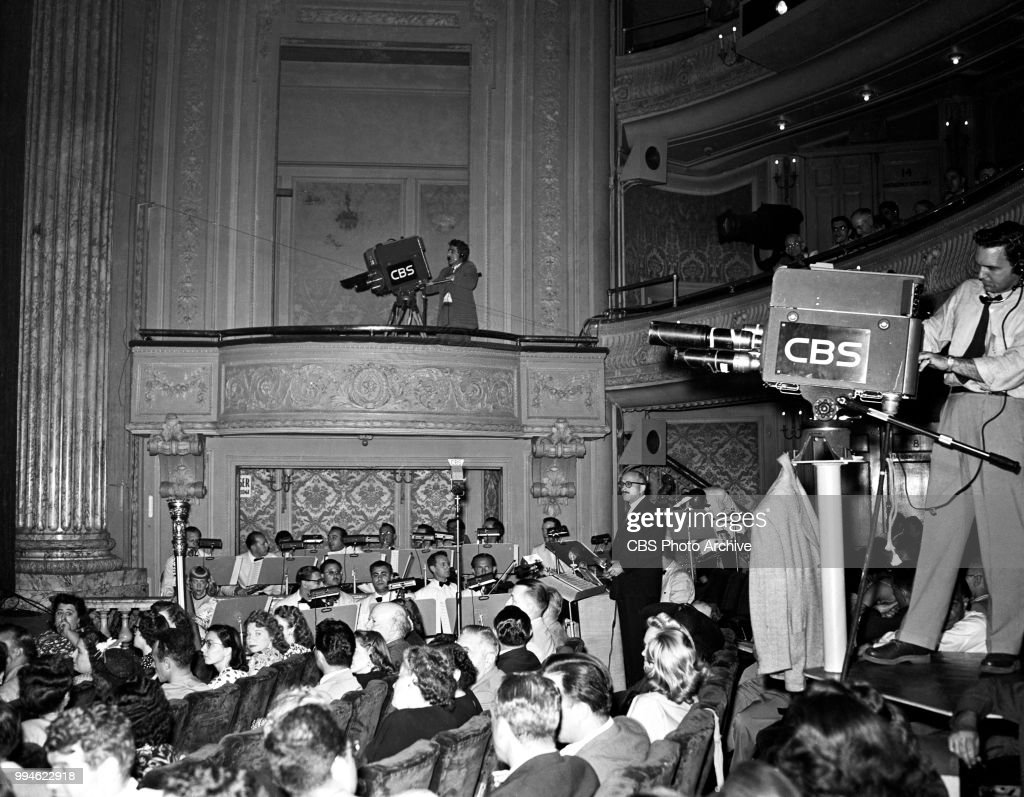
NEW YORK – JULY 2: Staff and crew members work on the broadcast of an episode of the CBS television program, Toast of the Town (The Ed Sullivan Show). Image dated: July 2, 1948 New York, NY. (Photo by CBS via Getty Images)
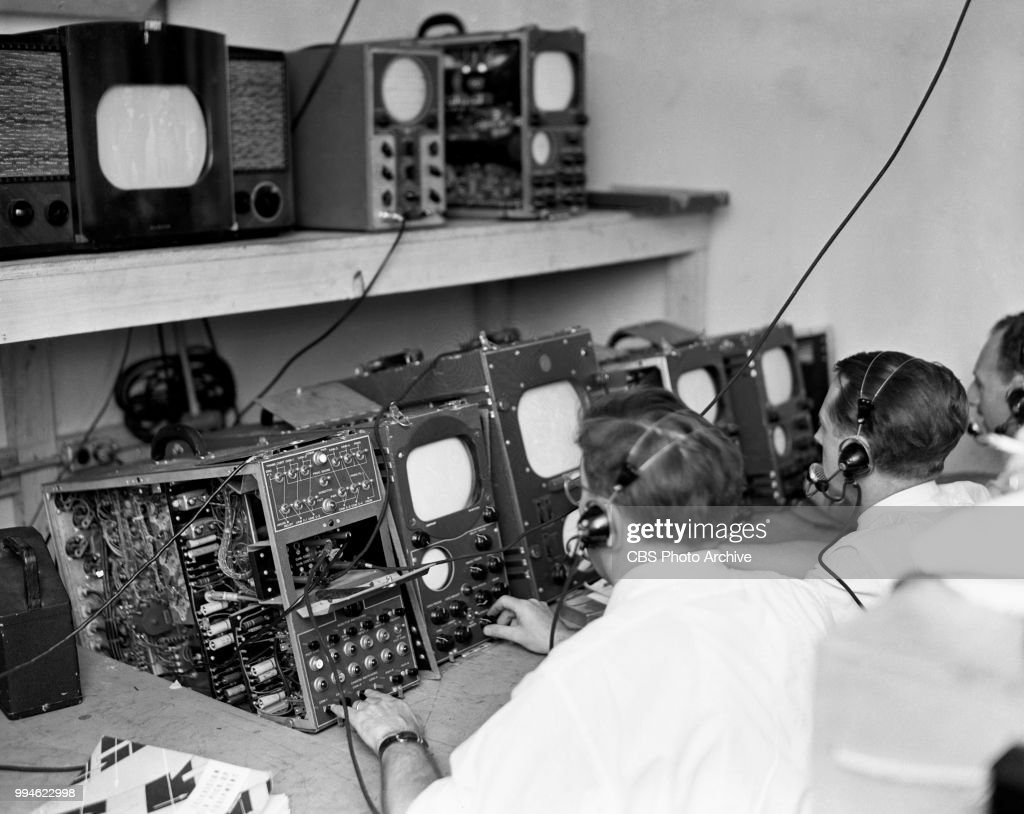
NEW YORK – JULY 2: Crew members work on the broadcast of an episode of the CBS television program, Toast of the Town (The Ed Sullivan Show). Image dated: July 2, 1948 New York, NY. (Photo by CBS via Getty Images)
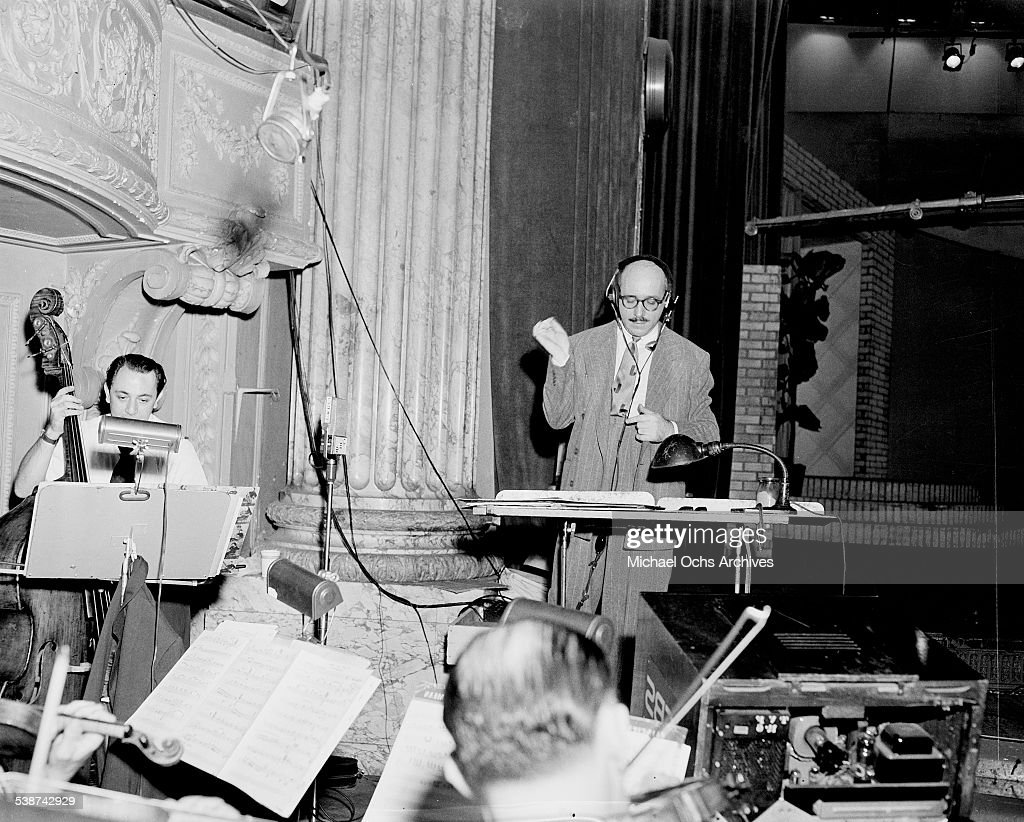
NEW YORK – AUGUST 20,1950: Ray Bloch leads his orchestra during rehearsal for “Toast of the Town” hosted by Ed Sullivan at the Maxine Elliott Theater in New York,New York.(Photo by Steve Oroz/Michael Ochs Archives/Getty Images)



Behind The Scenes at THE ED SULLIVAN SHOW…Part 2 (of 7)
The RCA TK30 Era Extends to Studio 50: This second TK30 part is to commemorate the move from CBS Studio 51 (The Maxine Elliott Theater at 109 W. 39th Street) to CBS Studio 50 (at 1697 Broadway) in January of 1953. The cameras were still RCA TK30s but it was a much larger venue. (THE TOAST OF THE TOWN ran from 1948-1955 when the name changed to THE ED SULLIVAN SHOW).
These first 4 photos are from 2 years before Sullivan’s show moved in, but do show the first television configuration for Studio 50 and the show set seen here is what I believe is ARTHUR GODFREY AND FRIENDS.
These historical images are from the CBS Photo Archives available through Getty Images and are presented here to assist researchers and television historians in identifying the television equipment in use over the decades and is offered here in a purely educational/instructional forum.

NEW YORK – JULY 31: CBS Radio Playhouse number 3. Interior view. 1697 Broadway at West 53rd Street, New York, NY. Image dated July 31, 1951. Originally known as Hammerstein’s Theater, later became the Manhattan Theater. In 1936, leased by CBS, it became CBS Radio Playhouse number 3, and later as CBS Television Studio 50. Finally, as The Ed Sullivan Theater. (Photo by CBS via Getty Images)

NEW YORK – JULY 31: CBS Radio Playhouse number 3. Interior view. 1697 Broadway at West 53rd Street, New York, NY. Image dated July 31, 1951. Originally known as Hammerstein’s Theater, later became the Manhattan Theater. In 1936, leased by CBS, it became CBS Radio Playhouse number 3, and later as CBS Television Studio 50. Finally, as The Ed Sullivan Theater. (Photo by CBS via Getty Images)

NEW YORK – JULY 31: CBS Radio Playhouse number 3. Interior view. 1697 Broadway at West 53rd Street, New York, NY. Image dated July 31, 1951. Originally known as Hammerstein’s Theater, later became the Manhattan Theater. In 1936, leased by CBS, it became CBS Radio Playhouse number 3, and later as CBS Television Studio 50. Finally, as The Ed Sullivan Theater. (Photo by CBS via Getty Images)

NEW YORK – JULY 31: CBS Radio Playhouse number 3. Interior view. 1697 Broadway at West 53rd Street, New York, NY. Image dated July 31, 1951. Originally known as Hammerstein’s Theater, later became the Manhattan Theater. In 1936, leased by CBS, it became CBS Radio Playhouse number 3, and later as CBS Television Studio 50. Finally, as The Ed Sullivan Theater. (Photo by CBS via Getty Images)
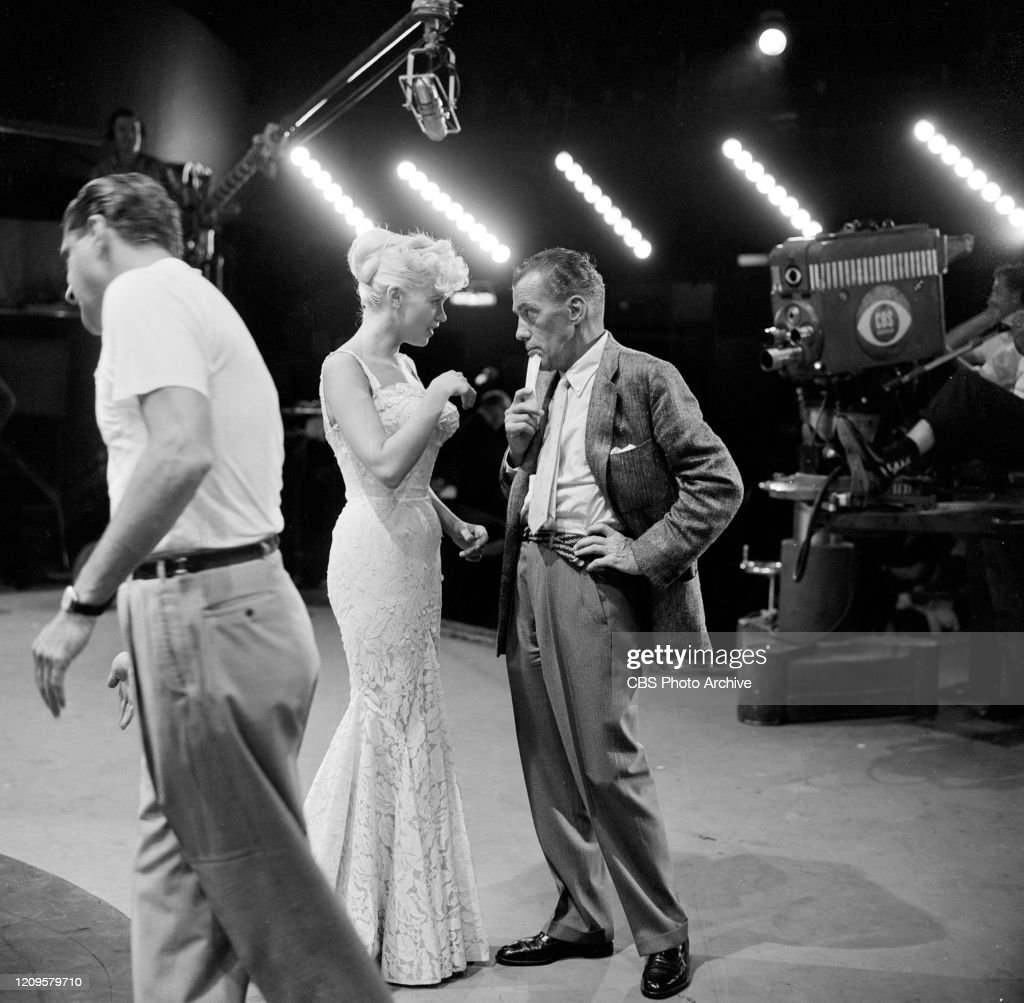
NEW YORK – AUGUST 11: Jayne Mansfield appears with Ed Sullivan on “The Ed Sullivan Show” on August 11, 1957. (Photo by CBS via Getty Images)
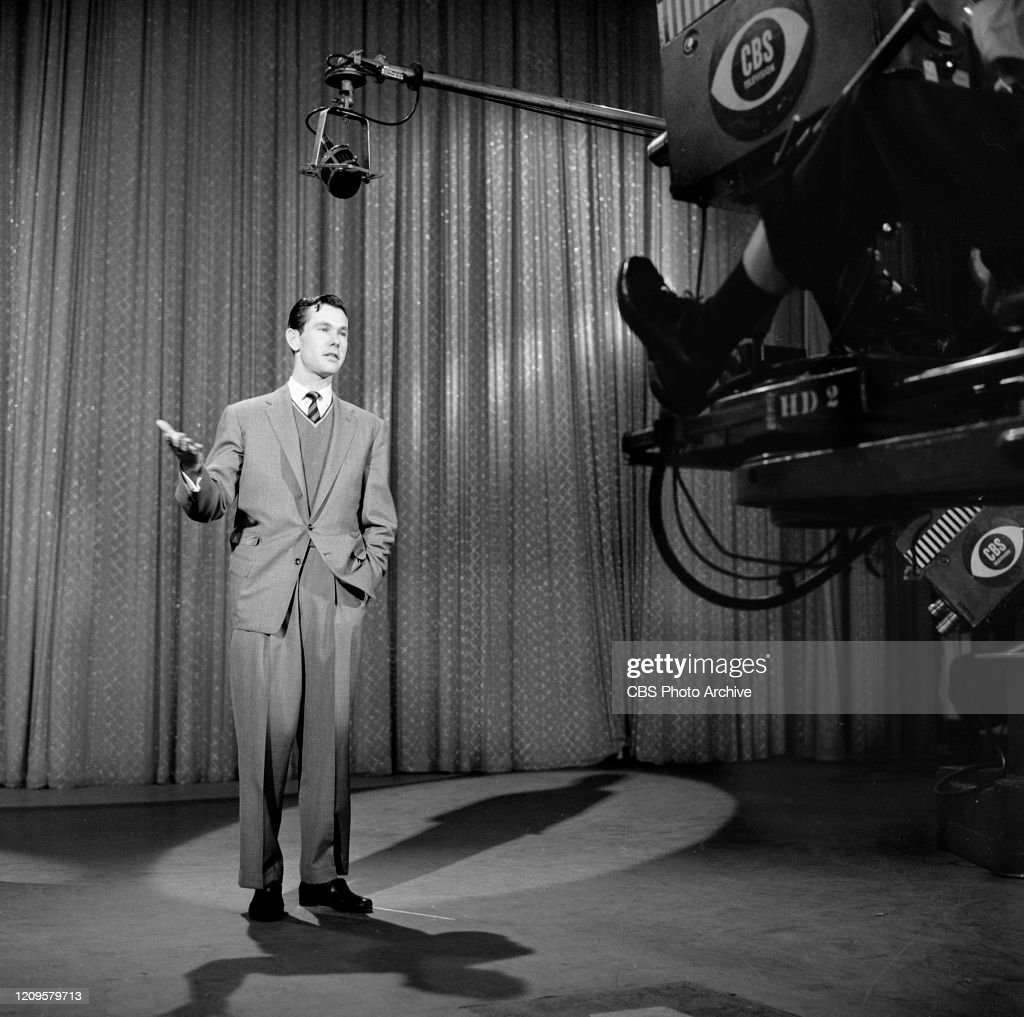
NEW YORK – FEBRUARY 10: Johnny Carson performs on “The Ed Sullivan Show” on February 10, 1957. (Photo by CBS via Getty Images)
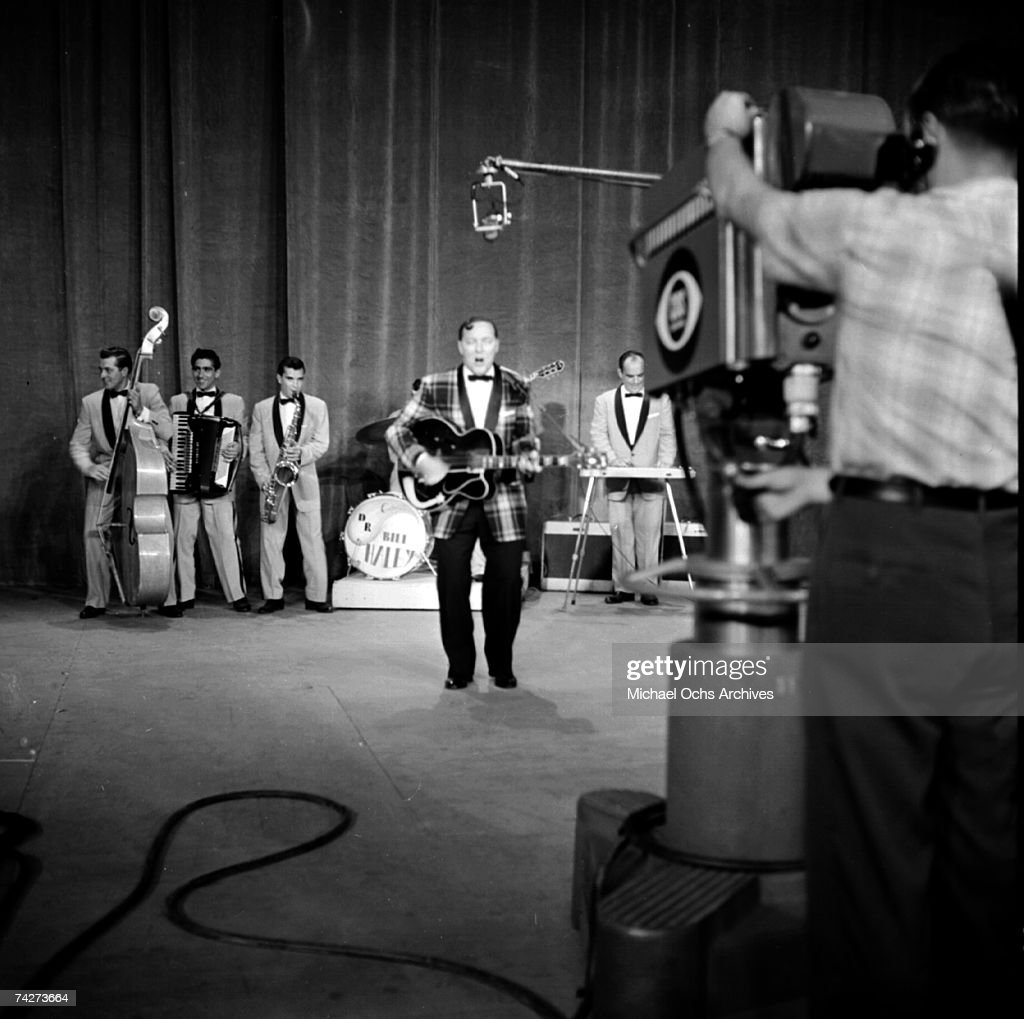
NEW YORK – AUGUST 07: Bill Haley and His Comets perform on The Ed Sullivan Show on August 7, 1955 in New York, New York City. (Photo by Steve Oroz/Michael Ochs Archives/Getty Images)
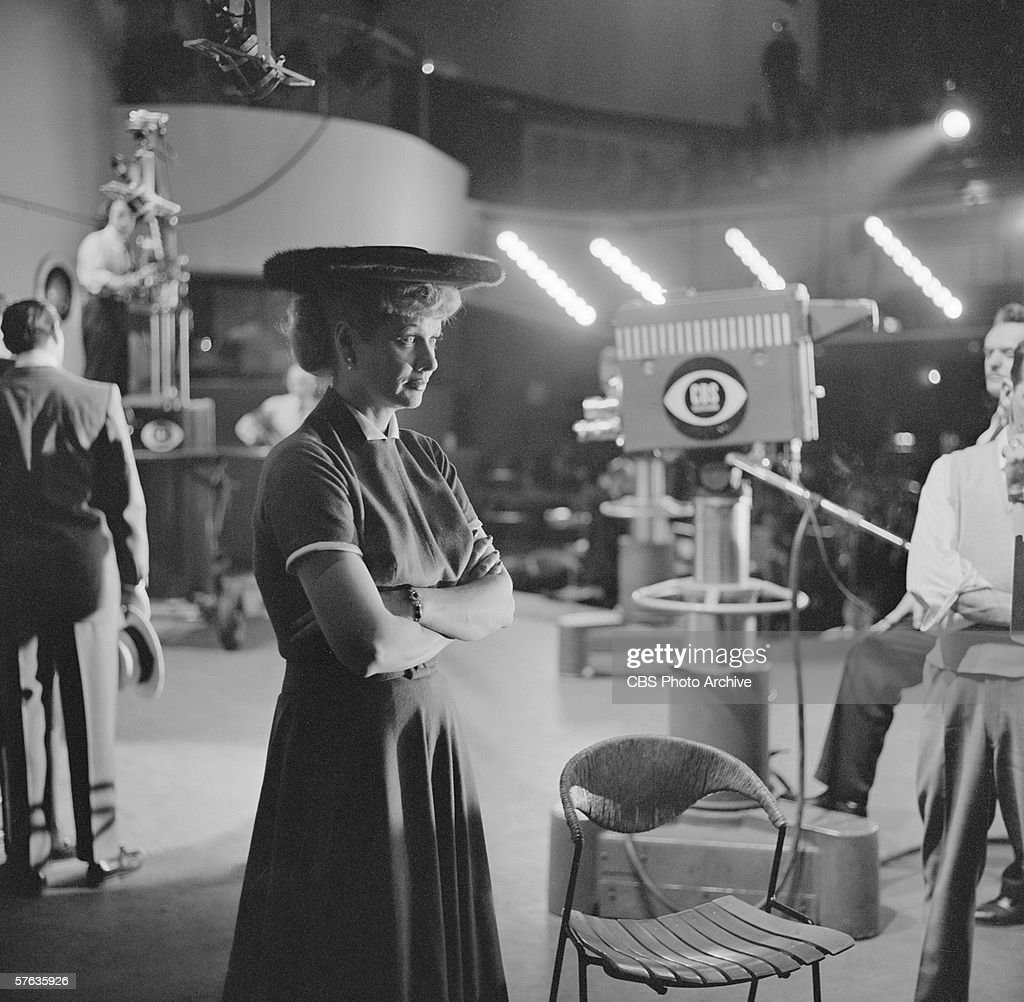
American comedian and actress Lucille Ball (1911 – 1989) stands on the side of the stage at ‘The Ed Sullivan Show,’ New York, New York, February 5, 1956. (Photo by CBS Photo Archive/Getty Images)

NEW YORK – JANUARY 20: Ed Sullivan hosts “Toast of the Town” on January 20, 1952. (Photo by CBS via Getty Images)
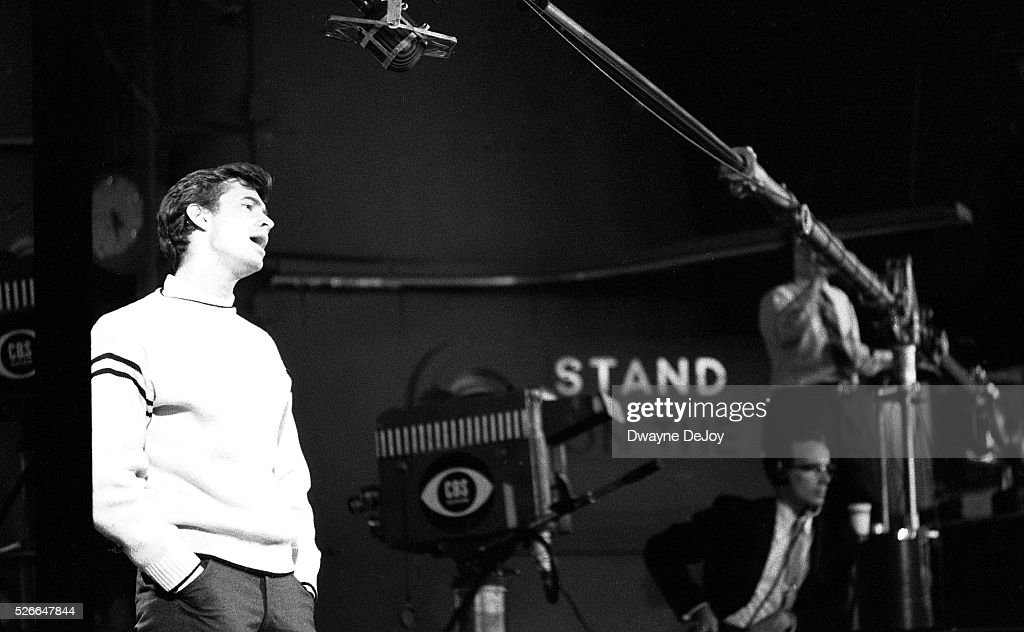
Anthony Perkins, 1957, Ed Sullivan Show at the Sullivan Theatre, NYC, NY Singing (Photo by Dwayne and Gina DeJoy/Corbis via Getty Images)
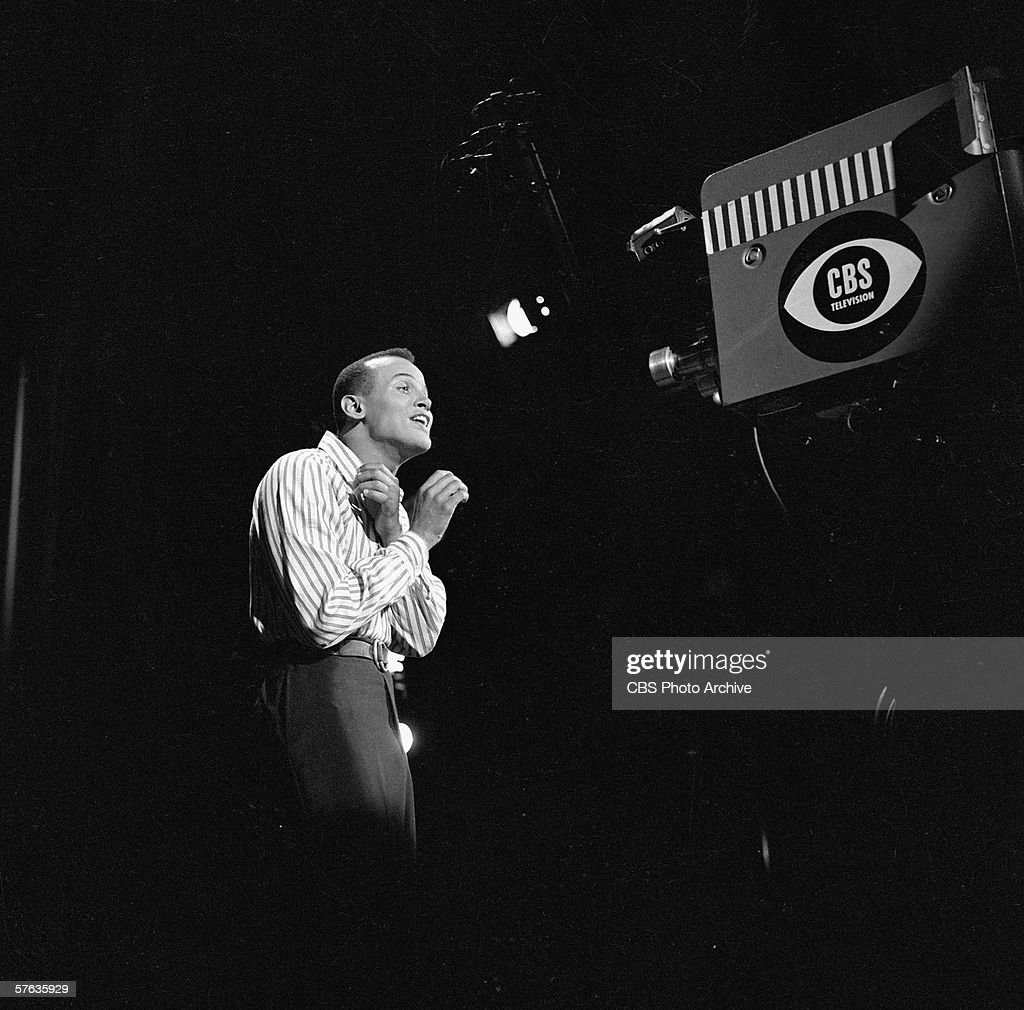
American singer and musician Harry Belafonte sings to the camera on ‘The Ed Sullivan Show,’ New York, New York, October 11, 1953. (Photo by CBS Photo Archive/Getty Images)
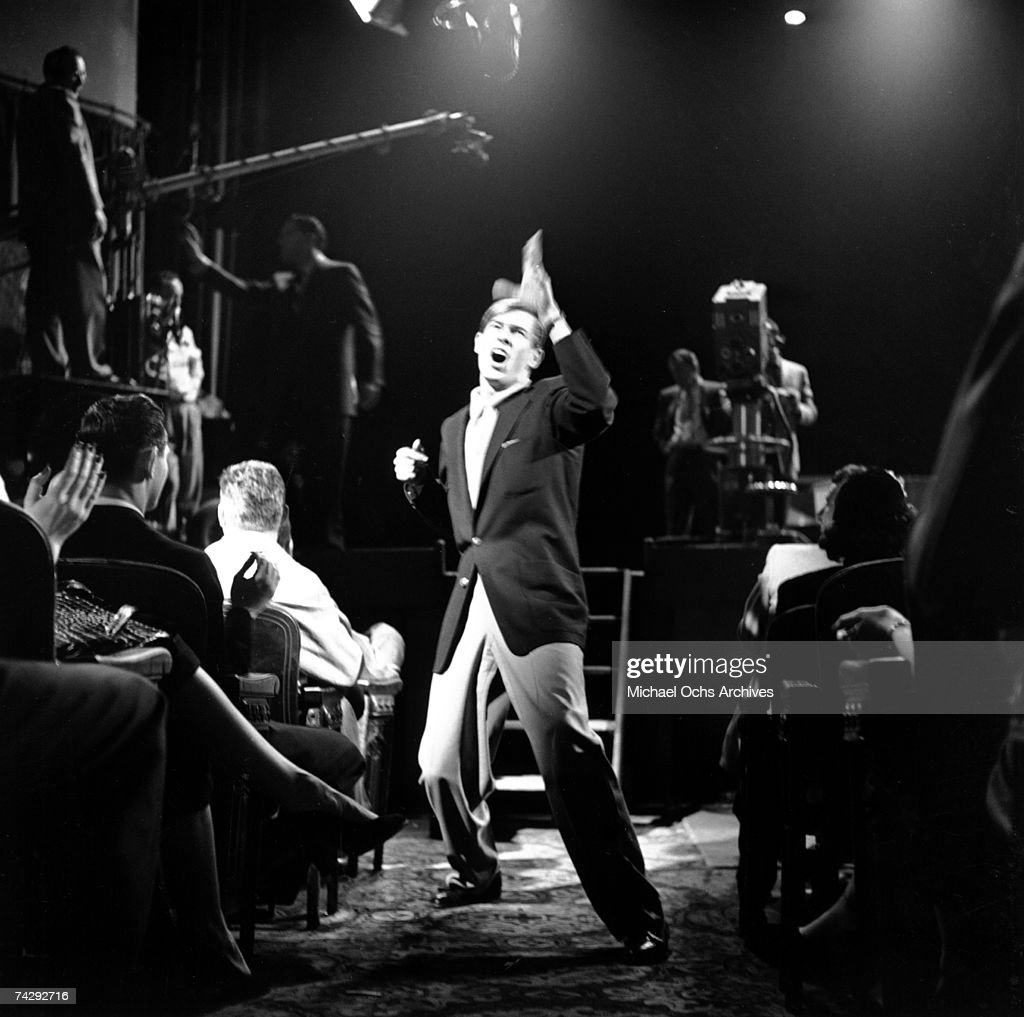
NEW YORK – MARCH 1: American singer-songwriter and musician Johnnie Ray (1927 – 1990) performs on the Ed Sullivan Show on March 1, 1953 in New York City, New York. (Photo by Steve Oroz/Michael Ochs Archives/Getty Images)
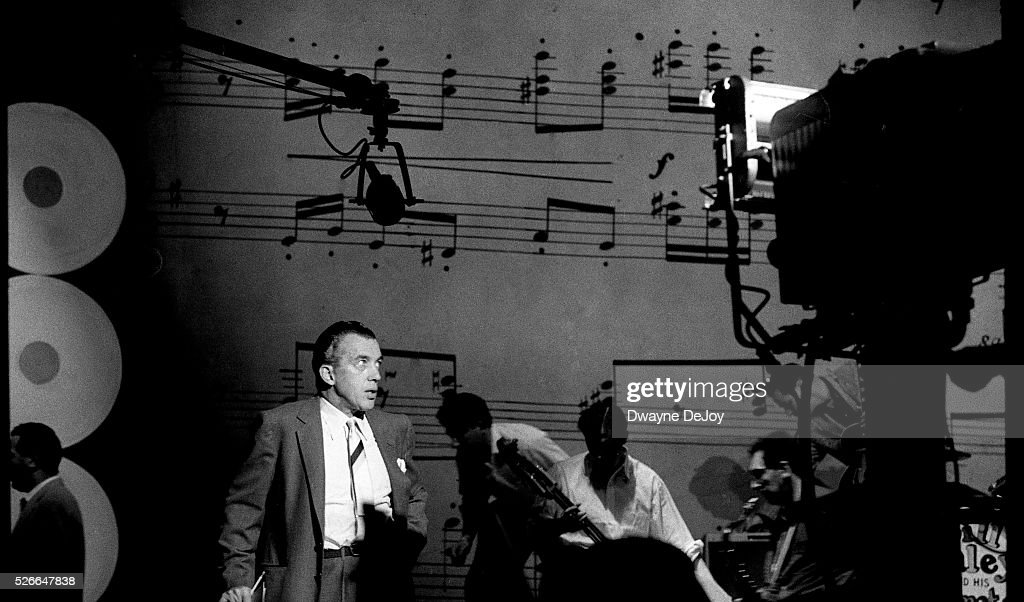
Ed Sullivan, on the Television Show, 1957 NYC, Ed Sullivan Theater (Photo by Dwayne and Gina DeJoy/Corbis via Getty Images)
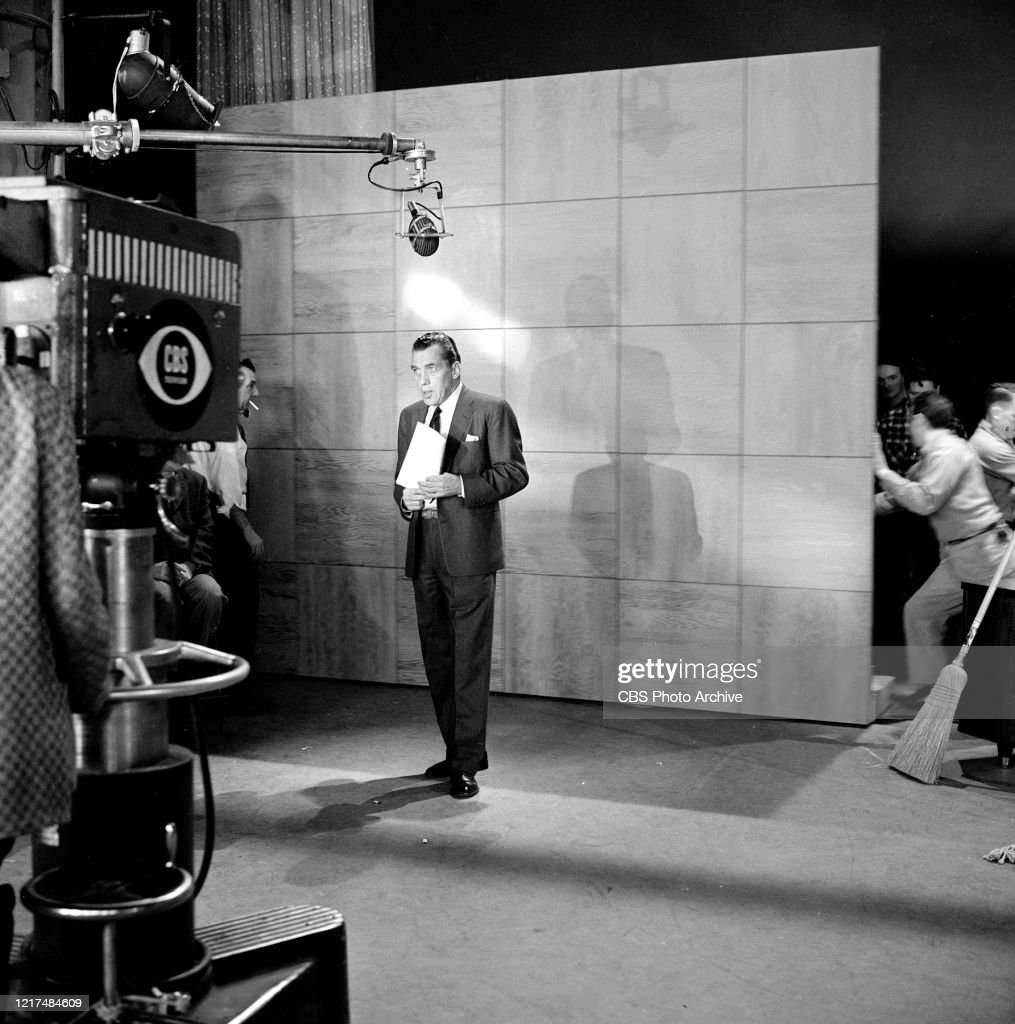
LOS ANGELES – JANUARY 14: Ed Sullivan is seen on set of “The Ed Sullivan Show” on January 14, 1957. (Photo by CBS via Getty Images)
FRANKLY, I think the photo above is mislabled and is acutally in Studio 50 as the man with the cigarette to Ed’s right is NYC Stage Manager Eddie Brinkman.

American television personality Ed Sullivan (1902 – 1974) on the set of his show ‘Talk of the Town, New York, New York, June 26, 1955. (Photo by CBS Photo Archive/Getty Images)
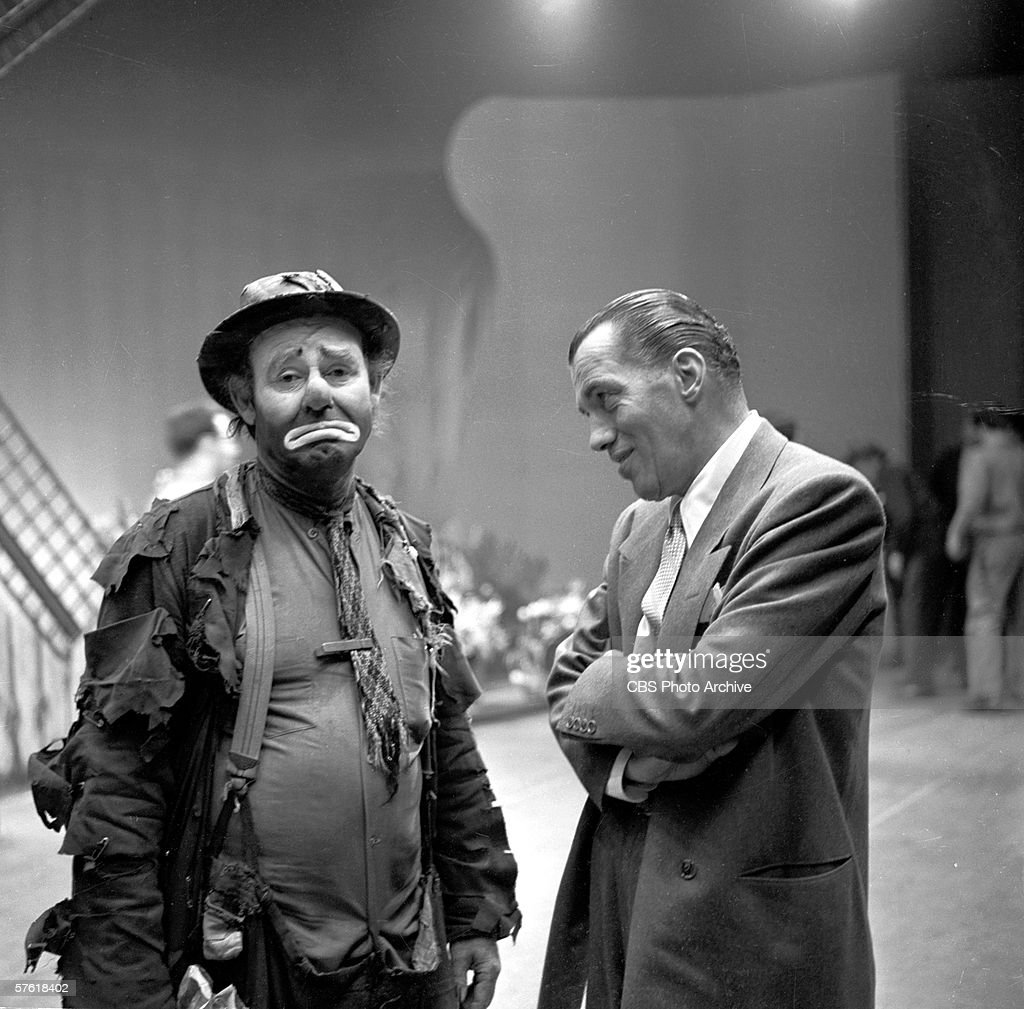
American television personality Ed Sullivan (1902 – 1974) (left) jokes with a clown from the Ringling Brothers Circus on his program, ‘The Ed Sullivan Show,’ New York, New York, April 5, 1953. (Photo by CBS Photo Archive/Getty Images)


Behind The Scenes at THE ED SULLIVAN SHOW…Part 3 (of 7)
The RCA TK31 Era: This third part features the RCA TK31 Studio Cameras that came out in May of 1952. These look like TK30s with chrome handles. Most of these images are dated 1958, but CBS was using the TK31s as early as 1953 at studio 50. NOTICE…the last 3 photos here show an update to the theater including new RCA big screen projection system for the audience and new audio system. (THE TOAST OF THE TOWN ran from 1948-1955 when the name changed to THE ED SULLIVAN SHOW).
These historical images are from the CBS Photo Archives available through Getty Images and are presented here to assist researchers and television historians in identifying the television equipment in use over the decades and is offered here in a purely educational/instructional forum.

NEW YORK – JANUARY 12: January 12, 1958 James Arness on set of THE ED SULLIVAN SHOW. (Photo by CBS via Getty Images)

NEW YORK – JANUARY 12: January 12, 1958 James Arness talks with Ed Sullivan on THE ED SULLIVAN SHOW. (Photo by CBS via Getty Images)
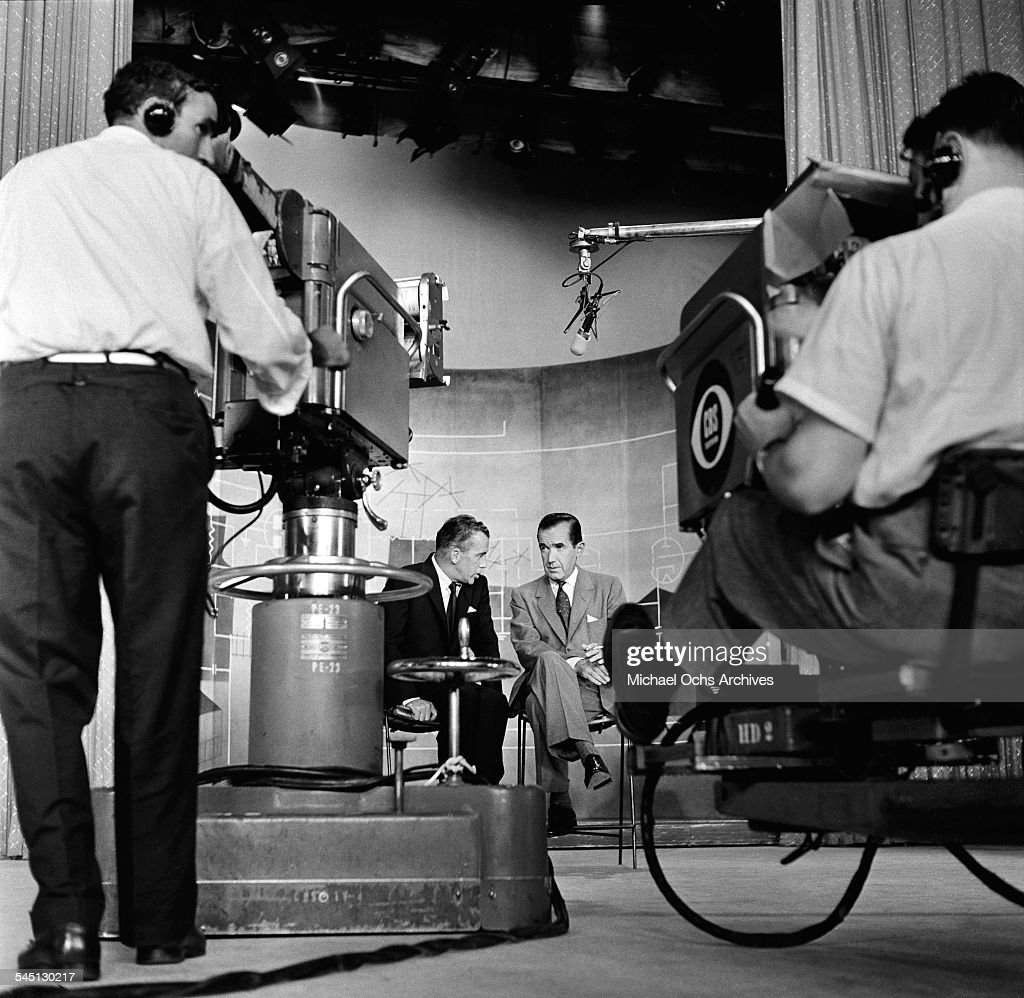
NEW YORK – SEPTEMBER 21,1958: Ed Sullivan sits and interviews Edward R. Murrow on the “Toast of the Town” show hosted by Ed Sullivan at the Maxine Elliott Theater in New York, New York.(Photo by Steve Oroz/Michael Ochs Archives/Getty Images)
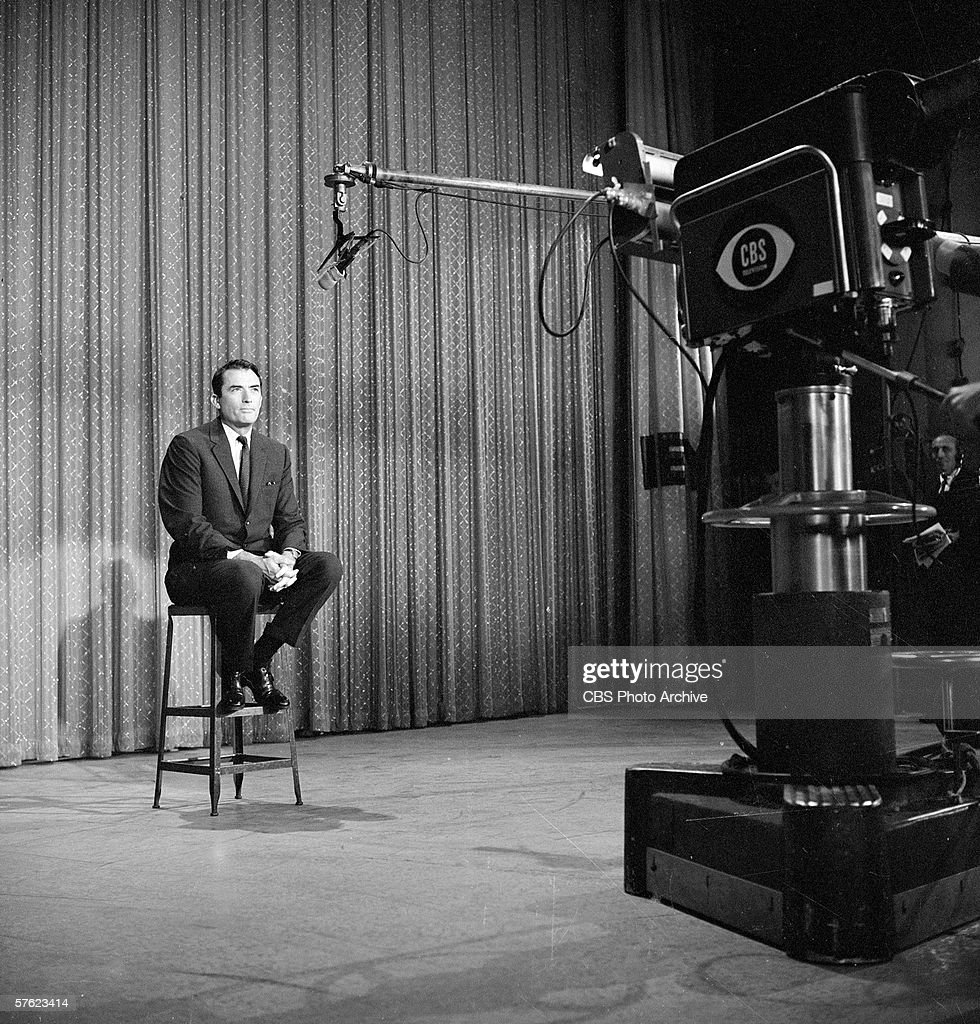
American film actor Gregory Peck (1916 – 2003) sits on a stool with his hands clasped as he appears on Ed Sullivan’s CBS variety show ‘Toast of the Town,’ New York, August 17, 1958. (Photo by CBS Photo Archive/Getty Images)

NEW YORK – JULY 9: CBS Television Studio 50 (1697 Broadway at West 53rd Street, New York, NY.) Photo taken after recent installation of microphones, speakers and television equipment. This space is later known as The Ed Sullivan Theater. Image dated July 9, 1958. (Photo by CBS via Getty Images)

NEW YORK – JULY 9: CBS Television Studio 50 (1697 Broadway at West 53rd Street, New York, NY.) Photo taken after recent installation of microphones, speakers and television equipment. This space is later known as The Ed Sullivan Theater. Image dated July 9, 1958. (Photo by CBS via Getty Images)

NEW YORK – JULY 9: CBS Television Studio 50 (1697 Broadway at West 53rd Street, New York, NY.) Photo taken after recent installation of microphones, speakers and television equipment. This space is later known as The Ed Sullivan Theater. Image dated July 9, 1958. (Photo by CBS via Getty Images)


Behind The Scenes of THE ED SULLIVAN SHOW…Part 4 (of 7)
The Marconi Mark IV Era: This is the largest section as it features the era of the Marconi Mark IV black and white cameras and The Beatles and begins in 1960. The BIG difference was the picture clarity as this new camera used a 4 1/2 inch Image Orthicon tube, where as all cameras before this used a 3 inch Image Orthicon. CBS coverd the 1960 elections with new Marconi Mark IVs at their old Grand Cenetral studos so I’m sure Studio 50 had them soon after.
Midway down, there are about 5 or 6 photos from The Beatles Miami performance which are included to show the first ever use of a hand held camera for entertainment purposes (as opposed to news or sports), and the hand held was a special development project between CBS and Ikegami. The big cameras in Miami are RCA TK30s which belong to CBS Miami affiliate WTVJ.
NOTICE THE VERY FIRST BEATLES PHOTO (10th one down)…IT WAS TAKEN DURING REHEARSAL WHEN GEORGE HARRISON WAS SICK AND TOUR MANAGER NEIL ASPINALL WAS STANDING IN FOR GEORGE, WHO RECOVERED IN TIME FOR THE TAPING.
These historical images are from the CBS Photo Archives available through Getty Images and are presented here to assist researchers and television historians in identifying the television equipment in use over the decades and is offered here in a purely educational/instructional forum.
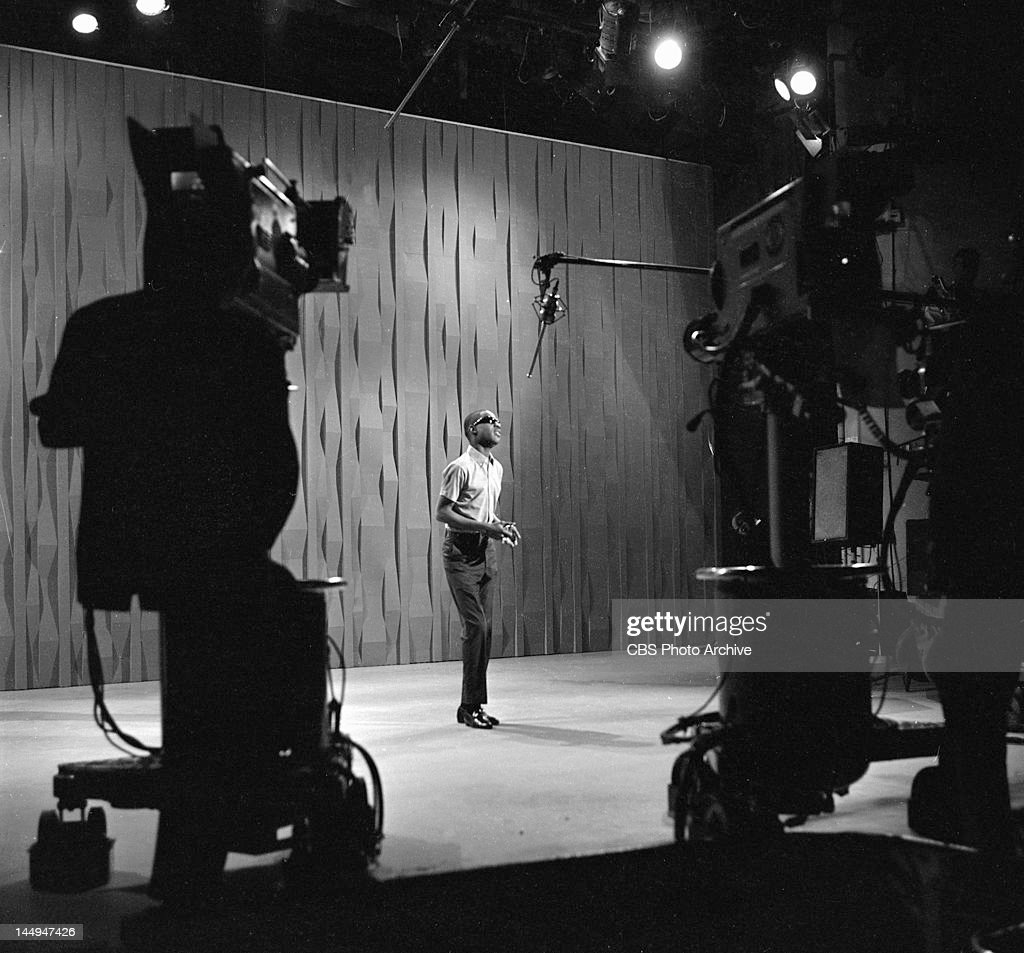
NEW YORK – MAY 3: A young Stevie Wonder during rehearsals for THE ED SULLIVAN SHOW. Image dated May 3, 1964. (Photo by CBS via Getty Images)

NEW YORK – OCTOBER 7: Paul Anka performs on “The Ed Sullivan Show,” a CBS television variety program. Broadcast Sunday, October 7, 1962. (Photo by CBS via Getty Images)

NEW YORK – OCTOBER 7: Peter Duchin and his orchestra perform on “The Ed Sullivan Show,” a CBS television variety program. Broadcast Sunday, October 7, 1962. (Photo by CBS via Getty Images)

NEW YORK – OCTOBER 7: Paul Anka performs on “The Ed Sullivan Show,” a CBS television variety program. Broadcast Sunday, October 7, 1962. (Photo by CBS via Getty Images)
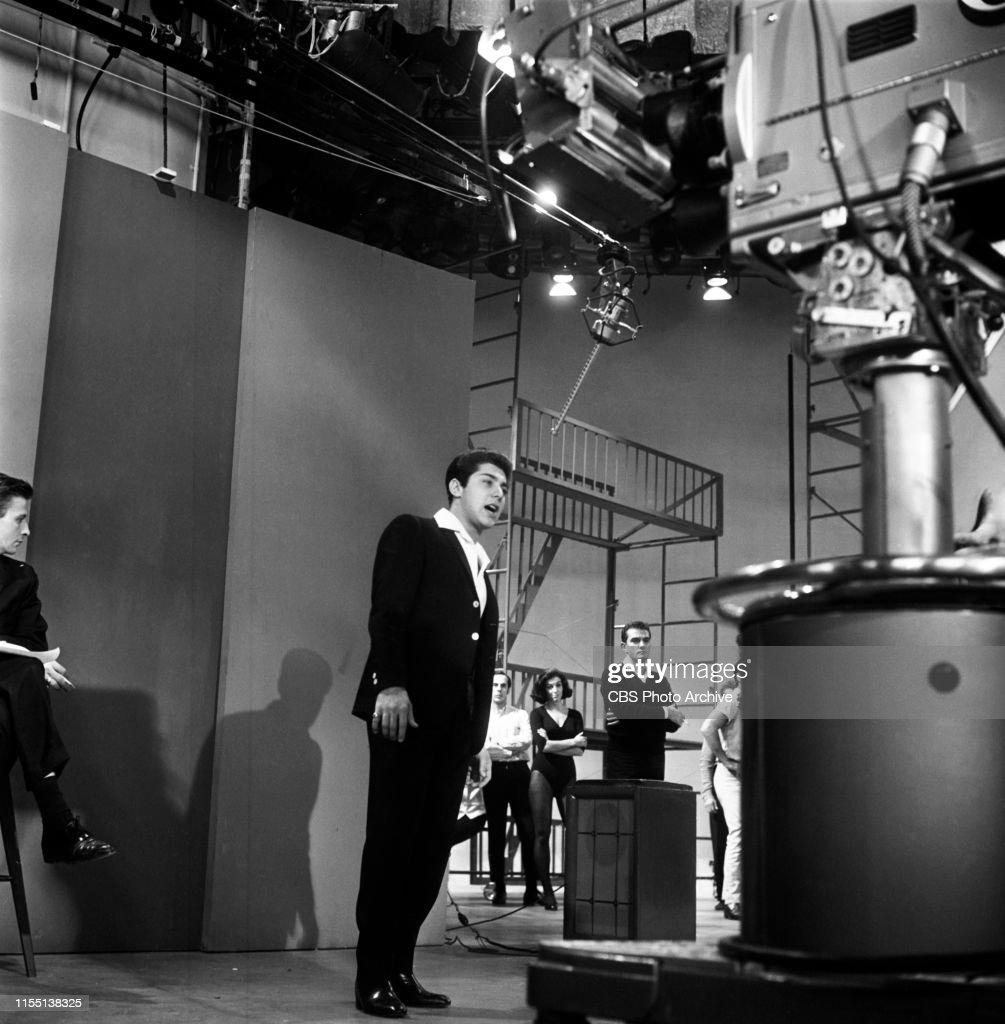
NEW YORK – OCTOBER 7: Paul Anka performs on “The Ed Sullivan Show,” a CBS television variety program. Broadcast Sunday, October 7, 1962. (Photo by CBS via Getty Images)
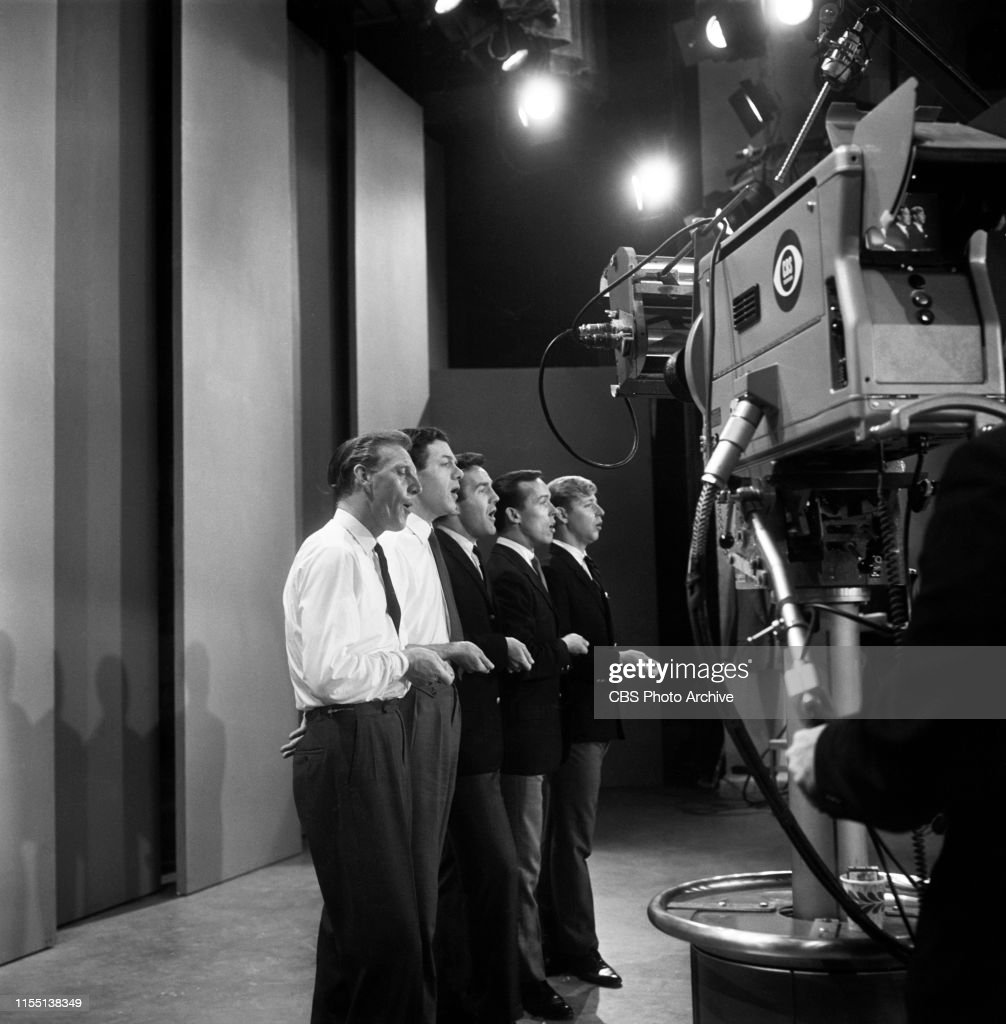
NEW YORK – OCTOBER 7: (Pictured left to right) Denny Willis and his Hunting Quartet perform on “The Ed Sullivan Show,” a CBS television variety program. Broadcast Sunday, October 7, 1962. (Photo by CBS via Getty Images)
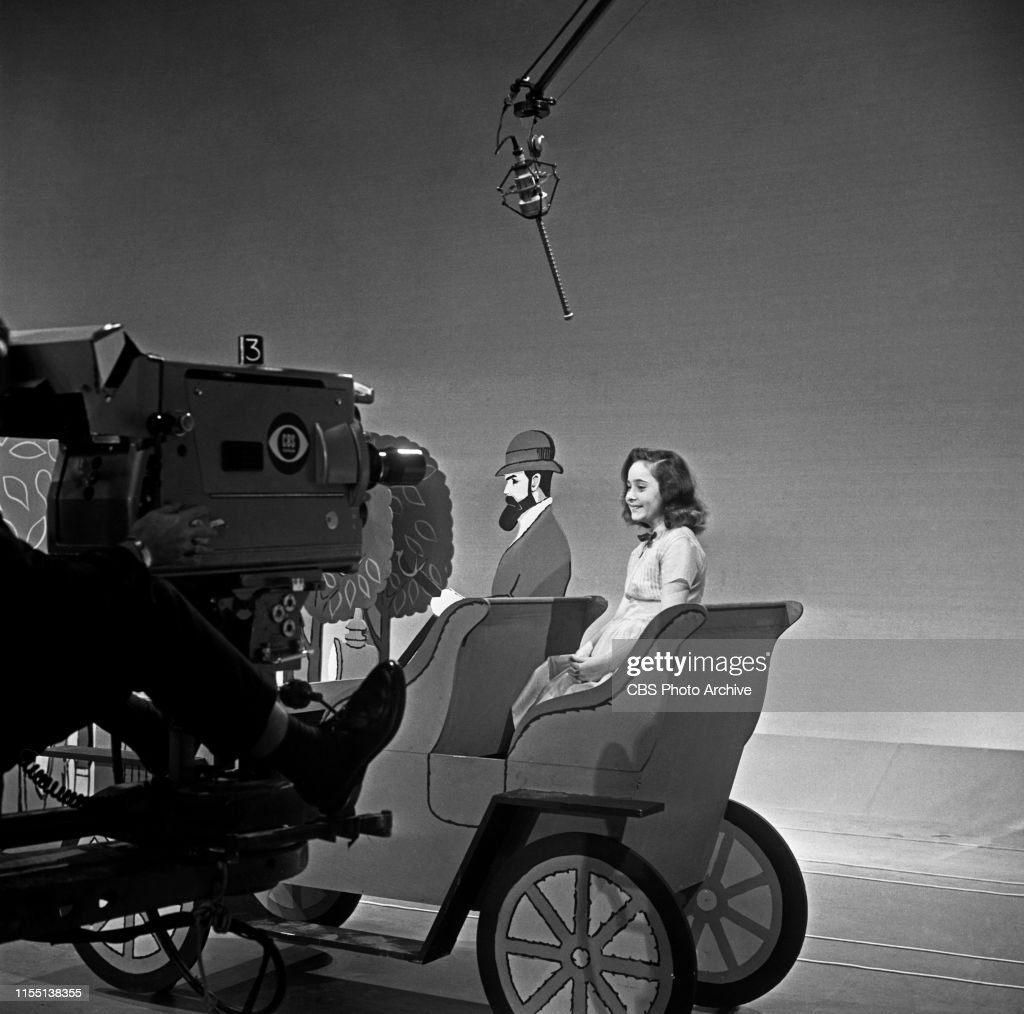
NEW YORK – OCTOBER 7: Yolanda White performs on “The Ed Sullivan Show,” a CBS television variety program. Broadcast Sunday, October 7, 1962. (Photo by CBS via Getty Images)
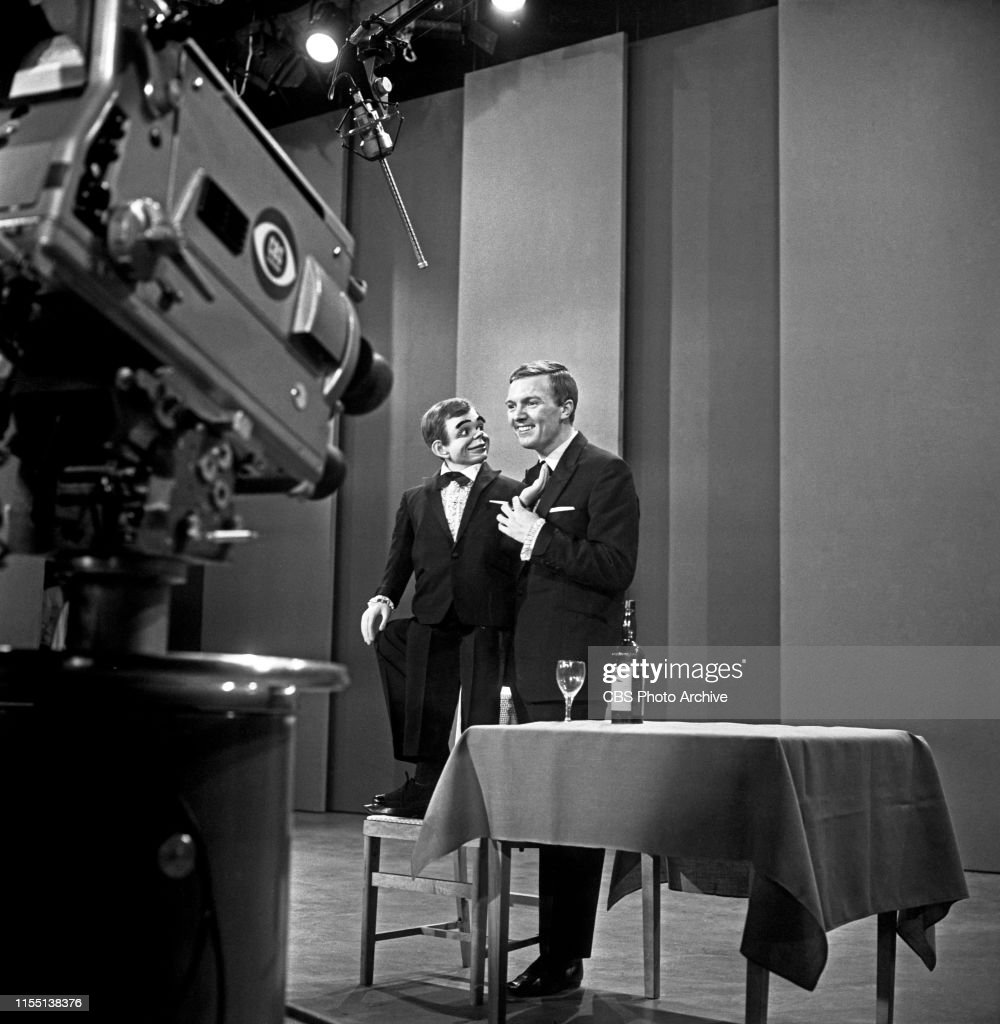
NEW YORK – OCTOBER 7: Ventriloquist Dennis Spicer and his smooth-talking dummy James Green perform on “The Ed Sullivan Show,” a CBS television variety program. Broadcast Sunday, October 7, 1962. (Photo by CBS via Getty Images)

NEW YORK – OCTOBER 7: Paul Anka performs on “The Ed Sullivan Show,” a CBS television variety program. Broadcast Sunday, October 7, 1962. (Photo by CBS via Getty Images)

NEW YORK – FEBRUARY 8: The Beatles at rehearsal the day before their first appearance on THE ED SULLIVAN SHOW. From left: Paul McCartney, Neil Aspinall (standing in for a sick George Harrison), John Lennon and Ringo Starr on the drums. Image dated February 8, 1964. (Photo by CBS via Getty Images)
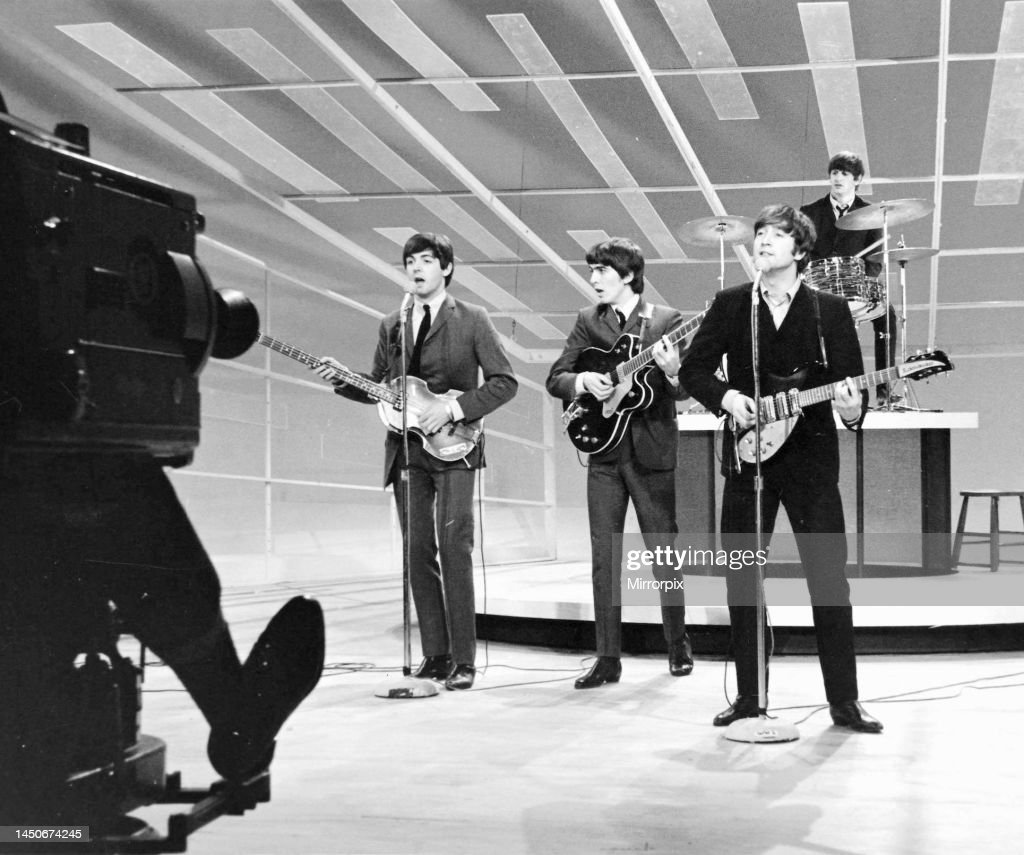
The Beatles rehearse their appearance on the Ed Sullivan Show. 8th February 1964. (Photo by Daily Mirror/Daily Mirror/Mirrorpix via Getty Images)

Camera rehearsals for the Beatles first appearance on ‘The Ed Sullivan Show’, CBS Studio 50, New York City. 9th February 1964. (Photo by Daily Mirror/Daily Mirror/Mirrorpix via Getty Images)
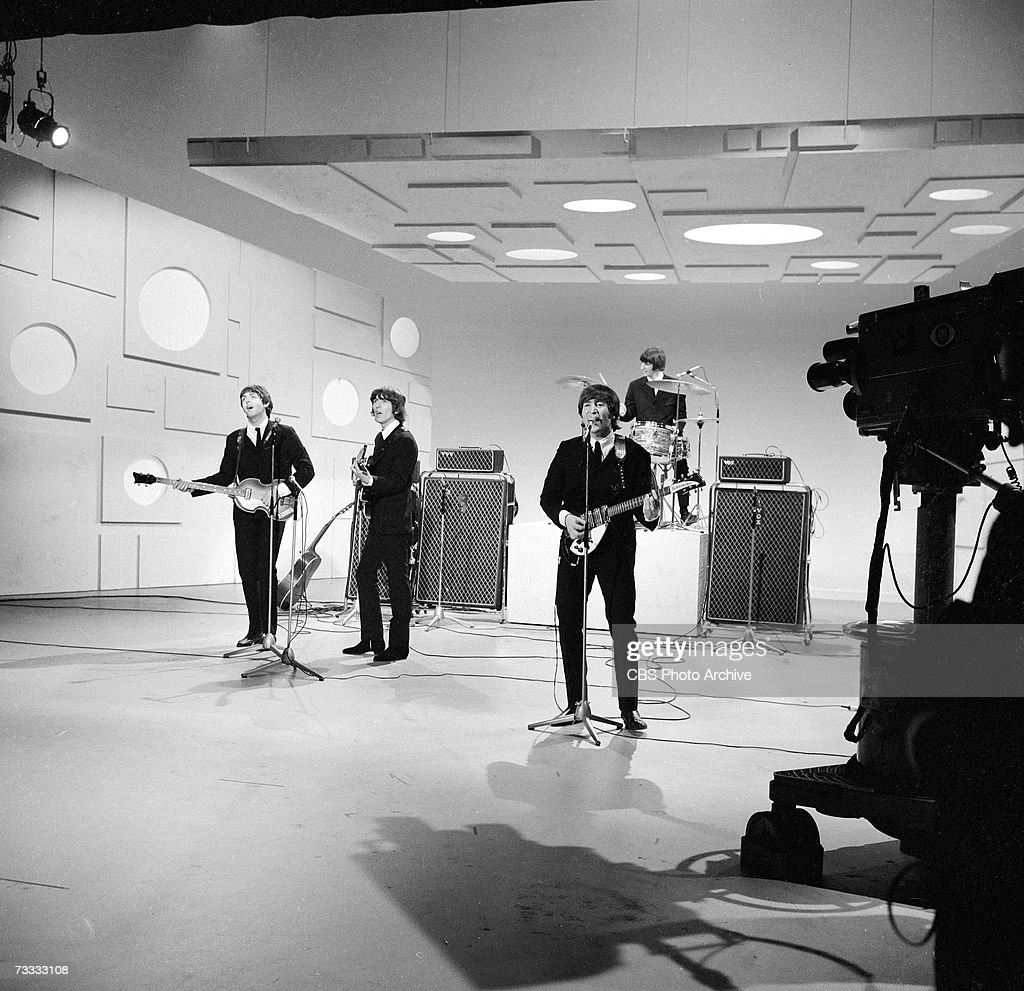
Members of the British rock band The Beatles, (left to right) Paul McCartney, George Harrison (1943 – 2001), Ringo Starr, and John Lennon (1940 – 1980), sing into microphones as they play their instruments at the taping of a segment for ‘Toast of the Town,’ the CBS variety program hosted by Ed Sullivan, New York, August 14, 1965. The segment aired as part of Sullivan’s 19th season opener on September 12, 1965. (Photo by CBS Photo Archive/Getty Images)
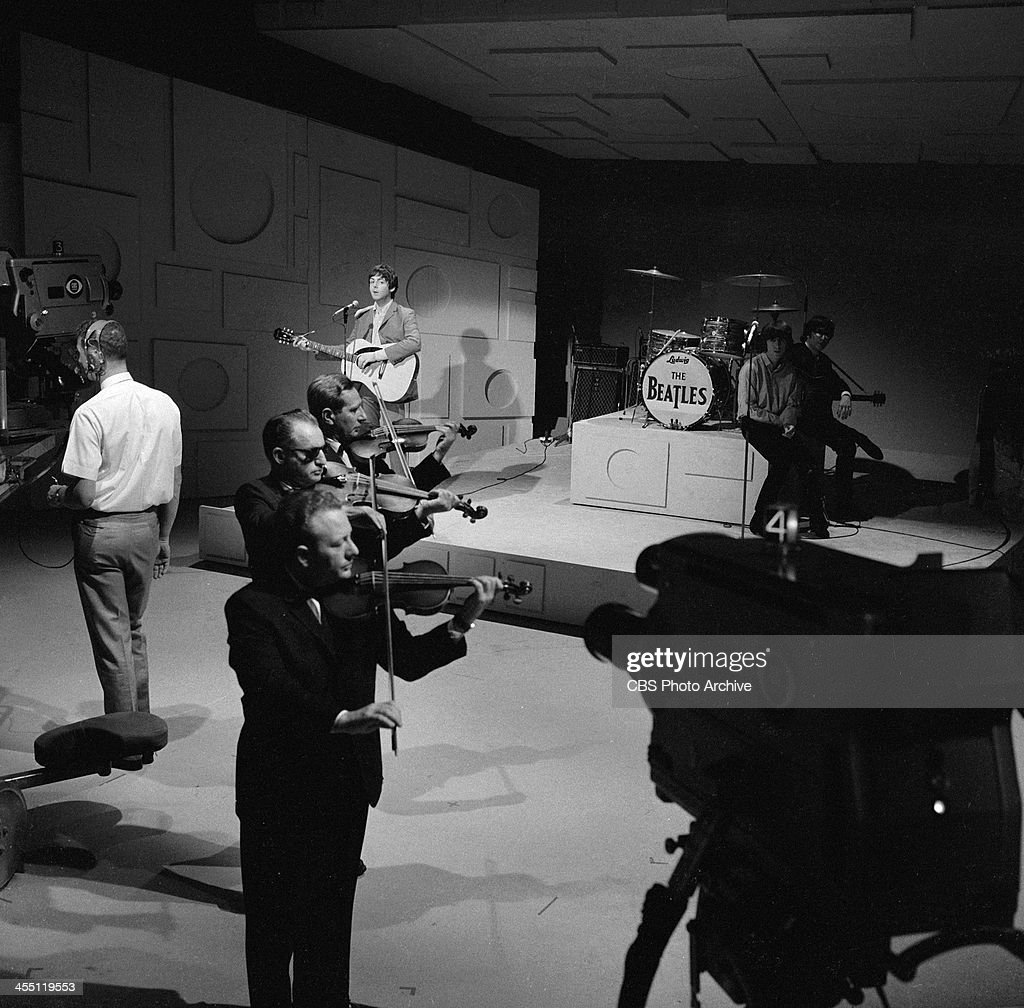
NEW YORK – AUGUST 14: The Beatles at rehearsal for their final performance on THE ED SULLIVAN SHOW. Image dated August 14, 1965. Paul McCartney playing with violins while George Harrison and John Lennon watch from the side. (Photo by CBS via Getty Images)
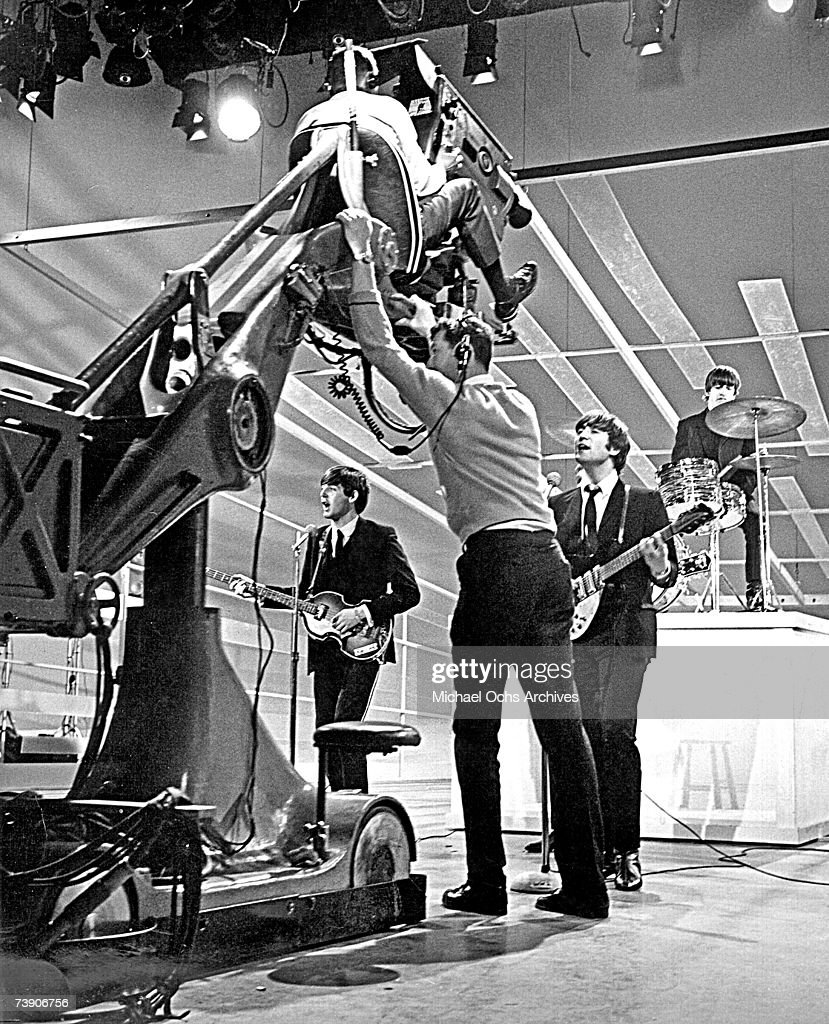
NEW YORK – FEBRUARY 9: Bassist Paul McCartney, guitarist John Lennon and Drummer Ringo Starr of the rock and roll band “The Beatles” prepare for their performance on “The Ed Sullivan Show” on February 9, 1964 in New York City, New York. (Photo by Michael Ochs Archives/Getty Images)
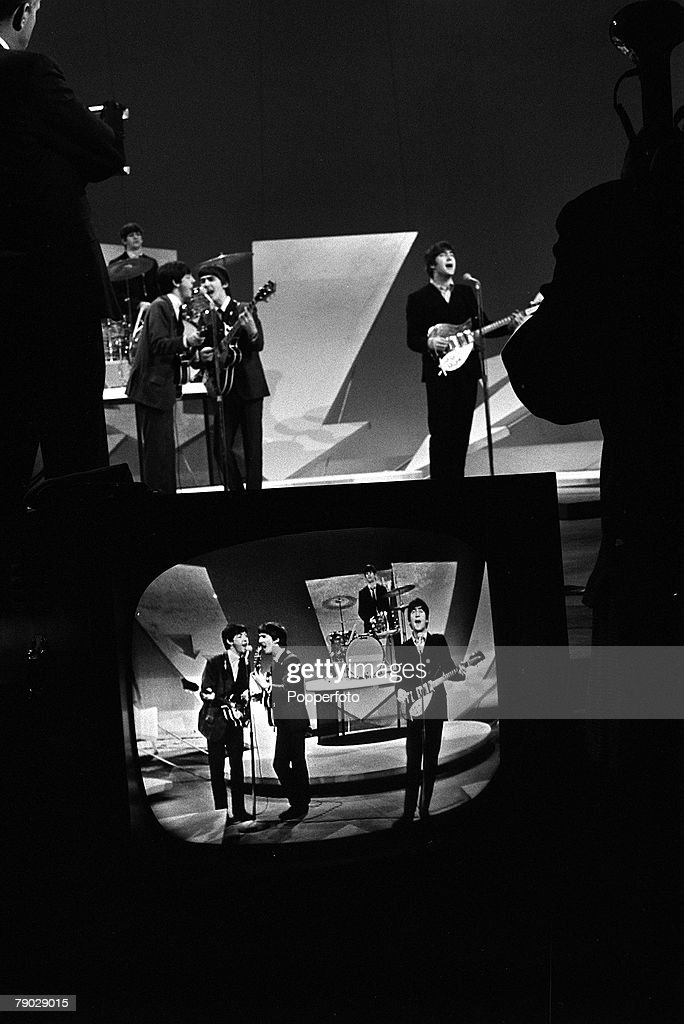
10th February 1964, New York, USA, British pop group The Beatles play live on The Ed Sullivan Show (Photo by Popperfoto via Getty Images/Getty Images)

NEW YORK – FEBRUARY 9: THE ED SULLIVAN SHOW featuring The Beatles, performed on Sunday, February 9, 1964, from CBS’s Studio 50 in New York City. Show host Ed Sullivan reviewing the teleprompter notes. (Photo by CBS via Getty Images)
SPECIAL NOTE ON THE PHOTO ABOVE: Meet Sullivan Associate Producer, Jacques Andre
On Sunday nights, between 8 and 9 PM, Jacques was the “middle man” on ‘The Ed Sullivan Show’. During the week, he worked for producer Bob Precht, but on show night, he stood with Ed at the side of the stage keeping the show’s running time and was the hub between the control room, stage manager Eddie Brinkmann and Sullivan. Although quite capable, he would always feel the need throw up before each show.
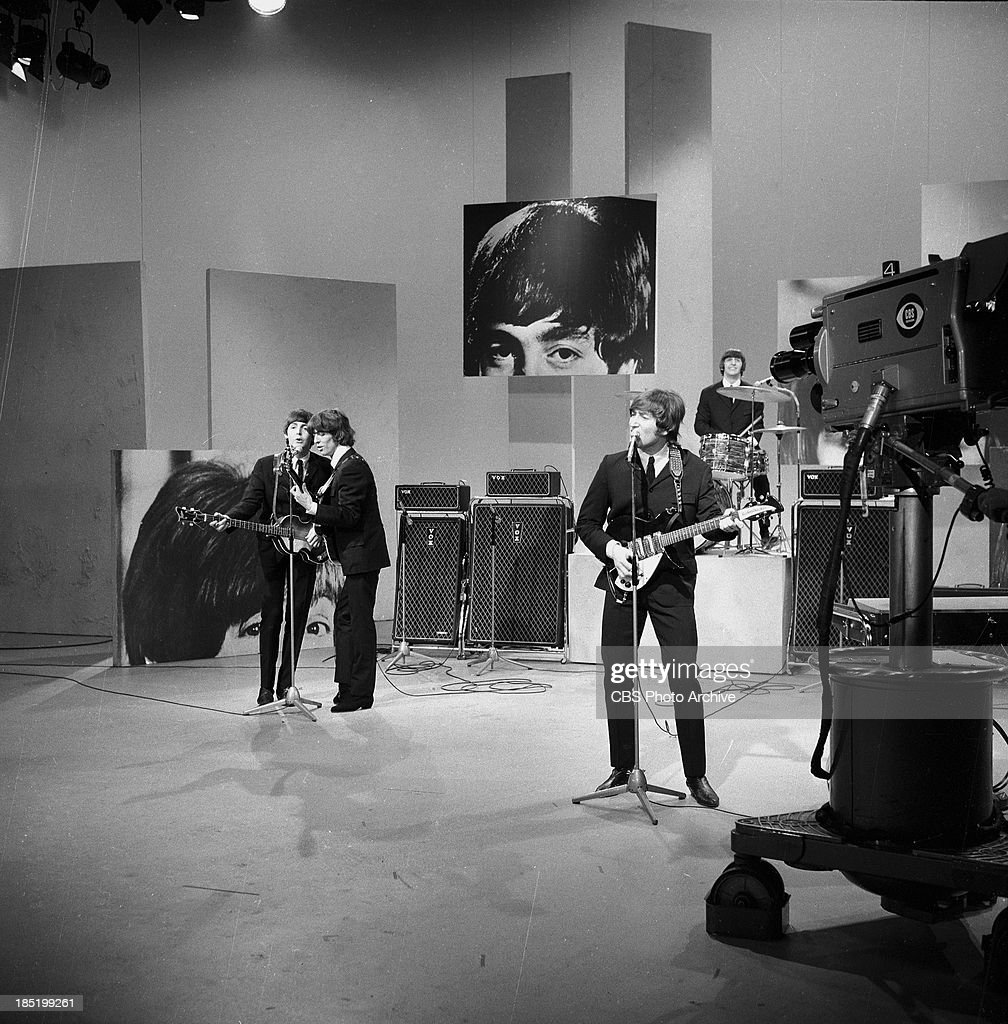
NEW YORK – AUGUST 14: The Beatles third appearance on The Ed Sullivan Show. Image dated August 14, 1965. From left: Paul McCartney, George Harrison, John Lennon, Ringo Starr. (Photo by CBS via Getty Images)
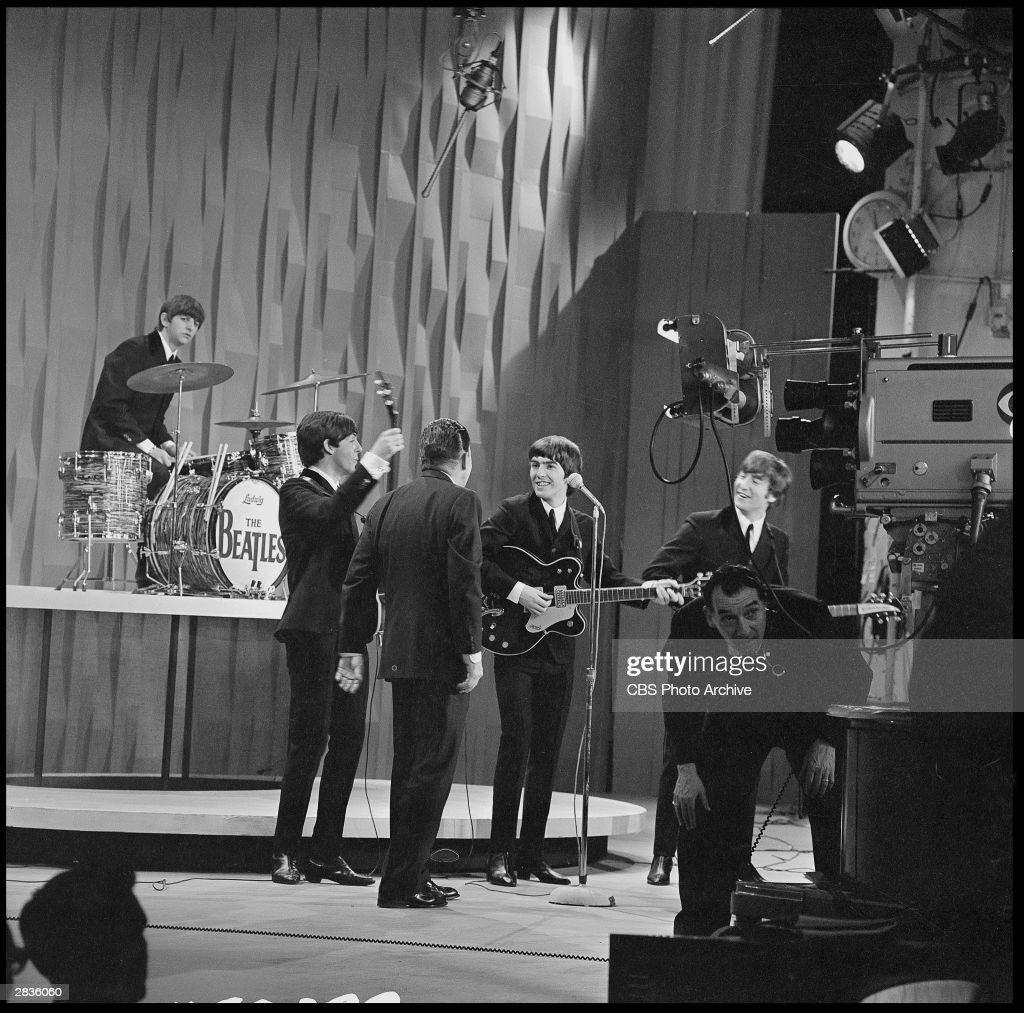
T’The Ed Sullivan Show’ featuring The Beatles, performed on Sunday, February 9, 1964, from CBS’s Studio 50 in New York City. Band members (from left) Ringo Starr (drummer), Paul McCartney, show host: Ed Sullivan, George Harrison and John Lennon. (Photo by CBS Photo Archive/Getty Images)
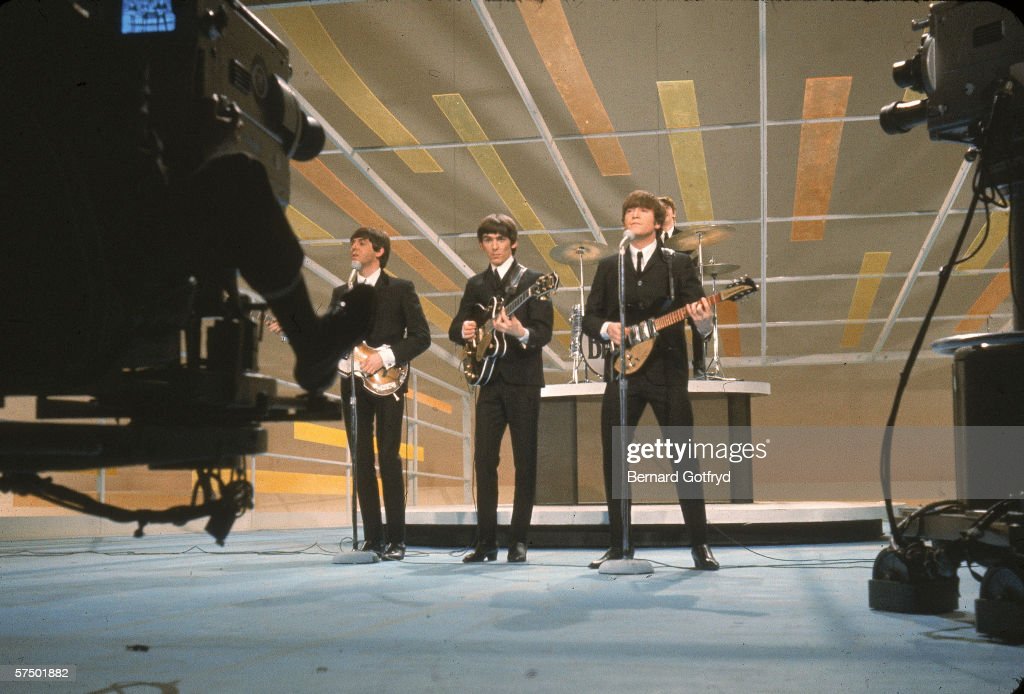
British pop and rock music group the Beatles perform on the television variety program, ‘The Ed Sullivan Show,’ New York, New York, February 9, 1964. From left, Paul McCartney, George Harrison (1943 – 2001), and John Lennon (1940 – 1980). Drummer Ringo Starr is obscured behind Lennon. (Photo by Bernard Gotfryd/Getty Images)
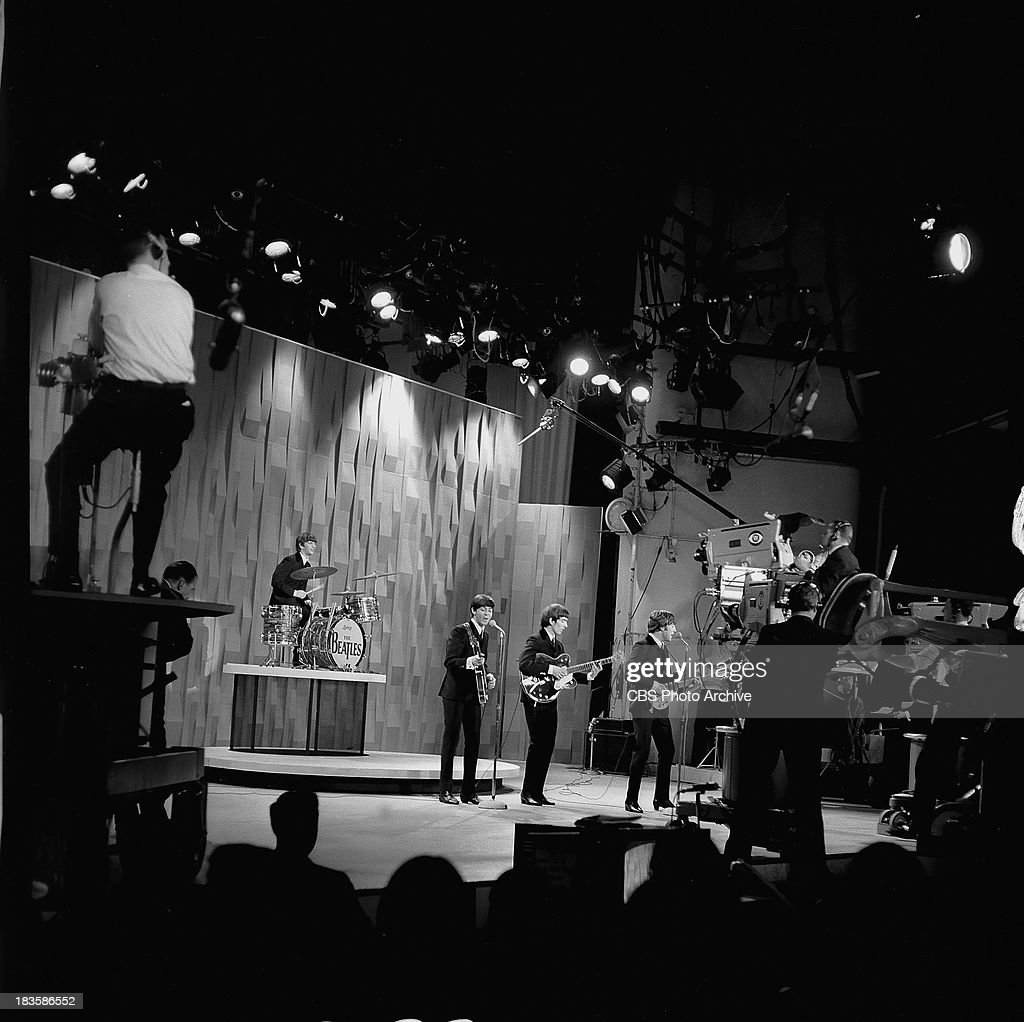
NEW YORK – FEBRUARY 9: THE ED SULLIVAN SHOW featuring The Beatles, performing on Sunday, February 9, 1964, from CBS’s Studio 50 in New York City. Band members (from left) Ringo Starr (drummer), Paul McCartney, George Harrison and John Lennon. (Photo by CBS via Getty Images)

NEW YORK – FEBRUARY 9: THE ED SULLIVAN SHOW featuring The Beatles, performing on Sunday, February 9, 1964, from CBS’s Studio 50 in New York City. Band members (from left) Ringo Starr (drummer), Paul McCartney, George Harrison and John Lennon. (Photo by CBS via Getty Images)
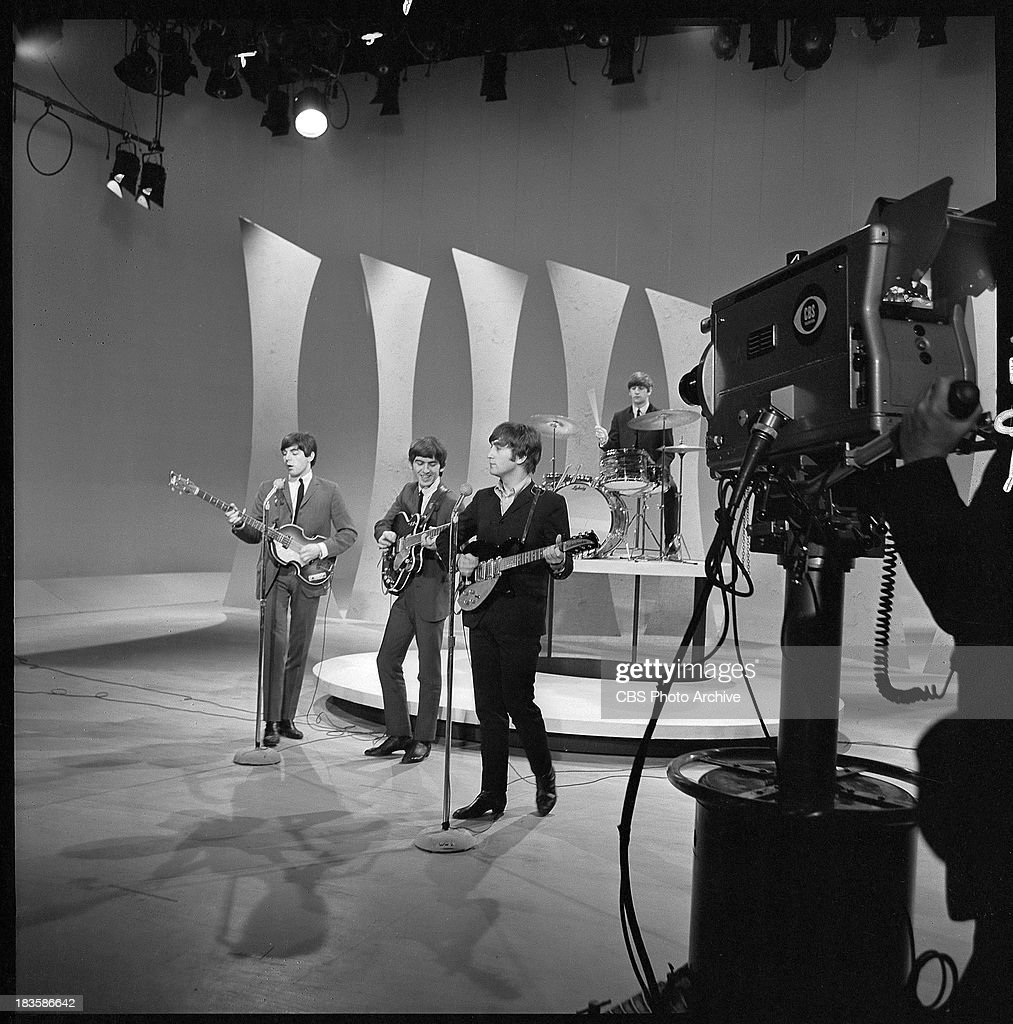
NEW YORK – FEBRUARY 9: THE ED SULLIVAN SHOW featuring The Beatles, performing on Sunday, February 9, 1964, from CBS’s Studio 50 in New York City. Band members (from left), Paul McCartney, George Harrison, John Lennon and Ringo Starr (drummer). (Photo by CBS via Getty Images)
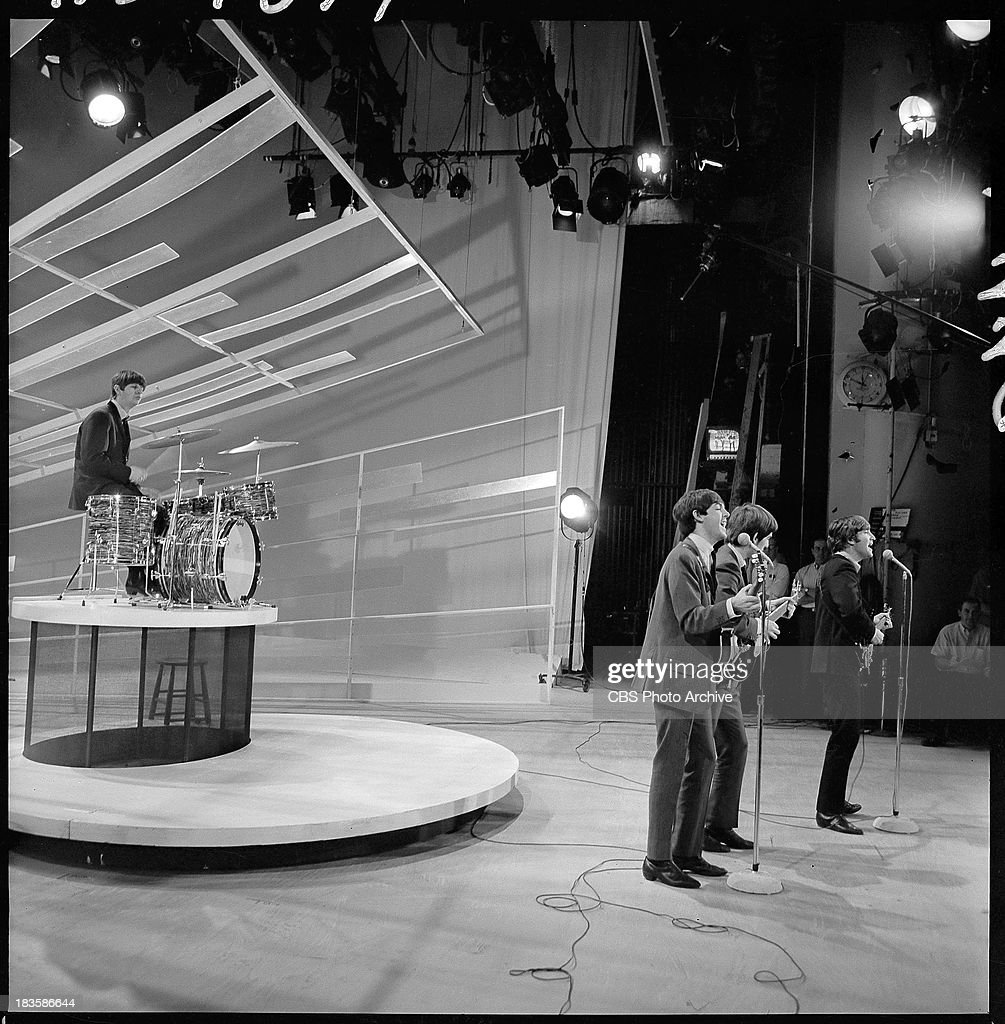
NEW YORK – FEBRUARY 9: THE ED SULLIVAN SHOW featuring The Beatles, performing on Sunday, February 9, 1964, from CBS’s Studio 50 in New York City. Band members (from left) Ringo Starr (drummer), Paul McCartney, George Harrison and John Lennon. (Photo by CBS via Getty Images)
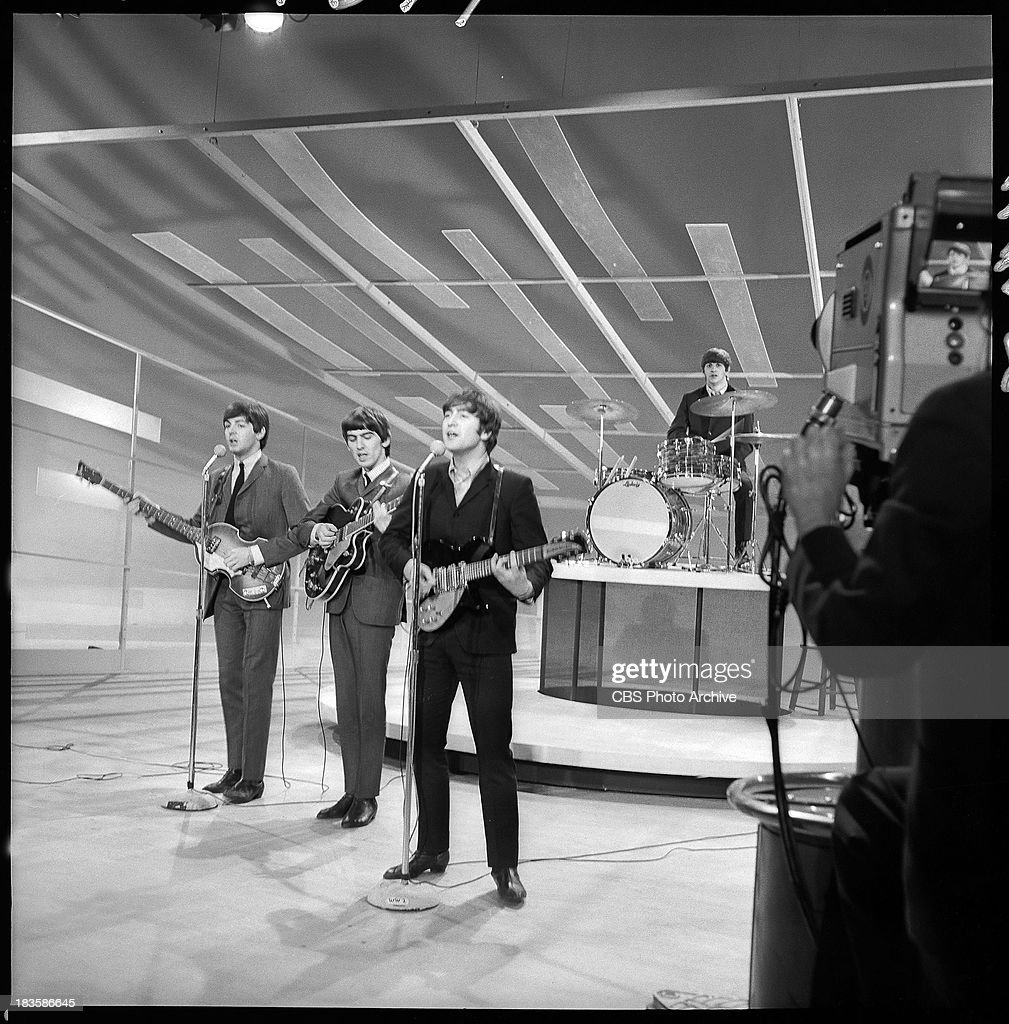
NEW YORK – FEBRUARY 9: THE ED SULLIVAN SHOW featuring The Beatles, performing on Sunday, February 9, 1964, from CBS’s Studio 50 in New York City. Band members (from left), Paul McCartney, George Harrison, John Lennon and Ringo Starr (drummer). (Photo by CBS via Getty Images)

NEW YORK – FEBRUARY 9: THE ED SULLIVAN SHOW featuring The Beatles, performing on Sunday, February 9, 1964, from CBS’s Studio 50 in New York City. 3 of the 4 band members (from left), Paul McCartney, George Harrison and John Lennon. (Photo by CBS via Getty Images)

MIAMI BEACH – FEBRUARY 16: THE ED SULLIVAN SHOW. Deauville Hotel, Miami Beach, Florida. The Beatles’ second appearance. From left: Paul McCartney, George Harrison, John Lennon and Ringo Starr. Image dated February, 16, 1964. (Photo by CBS via Getty Images)
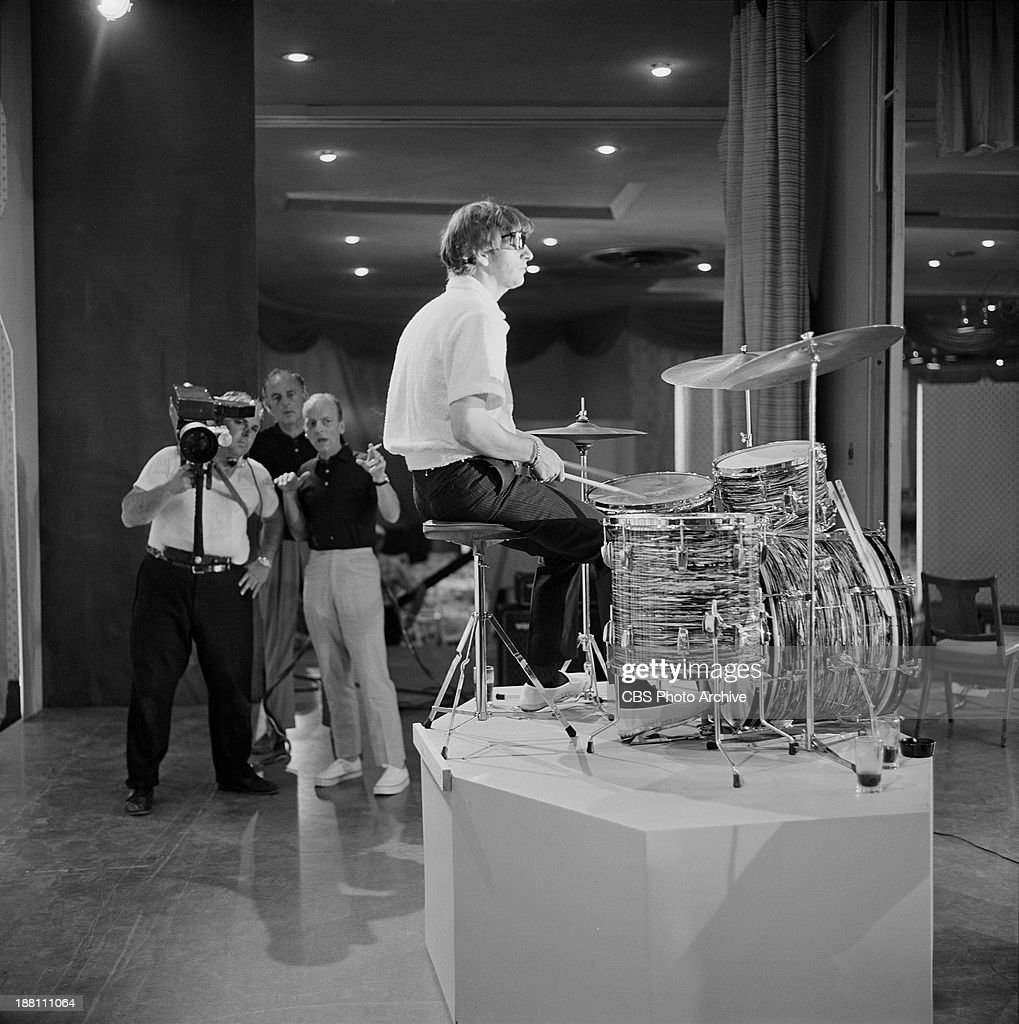
NEW YORK – FEBRUARY 16: The Beatles rehearse at the Deauville Hotel, Miami Beach, Florida for THE ED SULLIVAN SHOW. Pictured is drummer, Ringo Starr. Image dated February 16, 1964. (Photo by CBS via Getty Images)

NEW YORK – FEBRUARY 16: The Beatles rehearse at the Deauville Hotel, Miami Beach, Florida for THE ED SULLIVAN SHOW. From left: Paul McCartney, George Harrison, John Lennon, and Ringo Starr. Image dated February 16, 1964. (Photo by CBS via Getty Images)
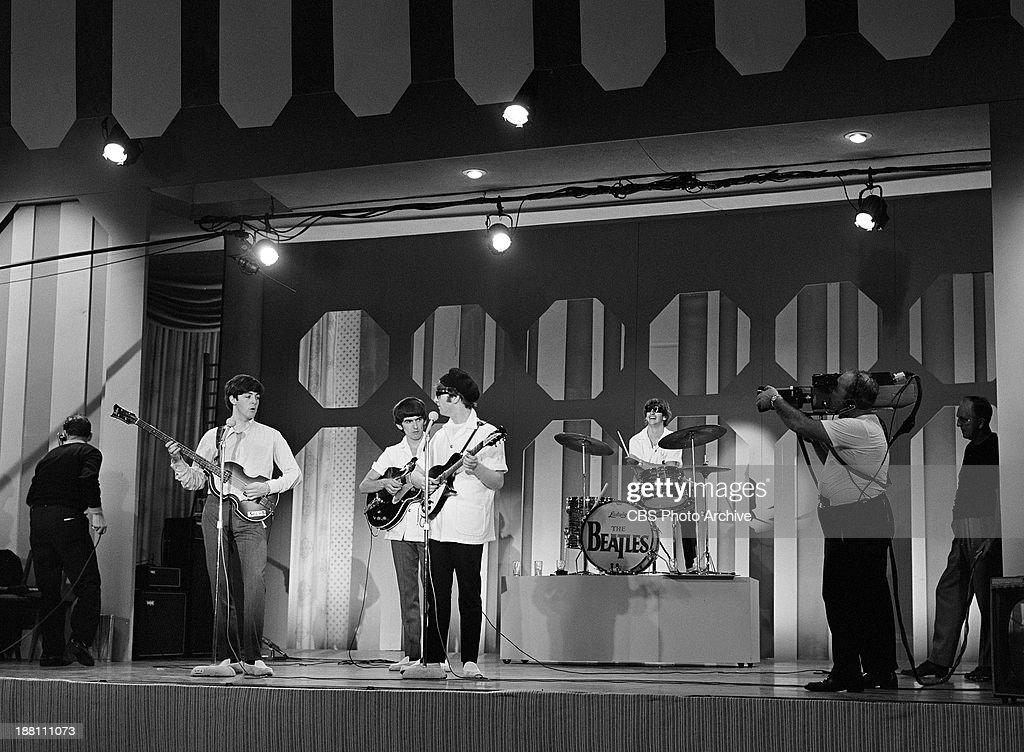
NEW YORK – FEBRUARY 16: The Beatles rehearse at the Deauville Hotel, Miami Beach, Florida for THE ED SULLIVAN SHOW. From left: Paul McCartney, George Harrison, John Lennon, and Ringo Starr. Image dated February 16, 1964. (Photo by CBS via Getty Images)
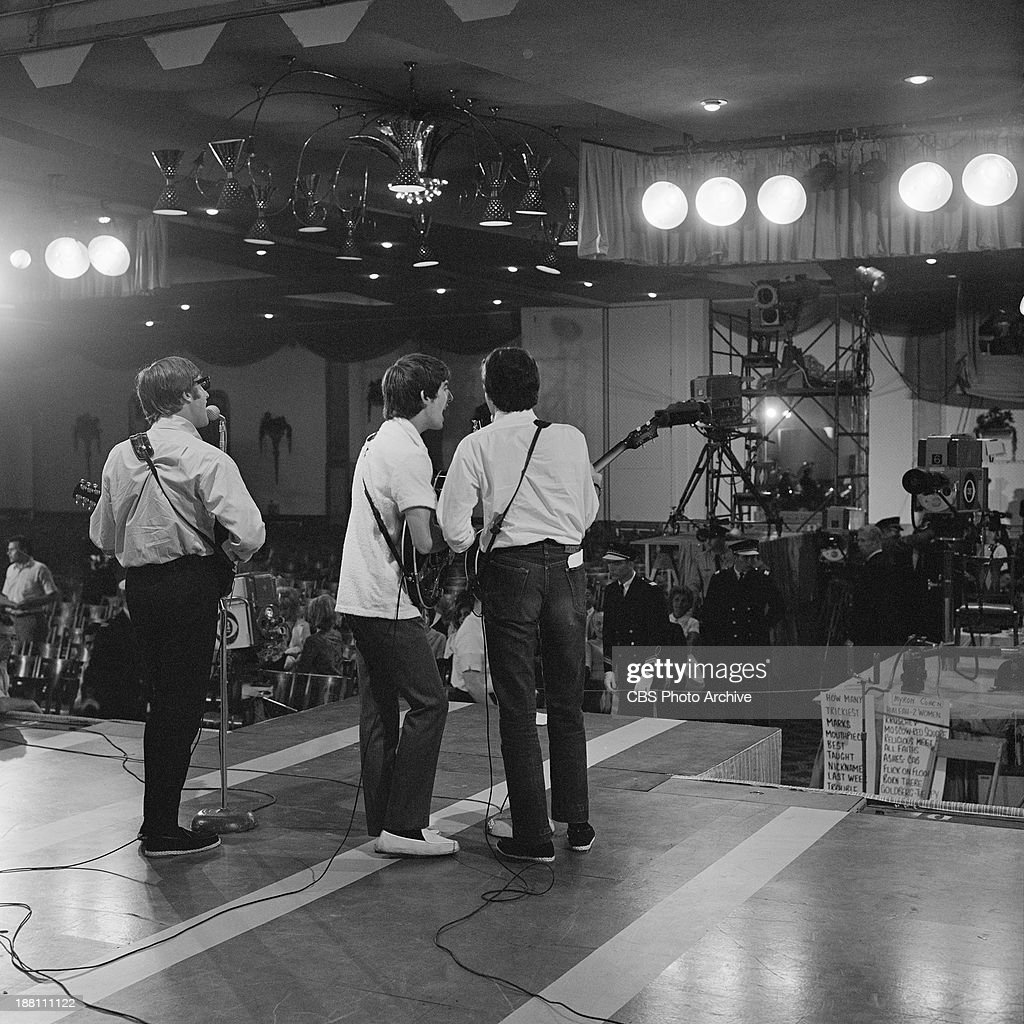
NEW YORK – FEBRUARY 16: The Beatles rehearse at the Deauville Hotel, Miami Beach, Florida for THE ED SULLIVAN SHOW. From left: John Lennon, George Harrison, Paul McCartney. Image dated February 16, 1964. (Photo by CBS via Getty Images)
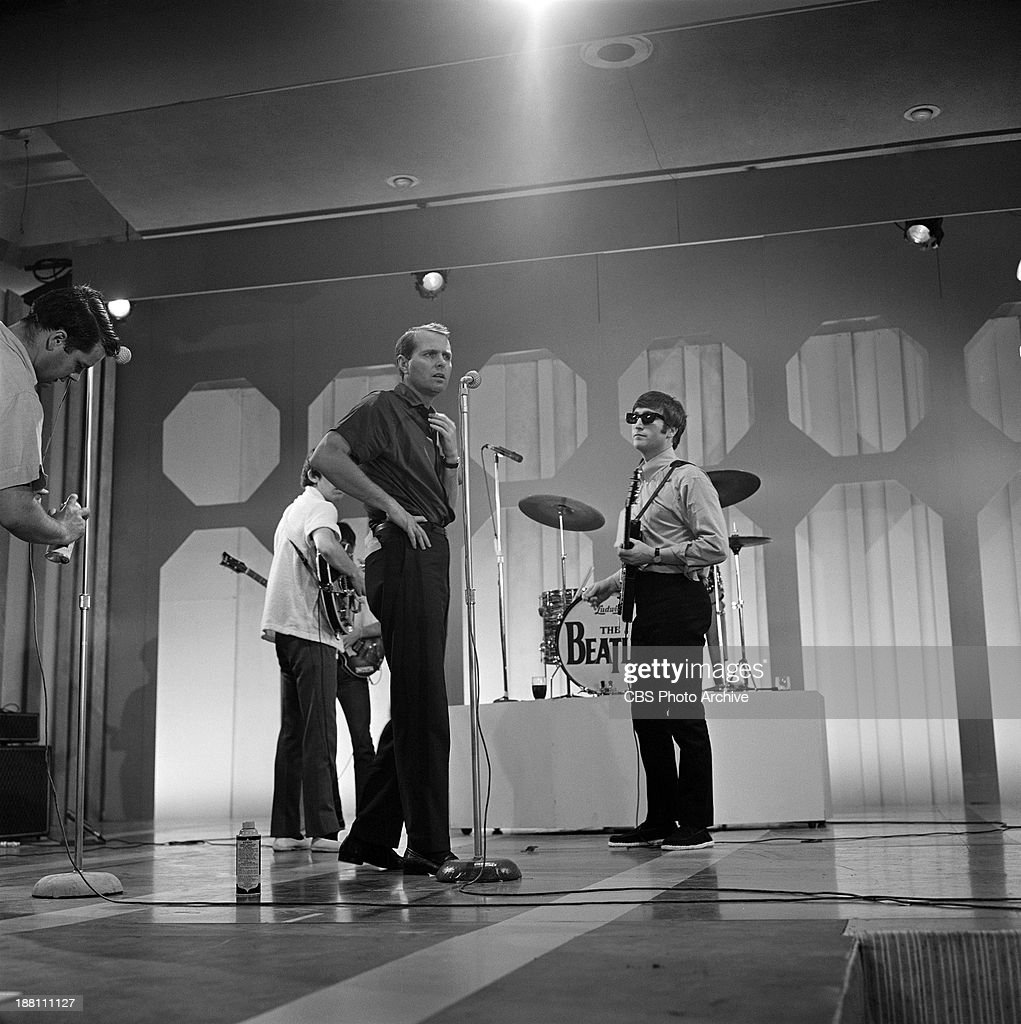
NEW YORK – FEBRUARY 16: The Beatles rehearse at the Deauville Hotel, Miami Beach, Florida for THE ED SULLIVAN SHOW. From left: Producer, Bob Precht and John Lennon. Image dated February 16, 1964. (Photo by CBS via Getty Images)
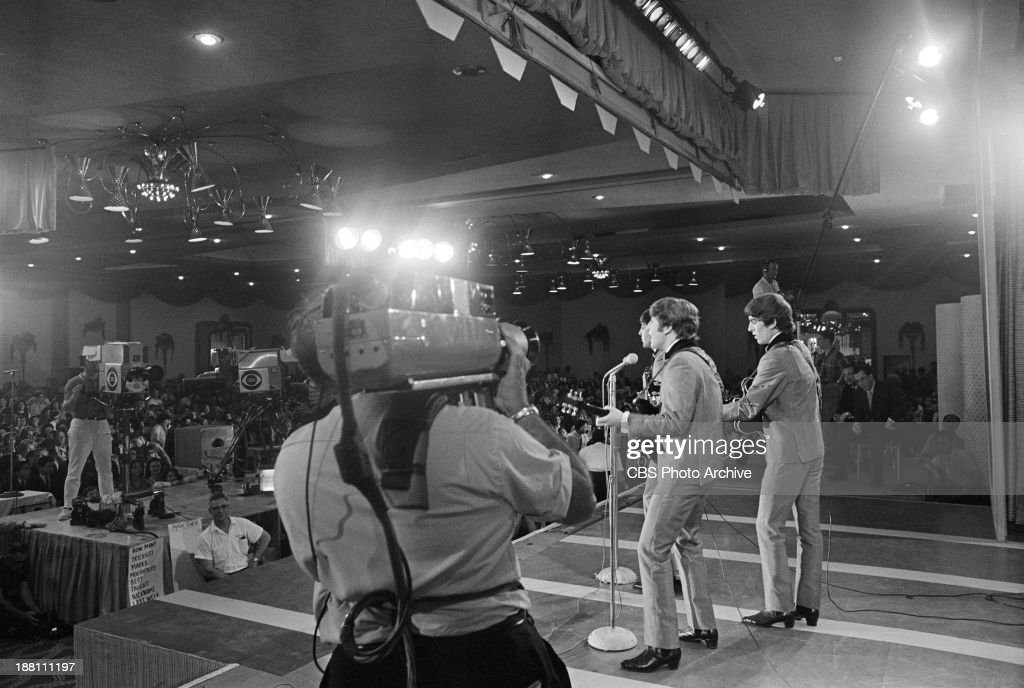
NEW YORK – FEBRUARY 16: The Beatles perform in the Deauville Hotel, Miami Beach, Florida for THE ED SULLIVAN SHOW. From left: John Lennon, Paul McCartney and George Harrison. Image dated February 16, 1964. (Photo by CBS via Getty Images)
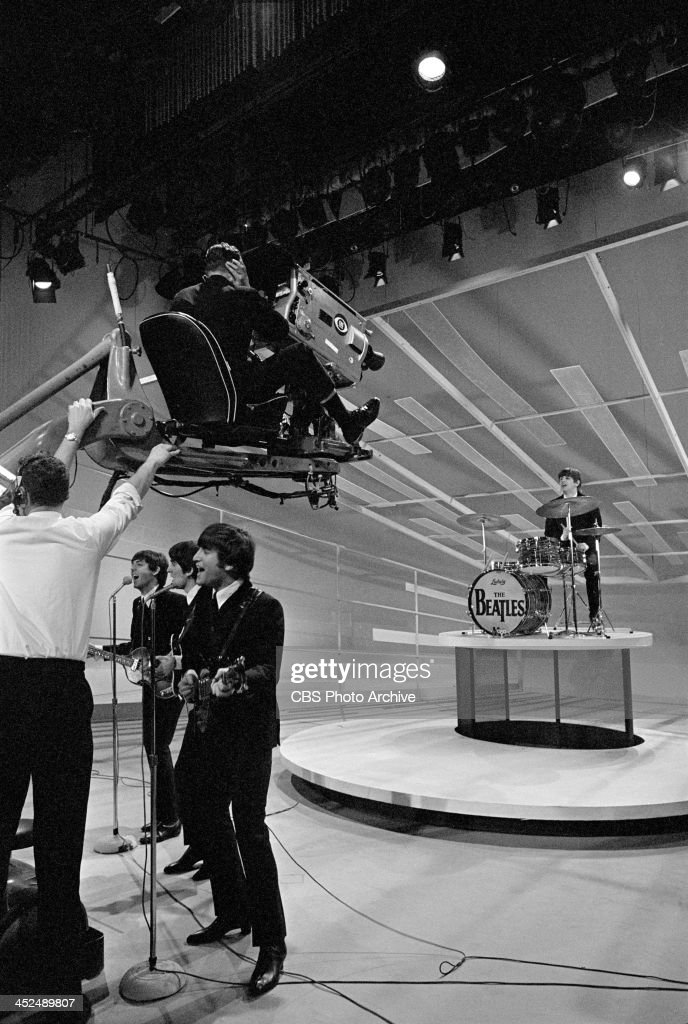
NEW YORK – FEBRUARY 9: The Beatles perform during their first appearance on THE ED SULLIVAN SHOW, February 9, 1964. Paul McCartney, George Harrison, John Lennon and Ringo Starr are shown. (Photo by CBS via Getty Images)
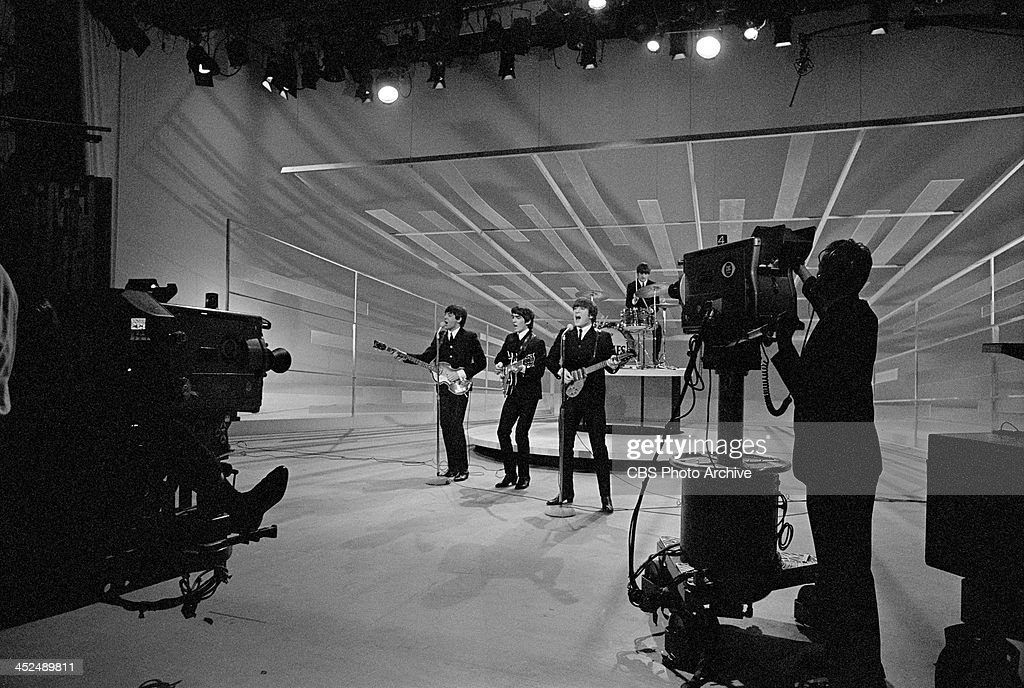
NEW YORK – FEBRUARY 9: The Beatles perform during their first appearance on THE ED SULLIVAN SHOW, February 9, 1964. Paul McCartney, George Harrison, John Lennon and Ringo Starr are shown. (Photo by CBS via Getty Images)
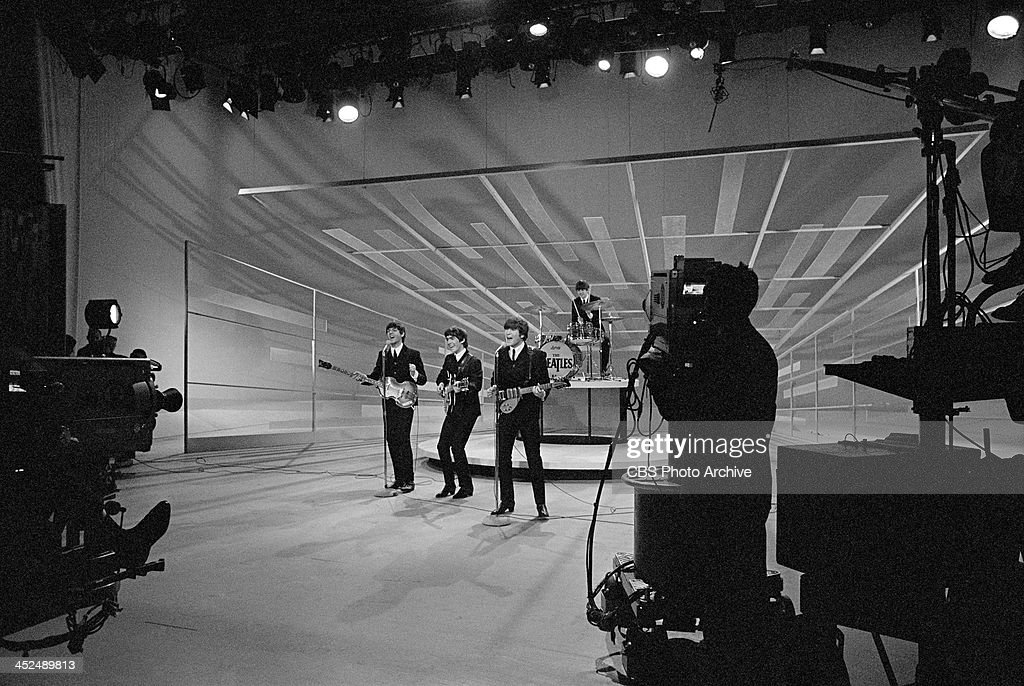
NEW YORK – FEBRUARY 9: The Beatles perform during their first appearance on THE ED SULLIVAN SHOW, February 9, 1964. Paul McCartney, George Harrison, John Lennon and Ringo Starr are shown. (Photo by CBS via Getty Images)

NEW YORK – FEBRUARY 9: The Beatles perform during their first appearance on THE ED SULLIVAN SHOW, February 9, 1964. Paul McCartney, George Harrison, John Lennon and Ringo Starr are shown. (Photo by CBS via Getty Images)
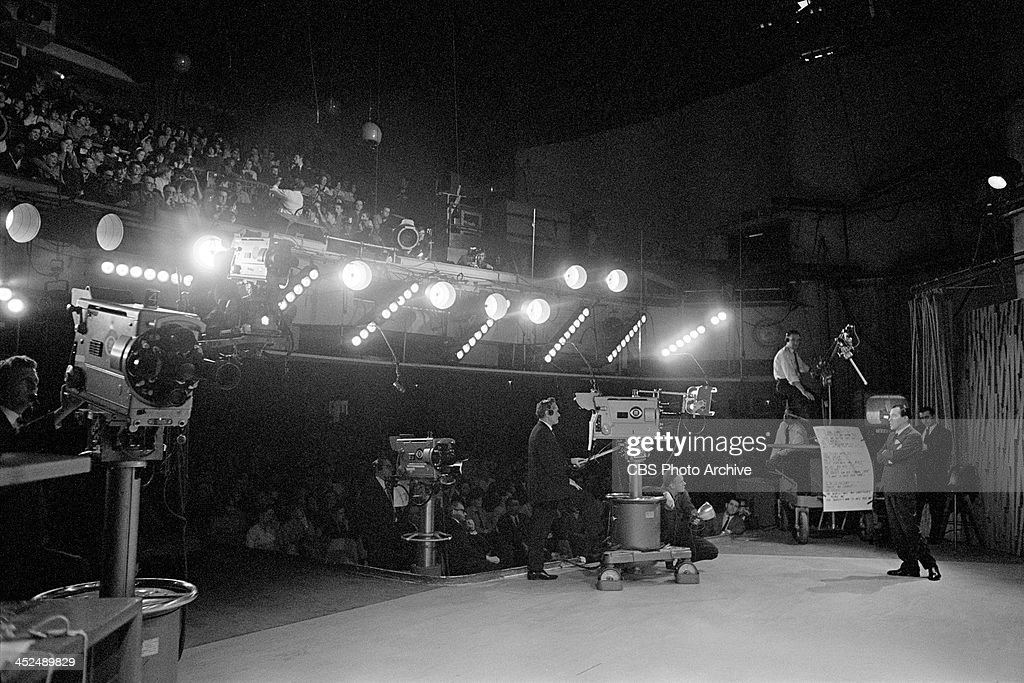
NEW YORK – FEBRUARY 9: Ed Sullivan speaking into the camera on THE ED SULLIVAN SHOW. Image dated February 9, 1964. (Photo by CBS via Getty Images)

NEW YORK – AUGUST 14: The Beatles final performance on THE ED SULLIVAN SHOW. Image dated August 14, 1965. Paul McCartney, Ed Sullivan and John Lennon. (Photo by CBS via Getty Images)
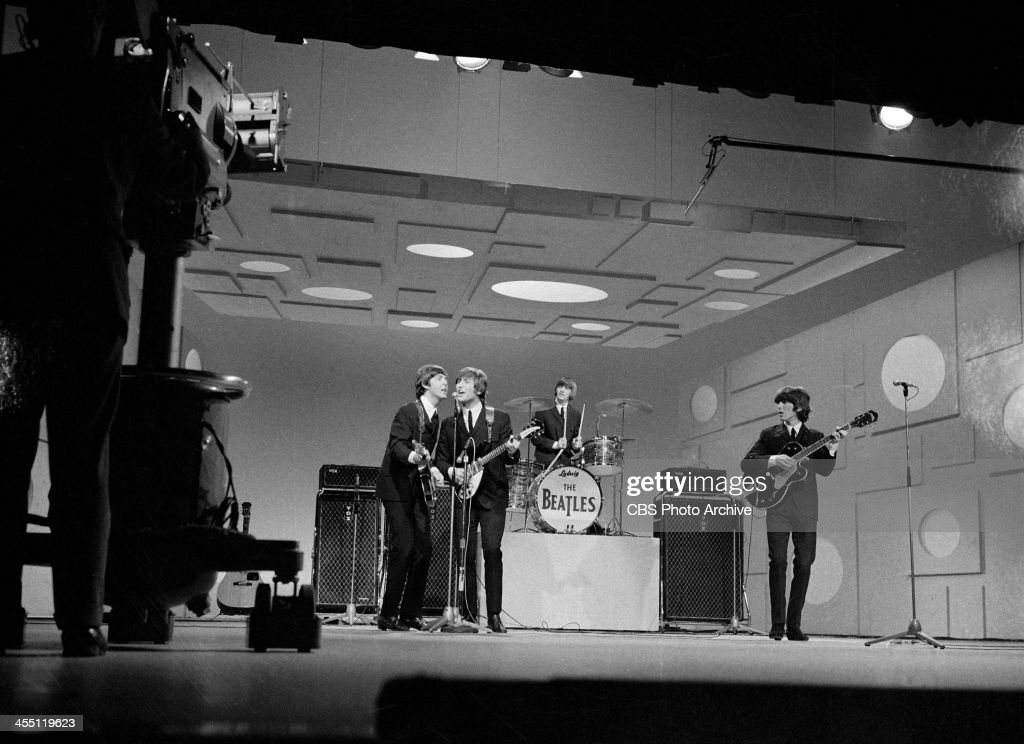
NEW YORK – AUGUST 14: The Beatles final performance on THE ED SULLIVAN SHOW. Image dated August 14, 1965. From left: Paul McCartney, George Harrison, Ringo Starr, John Lennon. (Photo by CBS via Getty Images)
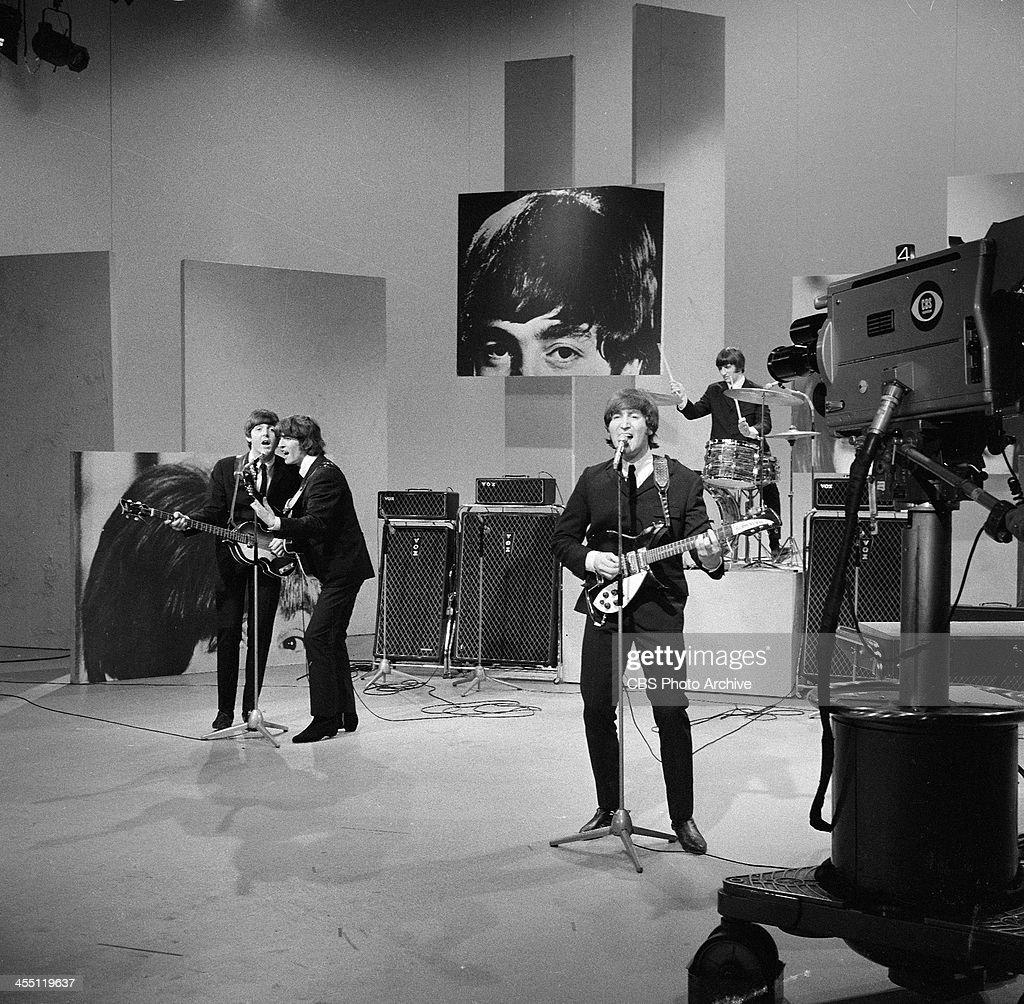
NEW YORK – AUGUST 14: The Beatles final performance on THE ED SULLIVAN SHOW. Image dated August 14, 1965. From left: Paul McCartney, George Harrison, John Lennon, Ringo Starr. (Photo by CBS via Getty Images)
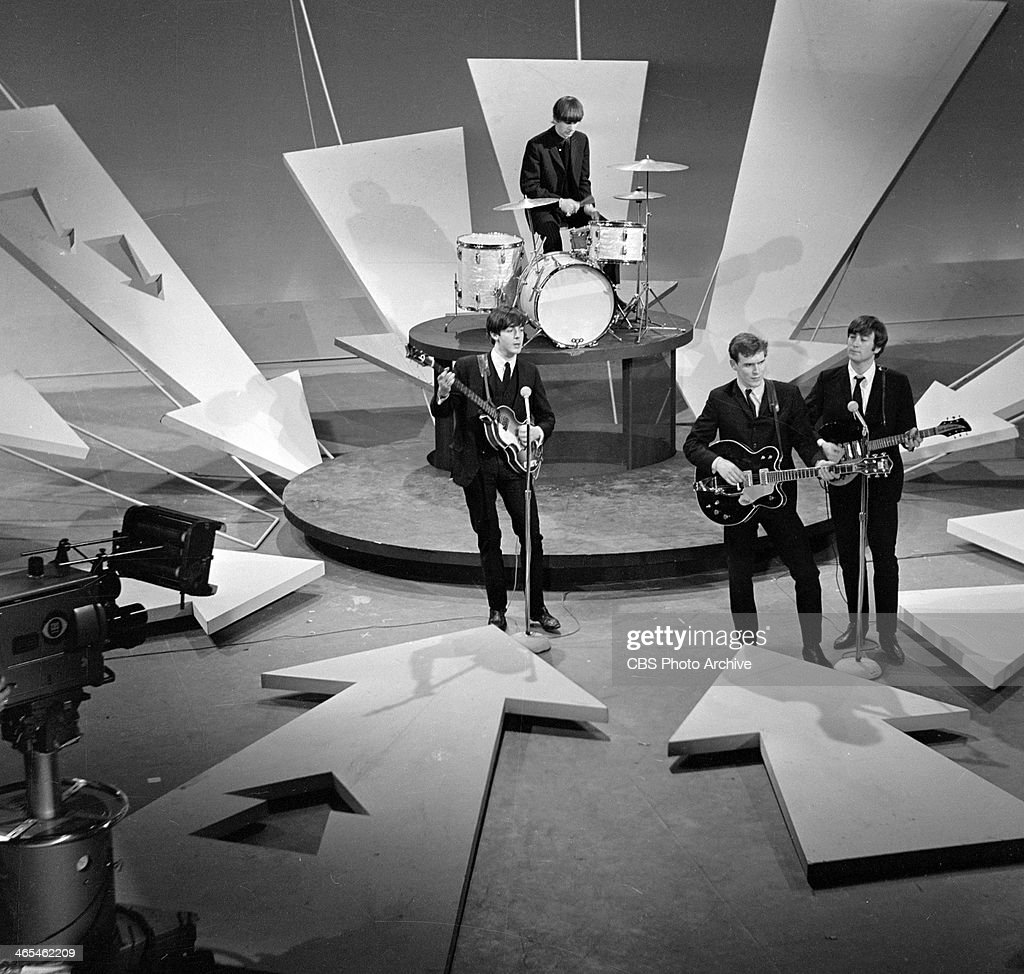
NEW YORK – FEBRUARY 8: The Beatles at rehearsal the day before their first appearance on THE ED SULLIVAN SHOW. From left in front: Paul McCartney, Neil Aspinall (standing in for a sick George Harrison), John Lennon and Ringo Starr on the drums. Image dated February 8, 1964. (Photo by CBS via Getty Images)
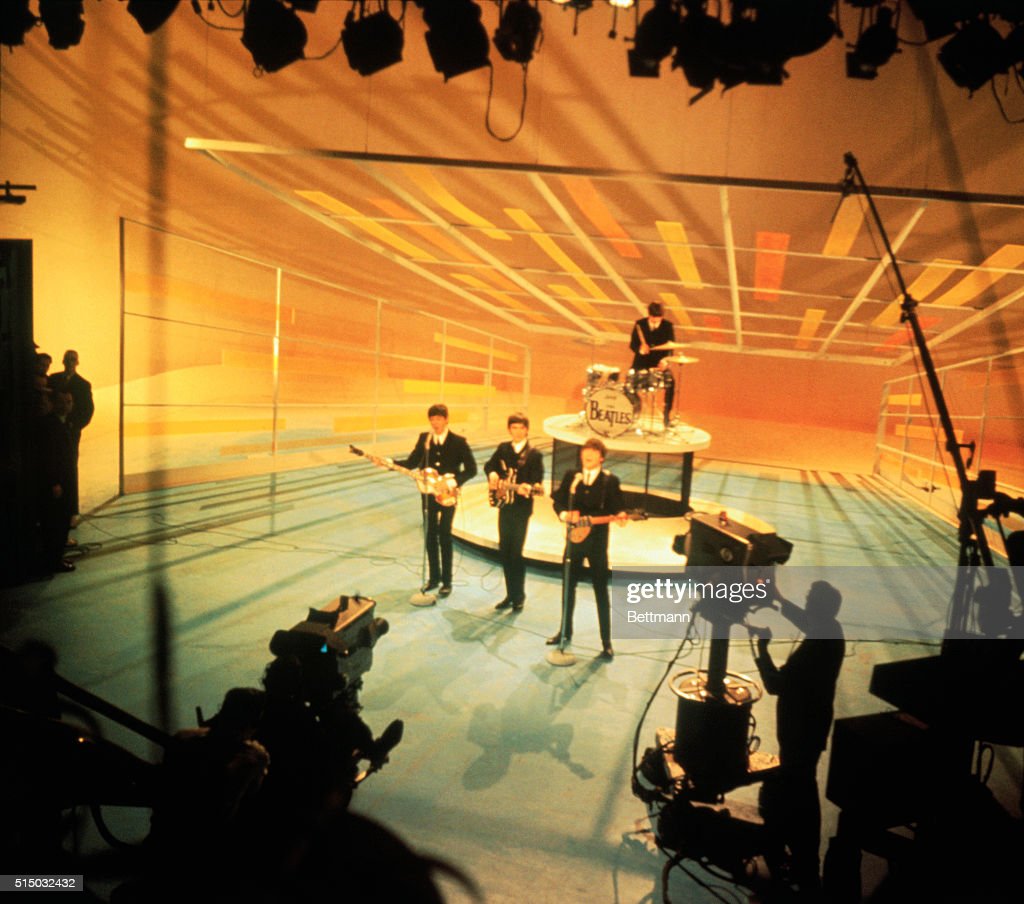
The Beatles during a performance taping for the Ed Sullivan Show in 1964.
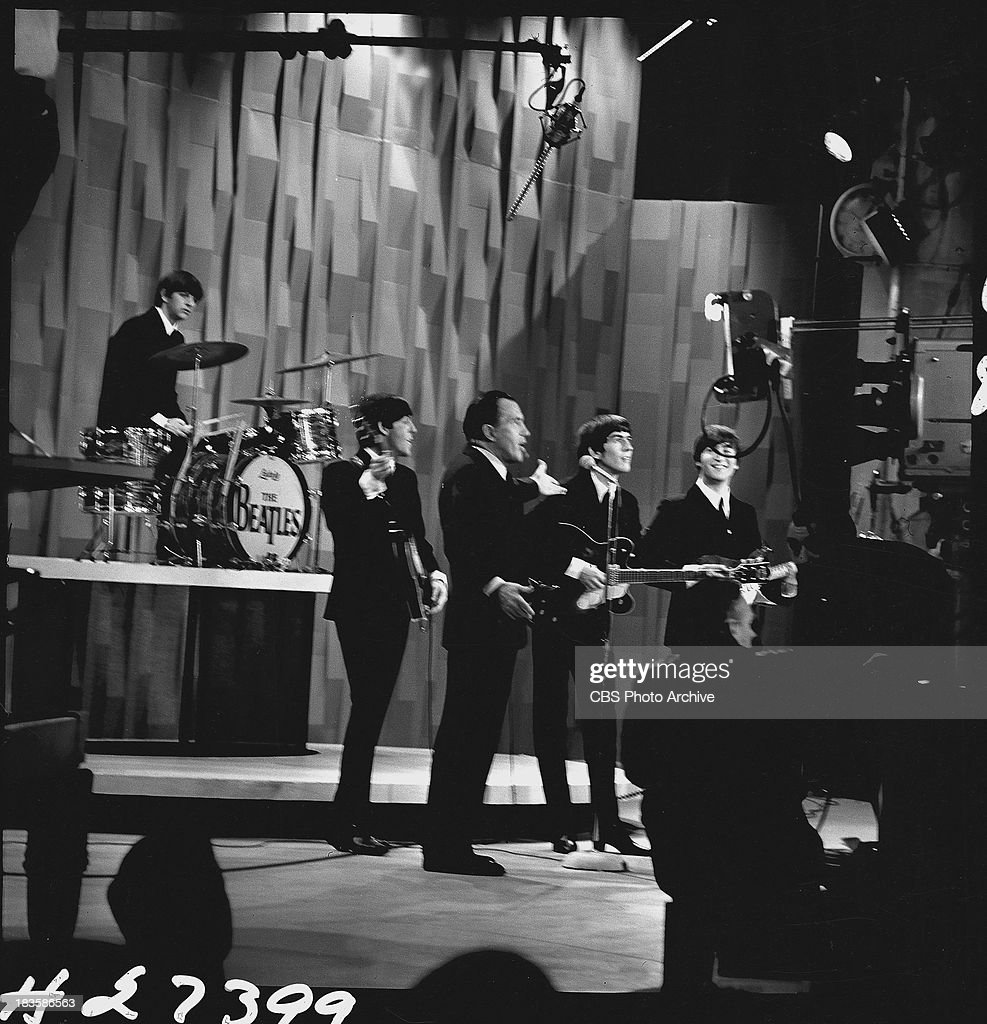
NEW YORK – FEBRUARY 9: THE ED SULLIVAN SHOW featuring The Beatles, performed on Sunday, February 9, 1964, from CBS’s Studio 50 in New York City. Band members (from left) Ringo Starr (drummer), Paul McCartney, show host: Ed Sullivan, George Harrison and John Lennon. (Photo by CBS via Getty Images)
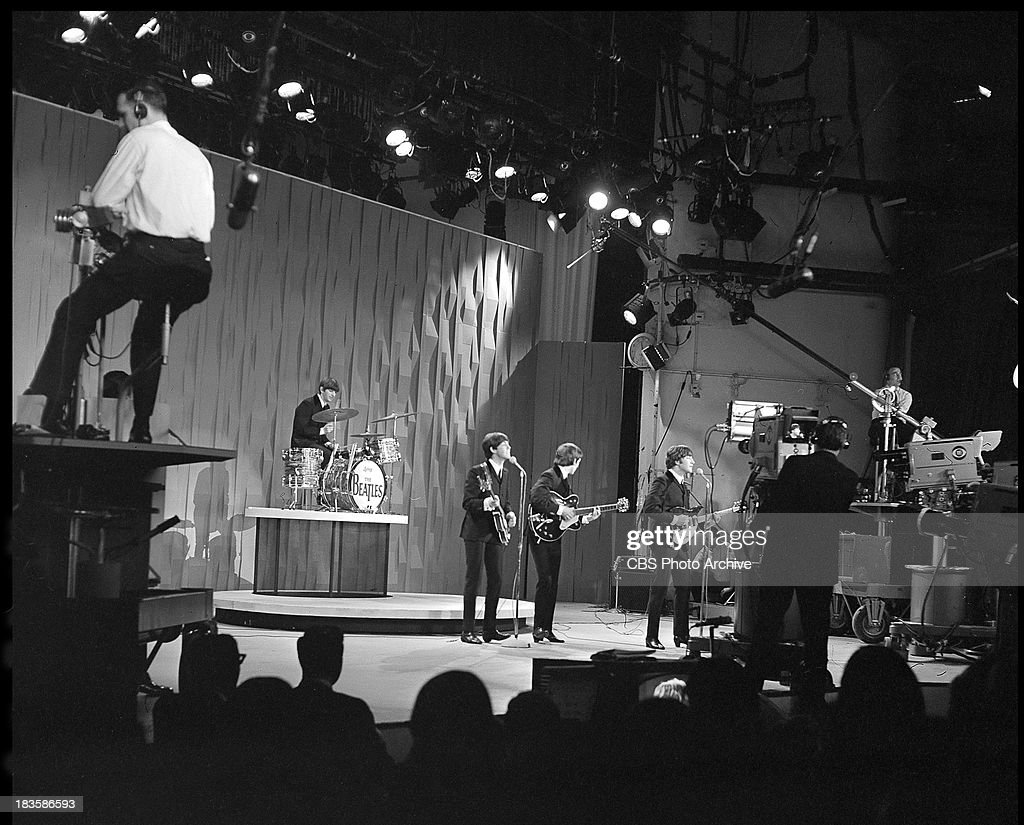
NEW YORK – FEBRUARY 9: THE ED SULLIVAN SHOW featuring The Beatles, performing on Sunday, February 9, 1964, from CBS’s Studio 50 in New York City. Band members (from left) Ringo Starr (drummer), Paul McCartney, George Harrison and John Lennon. (Photo by CBS via Getty Images)
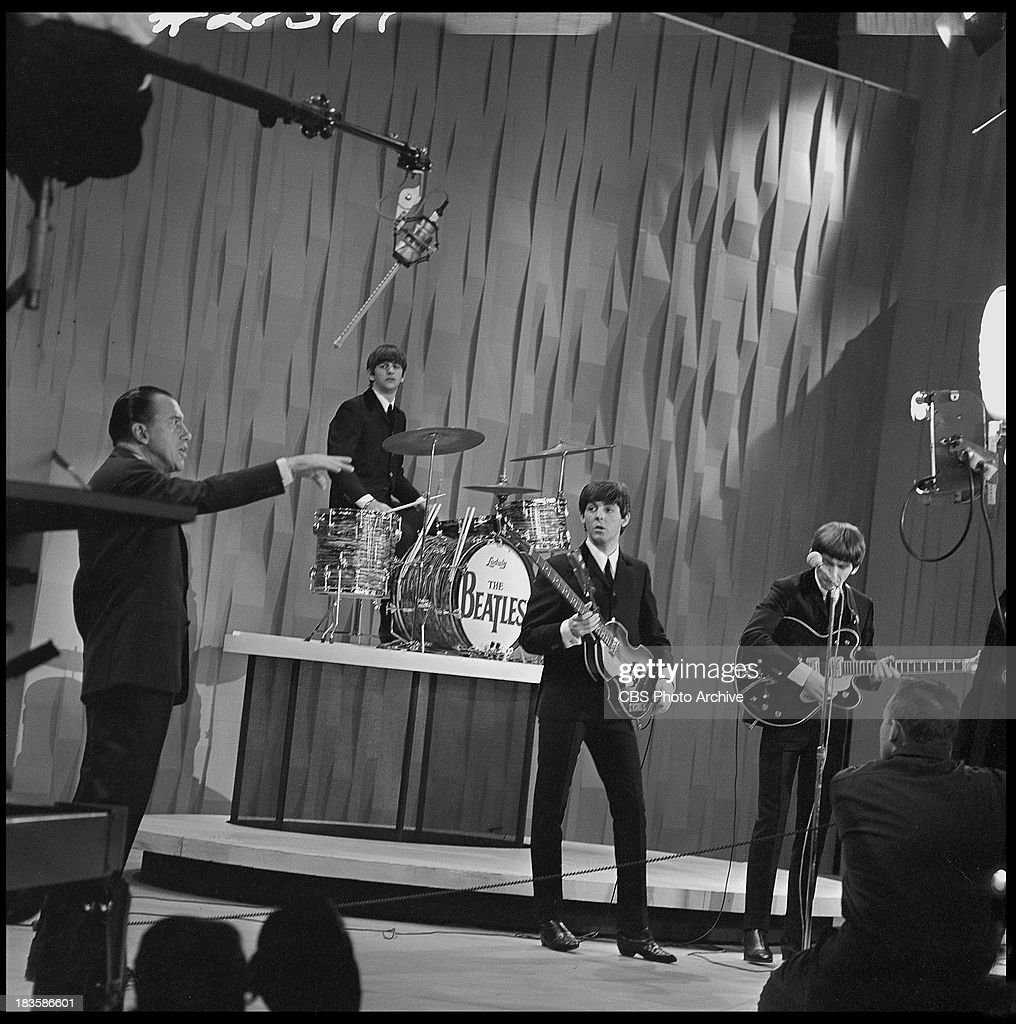
NEW YORK – FEBRUARY 9: THE ED SULLIVAN SHOW featuring The Beatles, performing on Sunday, February 9, 1964, from CBS’s Studio 50 in New York City. Show host: Ed Sulliavn at far left. Three of the four band members (from left) Ringo Starr (drummer), Paul McCartney and George Harrison. (Photo by CBS via Getty Images)
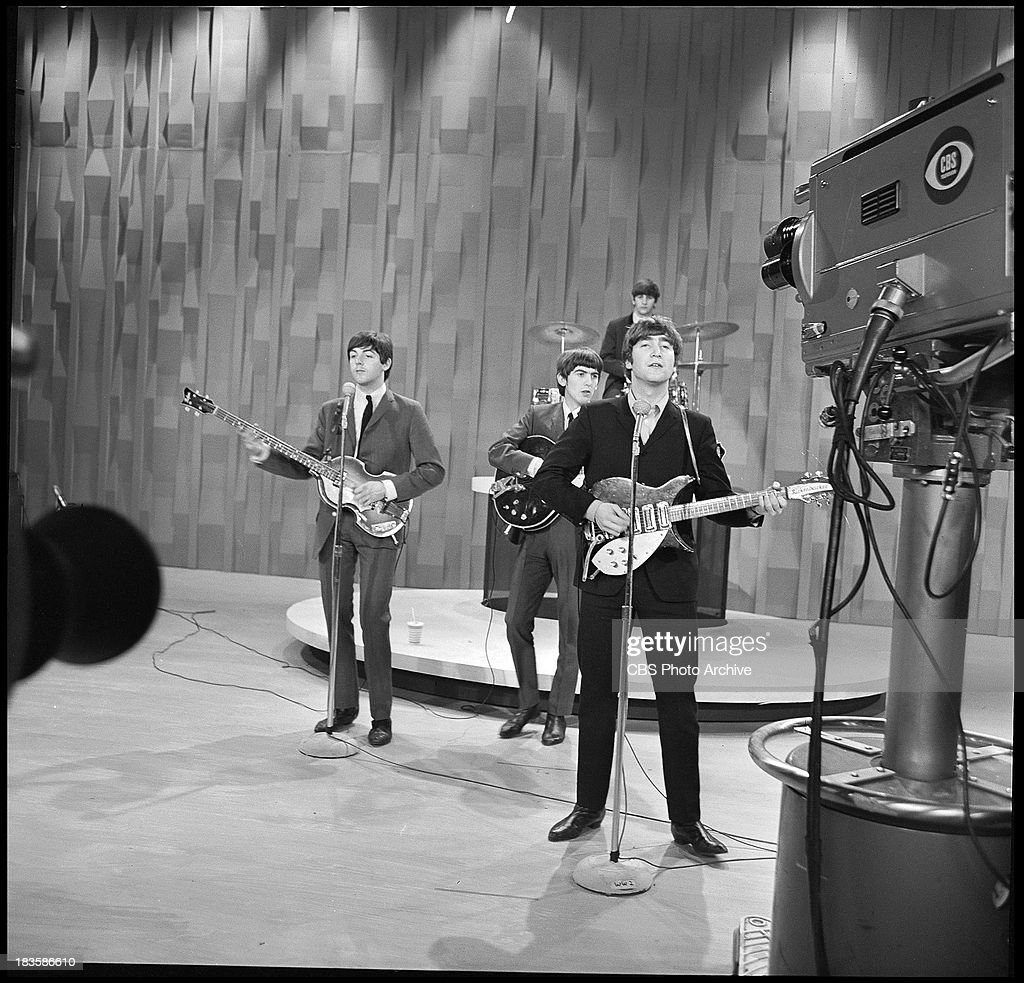
NEW YORK – FEBRUARY 9: THE ED SULLIVAN SHOW featuring The Beatles, performing on Sunday, February 9, 1964, from CBS’s Studio 50 in New York City. Band members (from left): Paul McCartney, George Harrison, Ringo Starr (drummer) and John Lennon. (Photo by CBS via Getty Images)

NEW YORK – FEBRUARY 9: THE ED SULLIVAN SHOW featuring The Beatles, performing on Sunday, February 9, 1964, from CBS’s Studio 50 in New York City. Band members (from left) Ringo Starr (drummer), Paul McCartney, George Harrison and John Lennon. (Photo by CBS via Getty Images)
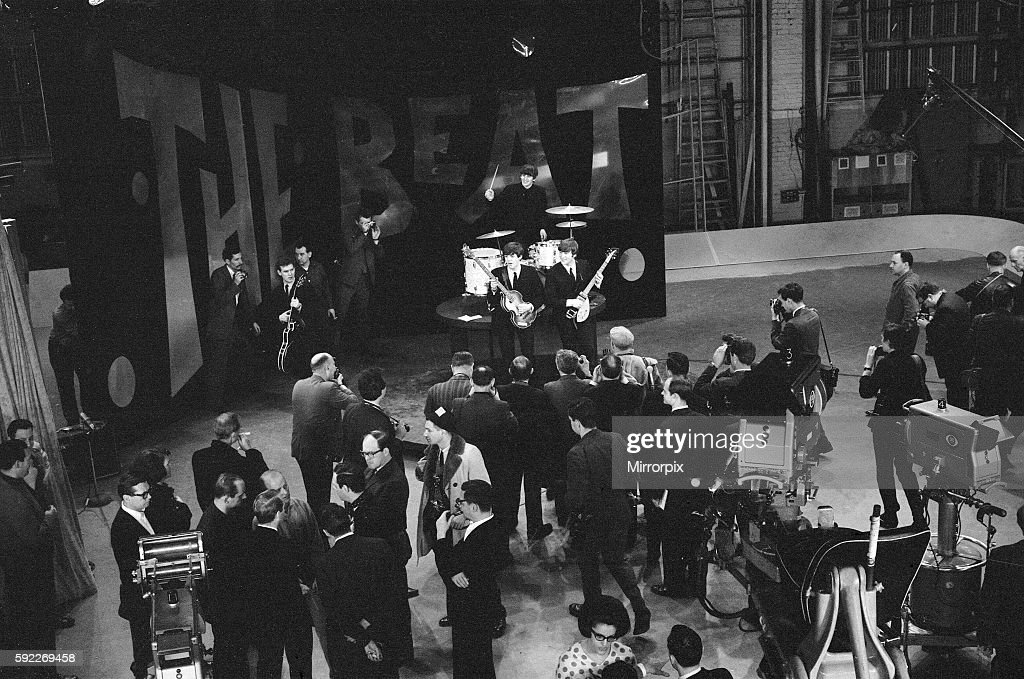
British pop group The Beatles rehearsing for their performance on the Ed Sullivan television programme during the band’s visit to the United States. 9th February 1964. (Photo by Daily Mirror/Mirrorpix/Mirrorpix via Getty Images)

NEW YORK – 1964: Al Jardine, Carl Wilson, Dennis Wilson, Brian Wilson and Mike Love of the rock and roll band “The Beach Boys” perform the song “I Get Around” onstage on “The Ed Sullivan Show” in front of vintage hot rod cars 1964 in New York City, New York. (Photo by Michael Ochs Archives/Getty Images)

NEW YORK – 1965: The Dave Clark Five perform on the Ed Sullivan TV show in 1965 in New York City, New York. (L-R) Ed Sullivan, Denis ‘Denny’ Payton, Rick Huxley, Dave Clark, Mike Smith, Lenny Davidson. (Photo by Michael Ochs Archive/Getty Images)
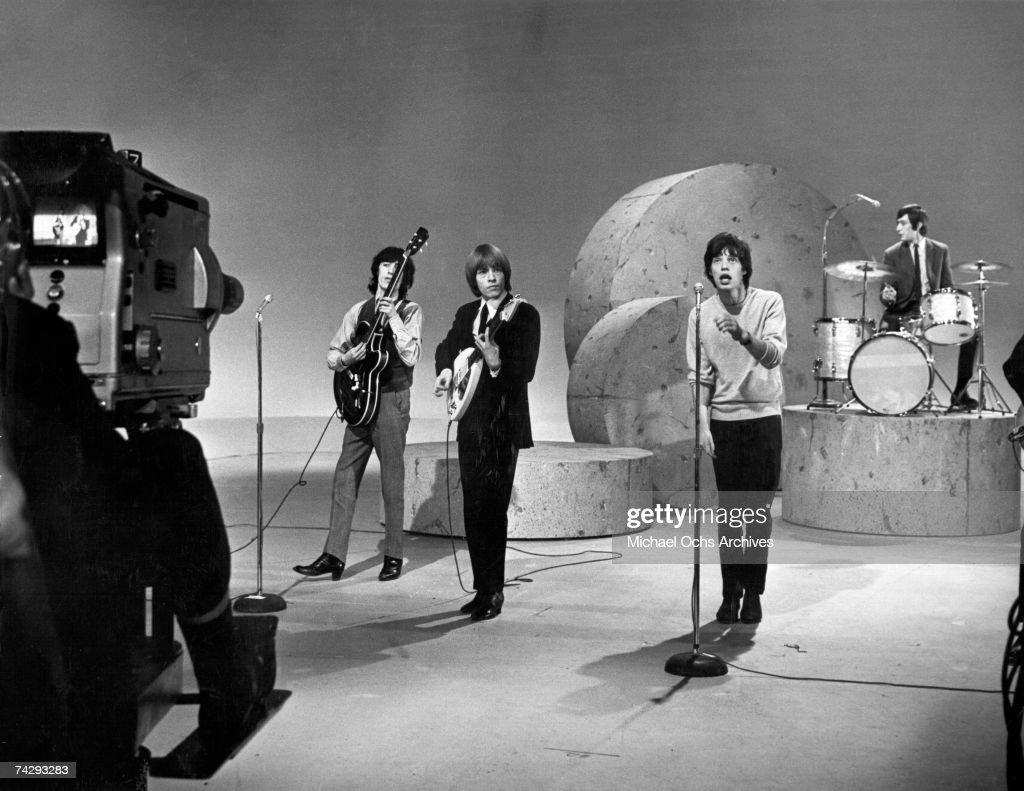
NEW YORK – OCTOBER 25: Rock and roll band “The Rolling Stones” perform on the Ed Sullivan Show on October 25, 1964 in New York City, New York. (L-R) Bill Wyman, Brian Jones, Mick Jagger, Charlie Watts, Keith Richards. (Photo by Michael Ochs Archives/Getty Images)
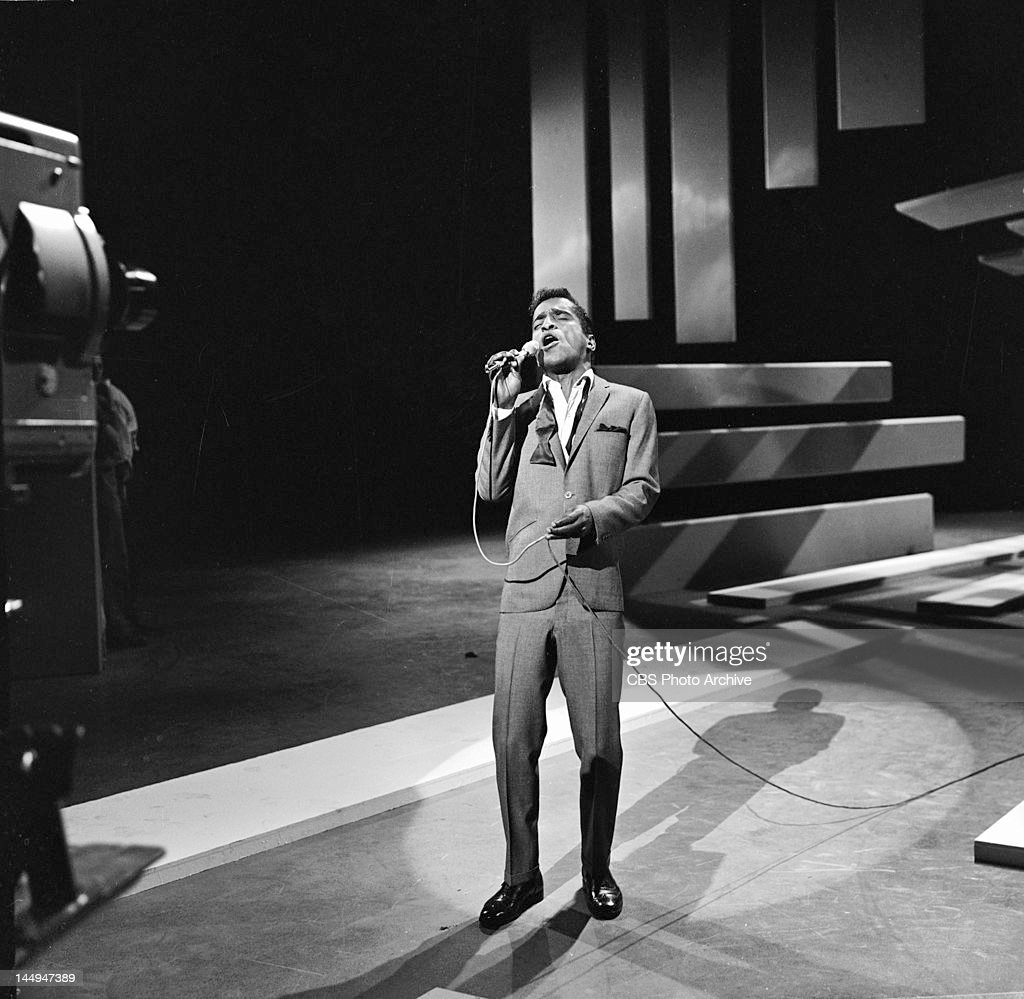
NEW YORK – NOVEMBER 15: Sammy Davis, Jr. performs on THE ED SULLIVAN SHOW. Image dated November 15, 1964. (Photo by CBS via Getty Images)
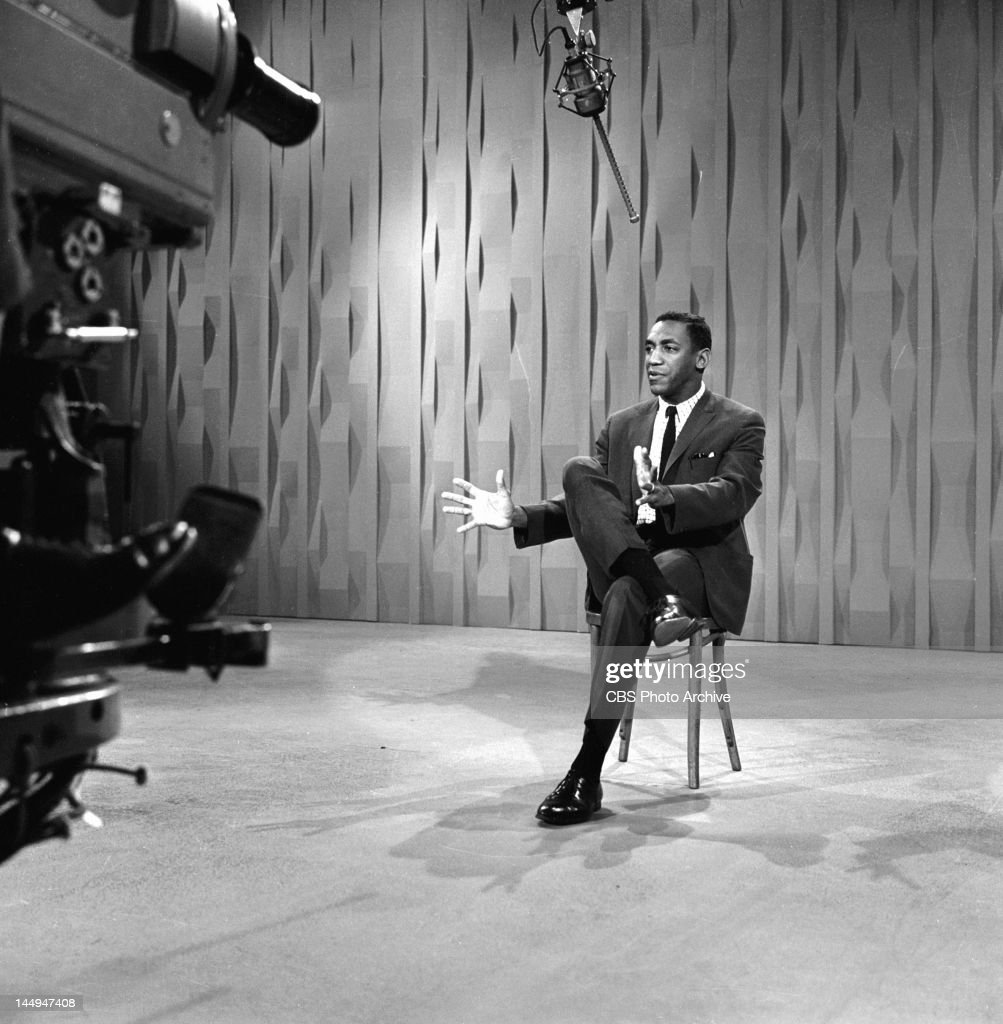
NEW YORK – MAY 31: Bill Cosby performs on THE ED SULLIVAN SHOW. Image dated May 31, 1964. (Photo by CBS via Getty Images)


Behind The Scenes at THE ED SULLIVAN SHOW…Part 5 (of 7)
The Norelco Era: Before we talk about the cameras, let’s talk about Ed’s “personal cameraman”, Mr. George Moses who whe see above shooting the boss with a new Norelco PC71. Stage Manager Eddie Brinkman was with Ed from the first show till the last one and George was there for 21 of the 23 years!
This will be a short but INFORMATIVE section as we deal with the first color in Studio 50, so be sure to see the video clip at the end of this article! In August, Seprember and some of October of 1965, Ed’s show moved to Los Angeles to air new shows as Studi0 50 was outfitted for color with new lights, sets and Norelco PC71 cameras. The cameras were specially outfitted with mu-metal to protect the electronics from the mamoth magnetic field that plagued the theater since day one. Most people never knew that just behind the backstage wall is Transit Substation 13 on West 53rd Street that had huge 600 volt rotary converters used to generate DC from AC. I have included actual photos of these “humming devils” below.
The reason I bring this up is because even thought the Norelcos were great cameras, they just did not quite hit the mark there at Studio 50 where great color was critical for all the shows that came from here. On October 31, 1965, the Norelco PC71s took the Sullivan show to color at Studio 50. BUT, one year later, CBS announced it had just bought 39 new Marconi Mark VII color cameras and by the summer of 1967, they were in Studio 50 with NO modifications needed to “fight the power” behind the wall.
These historical images are from the CBS Photo Archives available through Getty Images and are presented here to assist researchers and television historians in identifying the television equipment in use over the decades and is offered here in a purely educational/instructional forum.

American television host Ed Sullivan (1902 – 1974) (left) shakes hands with Soul singer James Brown (1933 – 2006) on the set of ‘The Ed Sullivan Show’ where Brown was the musical guest, New York, New York, October 30, 1966. A camera and boom microphone are visible. (Photo by CBS Photo Archive/Getty Images)
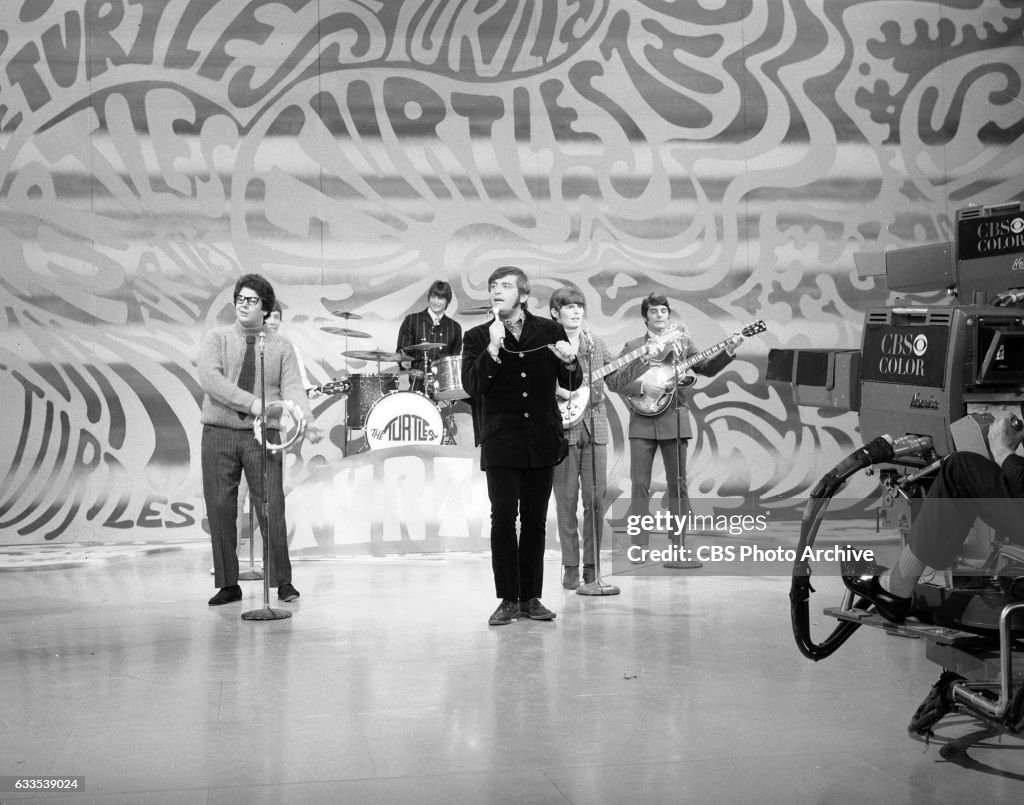
NEW YORK – MAY 14: Music group The Turtles perform on The Ed Sullivan Show on Sunday, May 14, 1967. The Turtles are led by Mark Volman (at left with tambourine) and Howard Kaylan (wearing dark suit, center). Also seen: John Barbata (on drums); Al Nichol (guitar, second from right) and Jim Tucker (guitar, far right). (Photo by CBS via Getty Images)

NEW YORK – FEBRUARY 13: The Rolling Stones are photographed during a rehearsal for “The Ed Sullivan Show” in New York, New York on February 13, 1966. (Photo by CBS via Getty Images)
This is the machinery that wreaked havock since the days of radio at The Sullivan Theater. These rotalry converters (from AC to DC) generated thousands of volts of electricity for the subways below but blew up huge magnetic fields that went through the brick wall behind the stage, like water through bread.
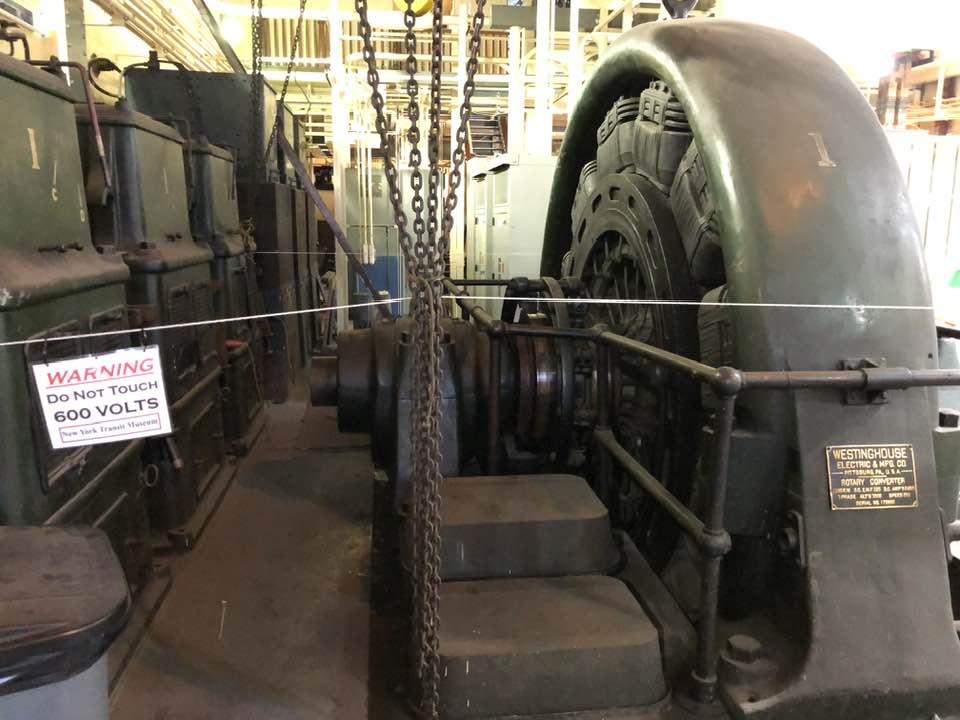
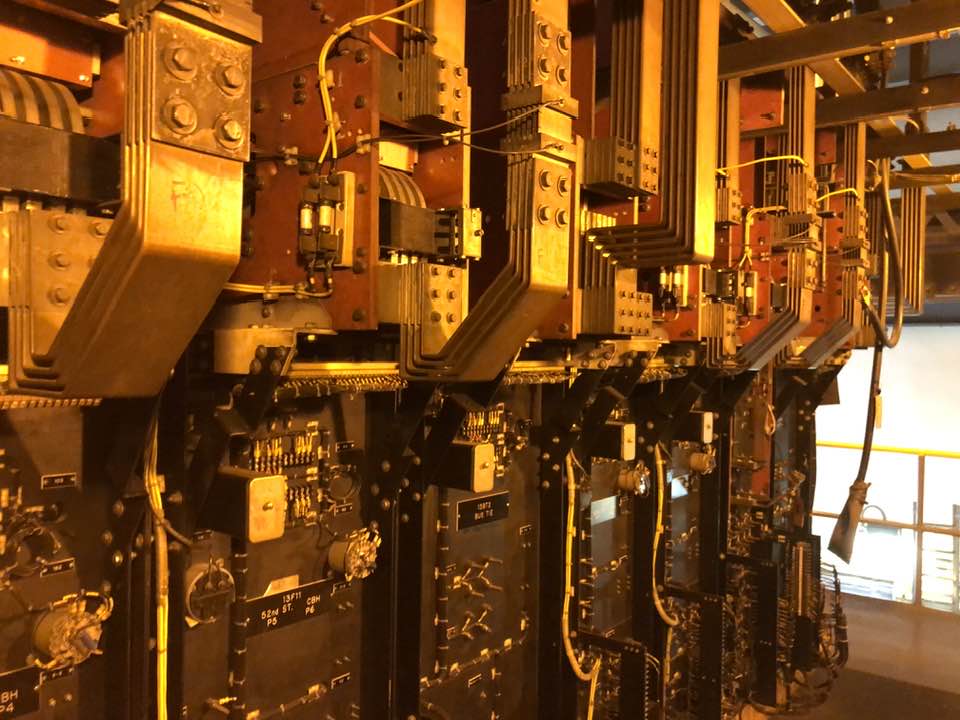
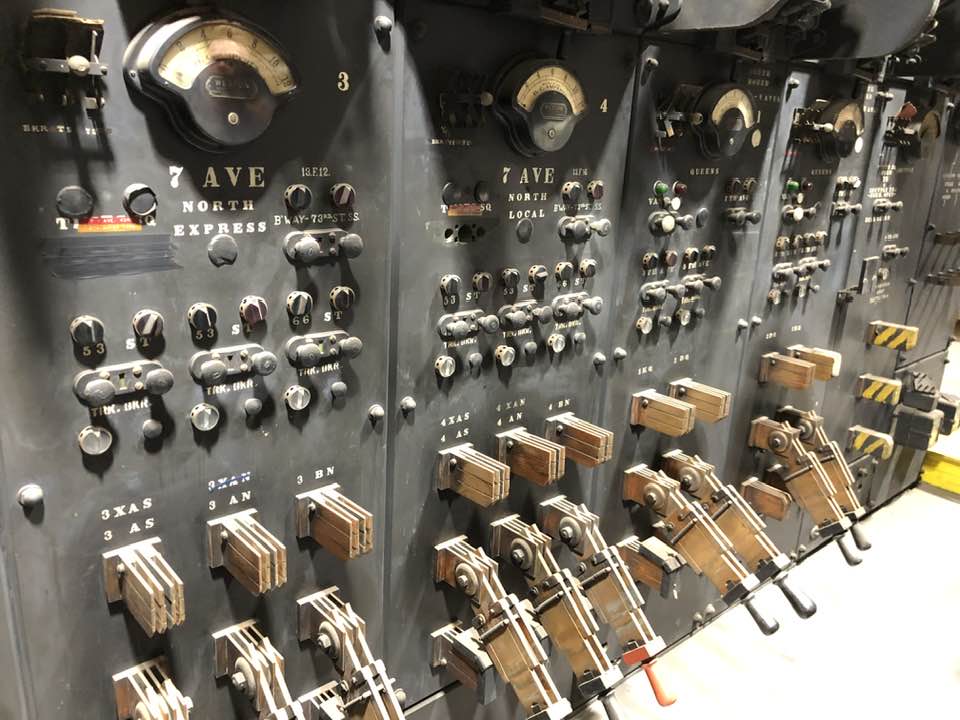
THIS IS THE SUBSTATION IN ACTION! TAKE A LOOK!


Behind The Scenes at THE ED SULLIVAN SHOW…Part 6 (of 7)
The Marconi Mark VII Era: In the summer of 1967, the Marconi Mark VII color cameras went into service at CBS Studio 50 and were the go to cameras for many years at the network. The color photo above the last color photo were taken by our friend and author Nick Van Hoogstraten in 1973 when Ed was hosting “Ed Sullivan’s Broadway” which was one of his specials after the show’s weekly version had ended.
These top two black and white photos were taken by our friend Charles Chin (who worked as a CBS page) on December 12, 1969 when THE SUPREMES were in dress rehearsal for their very last appearance, which I’ve chosen to add here.
These historical images are from the CBS Photo Archives available through Getty Images and are presented here to assist researchers and television historians in identifying the television equipment in use over the decades and is offered here in a purely educational/instructional forum.

Dress Rehearsal for the final performance of THE SURPREMES on The Ed Sullivan Show December 12, 1969 with the video of the performance just below.

Cameraman Bobby Heller and Chapman crane arm-man Kevin Slattery shoot Dianna Ross in dress rehersal of their last performance as THE SUPREMES. I watched it live and I was sad.
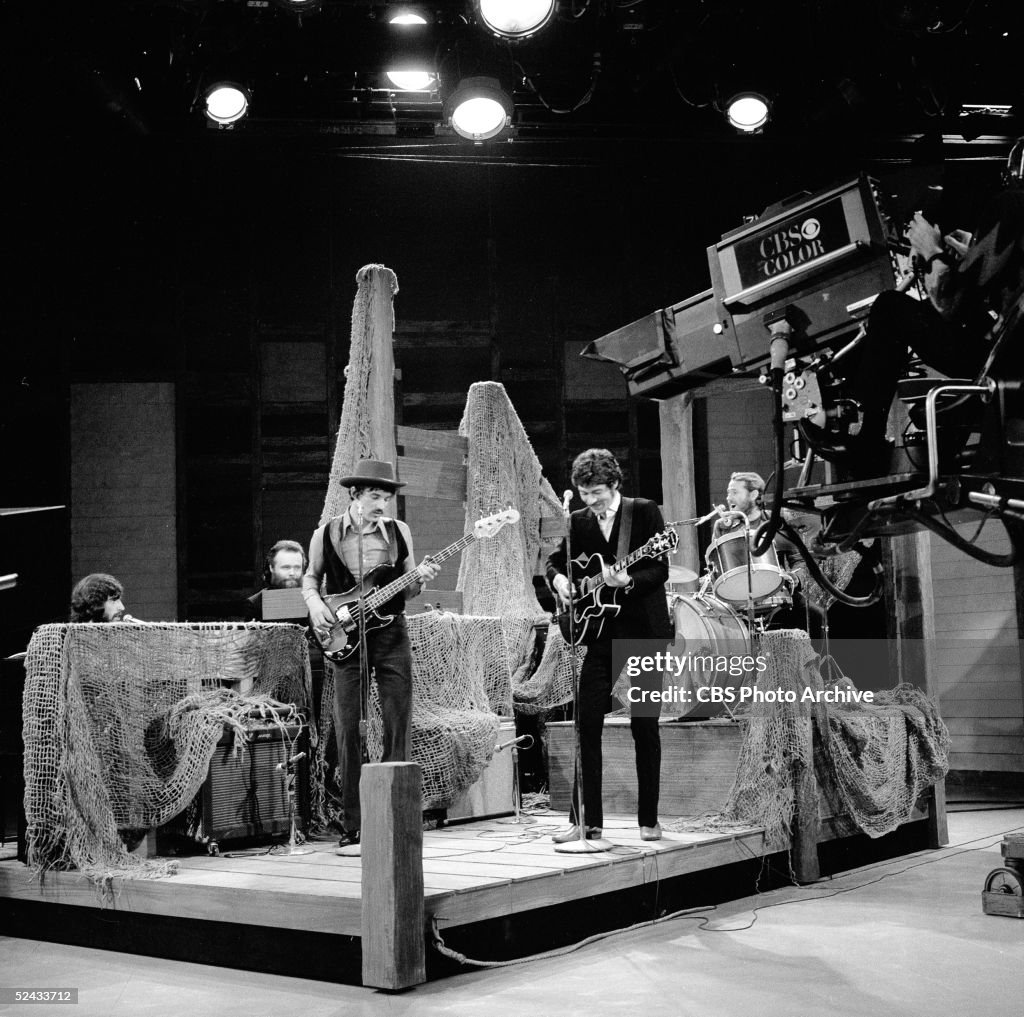
The original members of Southern-style rock and roll combo The Band, (from left) Canadians Richard Manuel at piano, Garth Hudson at piano, Rick Danko, Robbie Robertson and American Levon Helm on drums, perform on the Ed Sullivan Show, New York, November 2, 1969. (Photo by CBS Photo Archive/Getty Images)

NEW YORK – OCTOBER 15: The Ed Sullivan Show, with host Sullivan (at left) and guest Tommy Cooper, a magician and comic from England. Image dated Sunday, October 15, 1967. (Photo by CBS via Getty Images)

NEW YORK – SEPTEMBER 17: The Doors, featuring Jim Morrison, perform on THE ED SULLIVAN SHOW. September 17, 1967 (Photo by CBS via Getty Images)
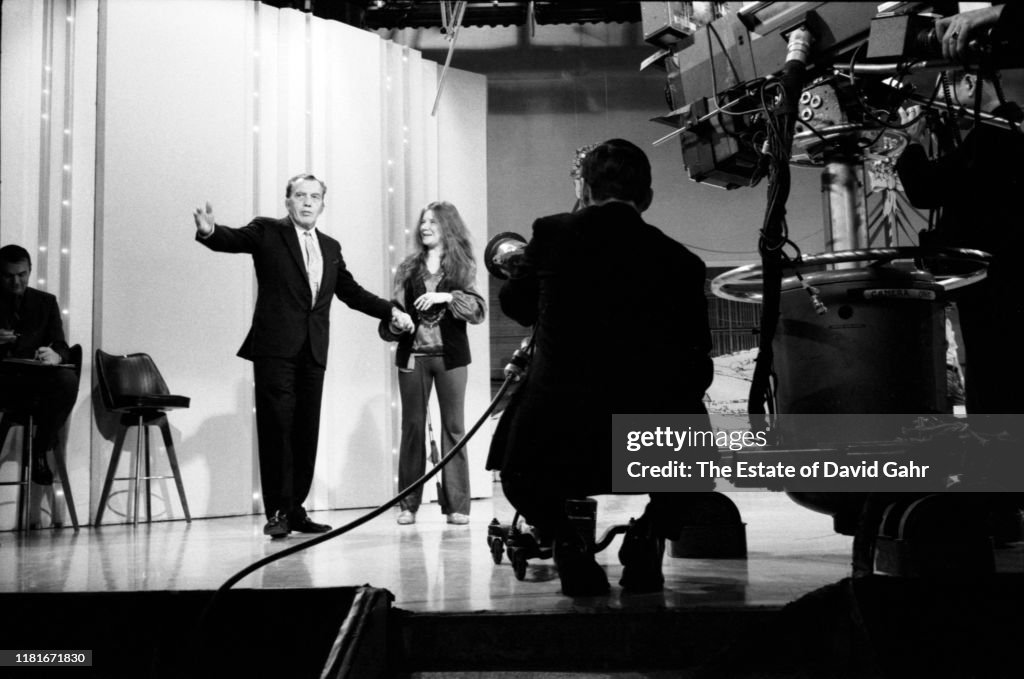
NEW YORK – MARCH 16: Television variety host Ed Sullivan (l) introduces rock and blues singer Janis Joplin (r) and the Kozmic Blues Band before a performance on the Ed Sullivan Show on March 16, 1969 in New York City, New York. (Photo by David Gahr/Getty Images)

Melvin Van Peeples performing at Studio 50 dress rehersal for “Ed Sullivan’s Broadway” special.


Behind The Scenes at THE ED SULLIVAN SHOW, Part 7 (of 7)
SPECIAL COLOR BONUS PAGE: Before October 31, 1965…the day CBS Studio 50 was color capable via their new Norelco PC71 cameras, Sullivan’s show had been broacast in color only a handful of times and all but one of those color shows had originated at CBS Television City in Hollywood.
This is the one time that the show was done in color from NYC before October of ’65. It was 1954 and the show was still called TOAST OF THE TOWN when, for a week in the late summer, CBS Color Studio 72 became the stage for that week’s live show. Studio 72 was CBS’s only color studio on the east coast and was equipped with RCA TK41 cameras. Here are some still shots of that weeks rehearsals, BUT ALSO, an amazing 14 minutes of color film that captures the event. Click the special box below to see it.
These historical images are from the CBS Photo Archives available through Getty Images and are presented here to assist researchers and television historians in identifying the television equipment in use over the decades and is offered here in a purely educational/instructional forum.

NEW YORK – AUGUST 22: Ed Sullivans Toast of the Town and its debut color television broadcast of the variety show. Pictured is a model and Ed Sullivan with a Lincoln-Mercury automobile, the show’s sponsor. Broadcast from CBS Color Television Studio 72. Broadway at 81st Street, New York, NY. Image dated August 22, 1954. (Photo by CBS via Getty Images)

Keenan Wynn and Steve Lawrence on the Ed Sullivan show. (Photo by Dwayne and Gina DeJoy/Corbis via Getty Images)

Cameras and full set of Ed Sullivan show on CBS, NYC 1960 (Photo by Dwayne and Gina DeJoy/Corbis via Getty Images)

Set and Crew of the Ed Sullivan Show, CBS, NYC, 1960 (Photo by Dwayne and Gina DeJoy/Corbis via Getty Images)
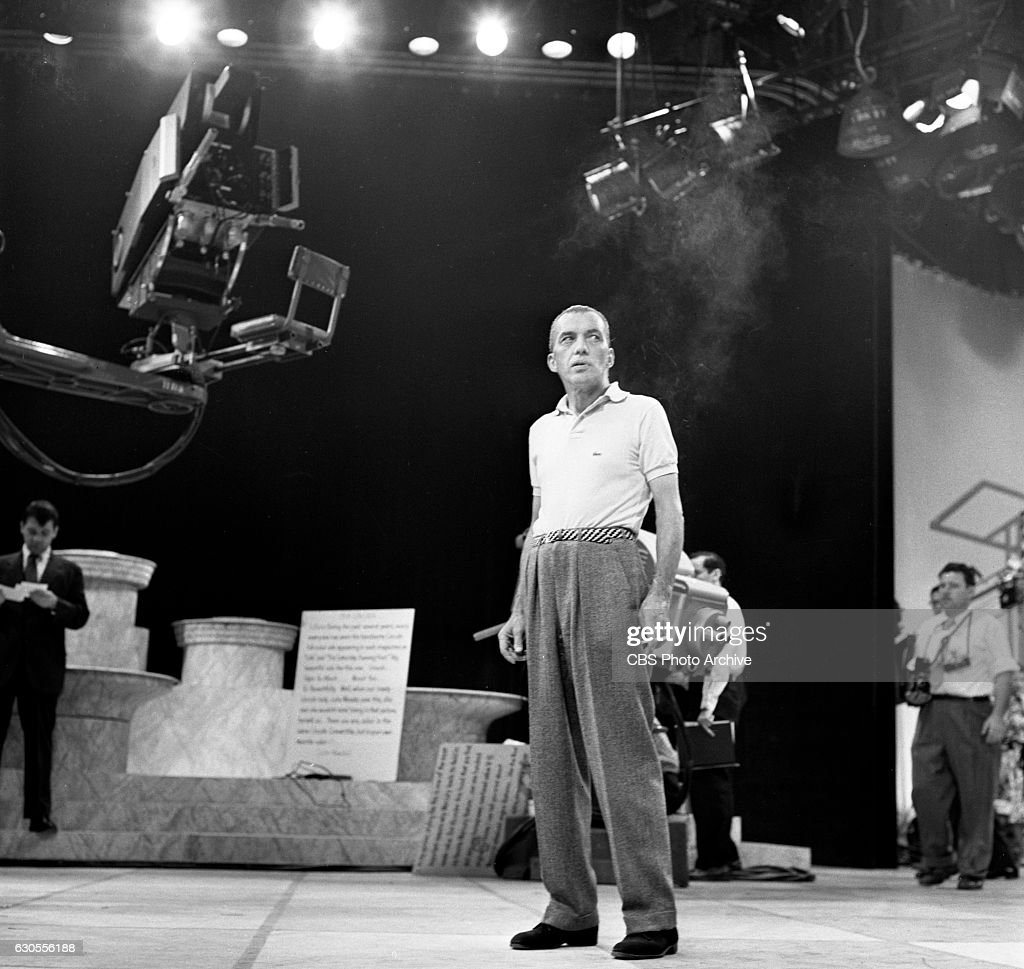
NEW YORK – AUGUST 22: Ed Sullivans Toast of the Town and its debut color television broadcast of the variety show. Pictured is Ed Sullivan. Broadcast from CBS Color Television Studio 72. Broadway at 81st Street, New York, NY. Image dated August 22, 1954. (Photo by CBS via Getty Images)

NEW YORK – AUGUST 22: Ed Sullivans Toast of the Town and its debut color television broadcast of the variety show. Pictured is Ed Sullivan talking to a dancer. Broadcast from CBS Color Television Studio 72. Broadway at 81st Street, New York, NY. Image dated August 22, 1954. (Photo by CBS via Getty Images)
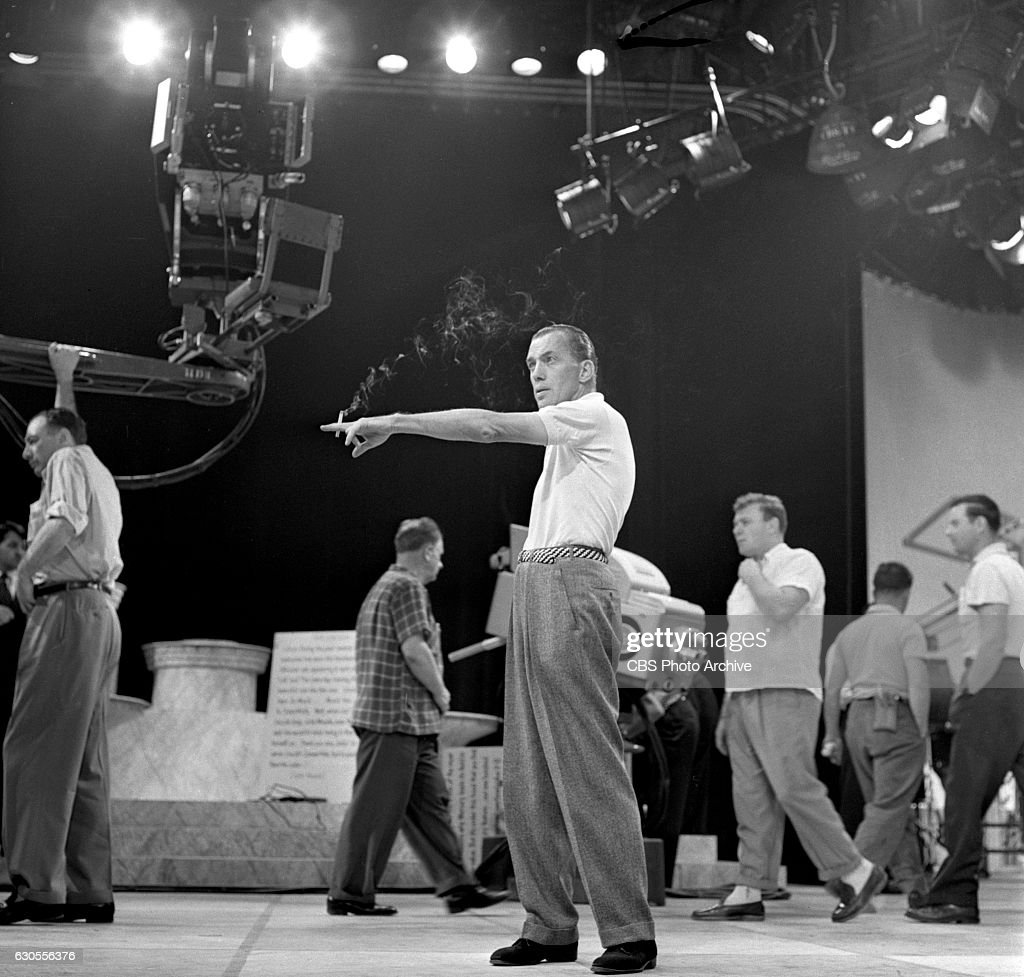
NEW YORK – AUGUST 22: Ed Sullivans Toast of the Town and its debut color television broadcast of the variety show. Pictured is Ed Sullivan. Broadcast from CBS Color Television Studio 72. Broadway at 81st Street, New York, NY. Image dated August 22, 1954. (Photo by CBS via Getty Images)

NEW YORK – AUGUST 22: Ed Sullivans Toast of the Town and its debut color television broadcast of the variety show. Pictured is Ed Sullivan, center, looking at cue cards. Broadcast from CBS Color Television Studio 72. Broadway at 81st Street, New York, NY. Image dated August 22, 1954. (Photo by CBS via Getty Images)

Keenan Wynn and Steve Lawrence on the Ed Sullivan show. (Photo by Dwayne and Gina DeJoy/Corbis via Getty Images)

